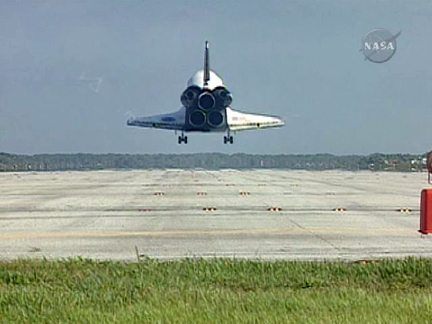
The shuttle Atlantis, seconds away from touchdown on
runway 33. (Credit: NASA TV)
By William Harwood
CBS News/Kennedy Space Center
The following copy originally was posted on the Current Mission space page at http://cbsnews.com/network/news/space/current.html. Comments, suggestions and corrections welcome!
TABLE OF CONTENTS
09:00 AM, 5/26/10, Update: Shuttle Atlantis returns to Earth after final planned mission (UPDATED at 4:05 PM with Nelson letter to Obama calling for additional flight by Atlantis)
The shuttle Atlantis closed out its 32nd and final planned mission with a smooth Florida landing Wednesday, wrapping up a quarter century of service with a successful space station assembly mission.
Approaching from the south, commander Kenneth Ham took over manual control at an altitude of 50,000 feet above the spaceport and guided Atlantis through a 320-degree right turn to line up on runway 33.

The shuttle Atlantis, seconds away from touchdown on
runway 33. (Credit: NASA TV)
Diving at a steep 21-degree angle, Ham pulled the nose up, pilot Dominic "Tony" Antonelli deployed the main landing gear and Atlantis settled to a tire-smoking, on-time touchdown at 8:48:11 a.m. EDT.
"And Houston, Atlantis, we have wheels stopped," Ham radioed after Atlantis rolled to a stop.
"Hock, that landing was something that your Air Force crewmates should have really been proud of, that looked pretty sweet," astronaut Charles Hobaugh, a Marine, joked from mission control.
"For you and your crew, that was a suiting end to an incredible mission," he said. "I'm sure the station crew members hated to see you leave, but we're glad to have you back. You guys executed flawlessly and not only that, you had a great time doing it. That was very evident from the ground. Everybody down here really enjoyed working with you."
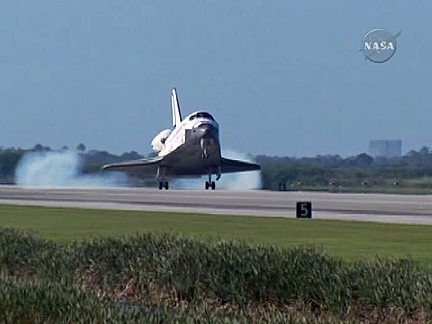
Atlantis touches down to end its final planned mission.
(Credit: NASA TV)
Mission duration was 11 days, 18 hours, 28 minutes and two seconds for a voyage spanning 186 complete orbits and 4.9 million miles since blastoff May 14 from nearby pad 39A.
Ham, Antonelli, flight engineer Michael Good, Stephen Bowen, Piers Sellers and Garrett Reisman joined NASA managers and engineers on the runway for a traditional walk-around inspection before heading back to crew quarters for reunions with friends and family members. All six were scheduled to fly back to Houston Thursday.
"It's a shame," Antonelli said later. "From the condition we brought her back in, she is so ready to get stacked and back out to the launch pad. You can tell that's where she wants to be."
Touchdown marked a bittersweet moment for scores of engineers and technicians awaiting Atlantis' return. With only two flights remaining on NASA's manifest, every flight now means a final voyage for one of the agency's three space shuttles.
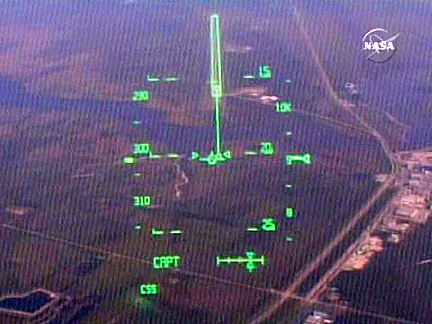
The view through pilot Dominic Antonelli's heads-up display
as Atlantis lined up on runway 33. (Credit: NASA TV)
Discovery is up next, scheduled for launch in September or October, followed by Endeavour late this year or early next on what is currently planned as the shuttle program's final mission.
While Atlantis is not scheduled to fly again, it will be processed for launch on a possible rescue mission if Endeavour experiences a major problem that might prevent a safe re-entry.
NASA managers are holding out hope the Obama administration will approve a final flight for Atlantis to take advantage of an external tank and booster set that otherwise would go to waste.
By launching with a reduced crew of four, a rescue flight would not be needed because the astronauts could seek safe haven aboard the space station and use Russian Soyuz capsules for eventual return to Earth.
A few hours after Atlantis landed, Sen. Bill Nelson, a Florida Democrat, released a letter to President Obama "to inform you of my intention to include language authorizing an additional space shuttle flight" in the fiscal 2011 budget.
"The new mission, STS-135, would be flown with a minimum crew of four astronauts and would provide critical spare parts and logistics for long-term ISS operations," Nelson wrote. "The mission would be planned for the summer of 2011 and would mark the last flight of the space shuttle program."
Along with helping resupply the space station, an additional flight by Atlantis "will allow us to more smoothly transition the workforce in Florida and Texas from the space shuttle program to the vision you've set for NASA's future," Nelson wrote. "It will also guarantee U.S. access to space for a longer period of time, and thereby help to close the spaceflight gap until a new domestic capability is provided.
"Last but not least, it will reduce risk to the station should a major component fail and need to be replaced before STS-135 is flown."
First launched in October 1985, Atlantis flew five military missions, made seven flights to the Russian Mir space station and 11 to the International Space Station. It launched two planetary probes - Magellan to Venus and Galileo to Jupiter - deployed the Compton Gamma Ray Observatory and visited the Hubble Space Telescope for a final overhaul last year.
"It's a real honor to be among the 191 crew members that have flown on Atlantis in her over 300 days in orbit, 120 million miles," Bowen said. "Atlantis is actually named after a ship of research and discovery from a place I happened to study, Woods Hole Oceanographic Institute. And she has definitely lived up to her name."
Said Sellers: "I hope that when she lands successfully, that she goes somewhere and gets the respect she deserves as a ship of exploration. People like to visit ships like the Constellation, the Constitution, see where they've been and what they've done. And Atlantis is one of that line."
During a week of docked operations at the International Space Station, the astronauts installed a new Russian module and carried out three spacewalks to install a backup Ku-band antenna, a robot arm equipment mounting platform and six new solar array batteries.
They also delivered some three tons of supplies and 1,300 pounds of fresh water generated by the shuttle's fuel cells.
With Atlantis back on the ground, the space station crew is gearing up for the upcoming departure of Expedition 23 commander Oleg Kotov, NASA flight engineer Timothy Creamer and Japanese astronaut Soichi Noguchi, who are wrapping up six months in space.
Kotov, Creamer and Noguchi are scheduled to land in Kazakhstan aboard the Soyuz TMA-17 spacecraft around 11:27 a.m. EDT on June 1. They will be replaced aboard the station by Douglas Wheelock, Shannon Walker and cosmonaut Fyodor Yurchikhin, scheduled for launch aboard the Soyuz TMA-19 spacecraft around 5:35 p.m. on June 15.
5:40 AM, 5/26/10, Update: Shuttle payload bay doors closed for entry
After resolving an issue with the shuttle's re-entry cooling system, the Atlantis astronauts closed the ship's payload bay doors just before 5:30 a.m. EDT. The crew is setting up for a deorbit rocket firing around 7:42 a.m. and a landing at the Kennedy Space Center at 8:48 a.m.

Weather radar showing off-shore showers near the Kennedy
Space Center. (Credit: NASA TV)
There are no technical problems of any significance aboard Atlantis, but the weather remains a concern. Forecasters say conditions seem to be trending in the right direction, with off-shore rain showers moving away to the southeast.
The official forecast still calls for a chance of showers within 30 nautical miles of the shuttle's runway, but flight controllers are hopeful the weather will cooperate for an on-time landing.
4:00 AM, 5/26/10, Update: Astronauts prepare for landing
Keeping tabs on the weather, the Atlantis astronauts are preparing for re-entry and landing today at the Kennedy Space Center to close out the shuttle's 32nd and final flight.
Commander Kenneth Ham and his five crewmates have two Florida landing opportunities, the first around 8:48:14 a.m. EDT and the second at 10:22:58 a.m. Forecasters are predicting a chance for showers within 30 nautical miles of the runway for both opportunities, a violation of NASA's flight rules, and brisk winds out of the northwest.
But so far, off shore showers are staying out over the water and flight controllers are cautiously optimistic about getting Atlantis back to Earth later this morning.
"You got any advance intel on how the moisture's looking at the Cape?" Ham asked early today.
"Well, as you can imagine, we've been staring at the same radar screen for a couple of hours," astronaut Charles Hobaugh replied from mission control in Houston. "And it's actually looking pretty favorable. There are some spotty showers that are out over the water that are north, headed south, a chance of showers within 30 miles, but we think we'e got a pretty good fighting chance."
"Okey doke. 50-50," Ham quipped.
"That's right. Hopefully we're on the good side of that 50."
The first landing opportunity calls for a deorbit rocket firing at 7:41:59 a.m., a three-minute 10-second burn using the shuttle's twin orbital maneuvering system rockets to slow the craft by about 233 mph.
After a half hour free fall, Atlantis would plunge back into the discernible atmosphere 76 miles above the south Pacific Ocean at 8:16 a.m. The flight path would carry the ship across Central America and western Cuba before a steep descent up the Florida peninsula to the Kennedy Space Center.
Taking over manual control at an altitude of about 50,000 feet above the spaceport, the current plan calls for Ham to guide Atlantis through a sweeping 317-degree right overhead turn to line up on runway 33.
If the weather prevents an on-time descent, Ham, pilot Dominic "Tony" Antonelli and their crewmates - flight engineer Michael Good, Stephen Bowen, Piers Sellers and Garrett Reisman - can try again one orbit later.
The second opportunity requires a deorbit rocket firing around 9:17:24 a.m., setting up a landing at 10:22 a.m.
Atlantis has enough on-board supplies to remain in orbit until Saturday in a worst-case scenario. As a result, NASA is not staffing its backup landing site at Edwards Air Force Base, Calif., Wednesday or Thursday. If Atlantis isn't back on the ground by Thursday, however, Edwards will be staffed for a Friday attempt.
Here are timelines for both Wednesday landing opportunities at the Kennedy Space Center (in EDT; best viewed with fixed-width font):
Opportunity No. 1: Rev. 186 Deorbit to KSCDeorbit ignition: 07:41:59 AM (dV: 233 mph; dT: 3:10) Crossrange: 679 miles Range from atmospheric entry to KSC: 5,021 miles Turn angle: 317-degree right turn to runway 33 Landing: 08:48:14 AM

Ground tracks for the shuttle Atlantis' first landing opportunity
Wednesday. (Credit: NASA TV)
EDT...........EVENT 12:20 AM......Crew wakeup 03:41 AM......Begin deorbit timeline 03:56 AM......Radiator stow 04:06 AM......Mission specialists seat installation 04:12 AM......Computers set for deorbit prep 04:16 AM......Hydraulic system configuration 04:41 AM......Flash evaporator cooling system checkout 04:47 AM......Final payload deactivation 05:01 AM......Payload bay doors closed 05:11 AM......Mission control 'go' for OPS-3 05:21 AM......OPS-3 entry software transition 05:46 AM......Entry switch list verification 05:56 AM......Deorbit maneuver update 06:01 AM......Crew entry review 06:16 AM......Commander, pilot don entry suits 06:33 AM......Inertial measurement unit alignment 06:41 AM......Commander, pilot strap in; others don suits 06:58 AM......Shuttle steering check 07:01 AM......Hydraulic system prestart 07:08 AM......Toilet deactivation 07:21 AM......Mission control 'go' for deorbit burn 07:27 AM......Astronauts strap in 07:36 AM......Single hydraulic power unit start 07:41:59 AM...Deorbit ignition 07:45:09 AM...Deorbit burn complete 08:16:28 AM...Entry interface 08:21:26 AM...1st roll command to left 08:34:47 AM...1st roll left to right 08:35:14 AM...C-band radar acquisition 08:41:43 AM...Velocity less than mach 2.5 08:43:56 AM...Velocity less than mach 1 08:44:09 AM...Right turn to runway 33 08:48:14 AM...LandingOpportunity No. 2: Rev. 187 Deorbit to KSC
Deorbit ignition: 09:17:24 AM (dV: 233 mph; dT: 3:10) Crossrange: 360 miles Range from atmospheric entry to KSC: 5,055 miles Turn angle: 280-degree right turn to runway 33 Landing: 10:22:58 AM

Ground tracks for the shuttle Atlantis' second landing opportunity
Wednesday. (Credit: NASA TV)
EDT...........EVENT 08:57 AM......MCC 'go' for deorbit burn 09:03 AM......MS seat ingress 09:12 AM......Single APU start 09:17:24 AM...Deorbit ignition 09:20:34 AM...Deorbit burn complete 09:51:15 AM...Entry interface 09:56:11 AM...1st roll command to right 10:06:31 AM...1st right to left roll reversal 10:09:58 AM...C-band radar acquisition 10:16:28 AM...Velocity less than mach 2.5 10:18:41 AM...Velocity less than mach 1 10:19:12 AM...Right turn to runway 33 10:22:58 AM...Landing
11:30 AM, 5/25/10, Update: Flight director hopeful about '50-50' landing weather
The shuttle Atlantis is in good shape and ready for re-entry and landing Wednesday, entry Flight Director Tony Ceccacci told reporters Tuesday. While a marginal "50-50" forecast raises the possibility of a waveoff, Ceccacci said conditions are expected to improve as the week wears on.
"Basically, there's a chance of showers within a 30-mile circle," Ceccacci said. "You all know it's KSC, so it's a 50-50 chance no matter what the forecast says.
"One of the good things is, we've been watching the trends for a while and they're trending favorably. So our hope is when we come in tomorrow morning, things will still be trending in a good direction and we won't have to work it that hard. But again, it's KSC and we'll get what we get when we get there in the morning.
Assuming the weather cooperates, commander Kenneth Ham and pilot Dominic "Tony" Antonelli will fire Atlantis' twin braking rockets for three minutes and 10 seconds starting at 7:41:49 a.m. EDT, slowing the ship by about 233 mph to drop it out of orbit.
After a half-hour free fall, Atlantis will enter the discernible atmosphere over the south Pacific Ocean around 8:16 a.m., cross high above Central America and Cuba and then descend up the Florida peninsula to a landing on runway 33 at the Kennedy Space Center. Touchdown is expected around 8:48:14 a.m.
A second landing opportunity is available one orbit later, with a deorbit burn at 9:17:24 a.m. and landing around 10:22:58 a.m. Two more Florida opportunities are available Thursday, the first at 9:13 a.m. and the second at 10:48 a.m.
The Atlantis astronauts have enough on-board supplies to remain in orbit until Saturday in a worst-case scenario. But the final day is normally reserved to handle technical problems, not the weather. As a result, NASA's backup landing site at Edwards Air Force Base, Calif., will be staffed for a possible landing on Friday if Atlantis hasn't made it back to Florida by then.
"As far as the landing strategy, with the end-of-mission-plus-three (consumables) and the current forecast, tomorrow we'll be trying KSC only and if for some reason we have to wave off, the plan is KSC only on Thursday," Ceccacci said.
The forecast for Wednesday at the Kennedy Space Center calls for a chance of showers within 30 nautical miles of the shuttle runway - a violation of NASA's flight rules - scattered clouds at 3,000 feet and broken decks at 10,000 feet and 25,000 feet. Winds are expected out of the northwest, right down the runway, at 12 knots with gusts to 18.
The forecast for Thursday calls for a chance of showers within NASA's safety zone, but lighter winds and less cloud cover. By Friday, conditions are expected to be acceptable at both Kennedy and Edwards.
5:10 AM, 5/25/10, Update: Astronauts test re-entry systems, pack for landing Wednesday (UPDATED at 5:30 a.m. with weather discussion)
The Atlantis astronauts tested the shuttle's re-entry systems early Tuesday and packed for a Florida landing Wednesday, weather permitting, to close out a successful space station assembly mission, the orbiter's 32nd and final planned flight.
Commander Kenneth Ham and his five crewmates have two opportunities to land at the Kennedy Space Center Wednesday, the first at 8:48:14 a.m. EDT and the second, one orbit later, at 10:22:58 a.m.
But the Spaceflight Meteorology Group at the Johnson Space Center is predicting marginal weather, with low clouds and a chance for showers within 30 nautical miles of the landing strip that could cause problems. More of the same is expected Thursday and Friday.
The forecast for NASA's backup landing site at Edwards Air Force Base, Calif., calls for a slight chance of showers Wednesday, but acceptable weather Thursday and Friday.
Atlantis has enough on-board supplies to remain in orbit until Saturday in a worst-case scenario. But NASA reserves the final day to handle problems with the shuttle, not the weather. If Atlantis isn't down by Thursday, entry Flight Director Tony Ceccacci likely would order a landing Friday, on one coast or the other.
"Just looking ahead at the weather tomorrow, it's looking pretty favorable," astronaut Charles "Scorch" Hobaugh radioed from mission control. "They are carrying a chance of rain showers within 30 miles, they've been watching it today, and a low that's about 600 miles off shore will move a little tomorrow and hopefully keep some of those showers at bay. It's just something we'll have to watch tomorrow. As you know, it's always questionable no matter what.
"The winds tomorrow will be moderate strength right down (runway) 33. Right now, if we were to call it, it would be a close-in aim point to 33 and we also would have the option to go land on (runway) 15 with a rather large speedbrake. So early projection is we think we've got a pretty good fighting chance, but of course, we'll be watching it."
"OK, Scorch, we really appreciate the update," Ham replied. "Sounds like it's 50-50, either we land there or we don't. We'll take either end of the runway, whichever one you prefer. I guess if you think it might rain, we'll land on 15 and coast all the way to the OPF (Orbiter Processing Facility)."
"We like your plan," Hobaugh said. "The other thing, we'll reassess tomorrow if necessary, hopefully you won't have to get that far, but there is that thought right now that we'll just plan KSC the first two days and Friday will be our all-the-way-around, we'll-get-you-down-no-matter-what type day. So we'll reassess that tomorrow if we get to that point. But like I said, we hope to get
you back tomorrow."Ceccacci plans to brief reporters on his landing strategy at 10 a.m.
Ham, pilot Dominic "Tony" Antonelli and flight engineer Michael Good activated one of Atlantis' hydraulic power units early Tuesday, exercised the ship's aerosurfaces and test fired maneuvering jets in a standard pre-landing checkout. There were no problems of any significance.
Their crewmates - Stephen Bowen, Piers Sellers and Garrett Reisman - packed up loose gear and other equipment and readied Atlantis for entry. A final round of media interviews is on tap at 8:10 a.m. The shuttle's Ku-band antenna will be stowed at 1:10 p.m.
Here is an updated timeline of today's activity (in EDT and mission elapsed time; includes revision I of the NASA television schedule; best viewed with fixed-width font):
EDT........DD...HH...MM...EVENT 12:20 AM...10...10...00...STS crew wakeup 03:35 AM...10...13...15...Wing leading edge sensor deactivation 03:40 AM...10...13...20...Flight control system checkout 04:00 AM...10...13...40...Cabin stow begins 04:50 AM...10...14...30...Reaction control system hotfire 05:05 AM...10...14...45...PILOT simulator landing practice 06:40 AM...10...16...20...Crew choice downlink 07:40 AM...10...17...20...Deorbit review 08:10 AM...10...17...50...PAO event 08:30 AM...10...18...10...Crew meal 09:40 AM...10...19...20...L-1 comm check 09:50 AM...10...19...30...Cabin stow resumes 09:50 AM...10...19...30...Ergometer stow 10:00 AM...10...19...40...Mission status briefing on NTV 11:50 AM...10...21...30...Entry stow 12:50 PM...10...22...30...Laptop computer stow (part 1) 01:10 PM...10...22...50...Ku-band antenna stow 04:20 PM...11...02...00...Crew sleep begins 05:00 PM...11...02...40...Daily highlights reel on NTV 08:00 PM...11...05...40...HD crew highlights on NTV
4:30 AM, 5/24/10, Update: Heat shield inspection in work (UPDATED at 11:10 a.m. with mission status briefing)
The Atlantis astronauts completed a final inspection of the shuttle's carbon composite nose cap and wing leading edge panels Monday to make sure the ship's most critical heat shield components were not damaged by orbital debris of micrometeoroids since a similar inspection the day after launch.
The crew also cleaned and stowed spacesuits used during three space station assembly spacewalks in preparation for landing Wednesday at the Kennedy Space Center.
"We're at the end of our last shift down here," lead Flight Director Mike Sarafin radioed the crew earlier Monday. "The leads and all the folks are just ecstatic with the work that you've done. I can personally say it's been a pleasure working with you guys and watching you work, and I've learned a lot from you guys.
"We did some math here on the ground and by the time you get to KSC at end of mission on your 186th orbit, the odometer on Atlantis will have crossed 120 million miles. It's because of guys like you, and the men and women who built Atlantis and maintain her and fly her and her sister ships, that we're able to peacefully explore, and we're glad to have folks like that. We're proud of all of you, and we look forward to the return of our fair ship Atlantis, as well as your return. We'll see you on the ground."
"Mike, those are some pretty cool words there," Atlantis commander Kenneth Ham replied. "I'm not even going to try to match them. A hundred and twenty million (miles) is pretty darn awesome in my mind. We're sad to see you guys leaving us. ... Thanks for all the help and support from you and your team. We've been having a ball on your behalf. And hopefully we'll see you on the runway in a few days."
Atlantis, completing its 32nd and final planned flight, will cross the 120-million-mile mark during the 178th orbit of its current mission around 12:30 a.m. EDT Wednesday, just after the crew wakes up to begin landing preparations.
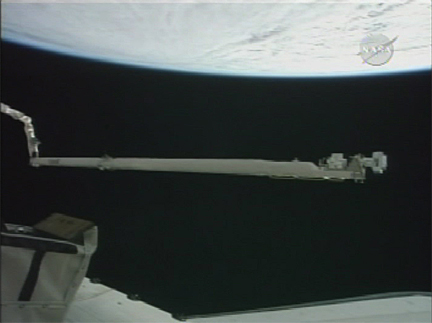
The shuttle's heat shield inspection boom, ready for a final look
at Atlantis' nose cap and wing leading edge panels. (Credit: NASA TV)
During the first heat shield inspection the day after launch, the pan-and-tilt mechanism on the end of the shuttle's robot arm inspection boom hung up on a cable, forcing the crew to used a secondary fixed camera that could not be positioned as precisely. The crew fell behind and portions of the left wing leading edge were not fully examined.
The space station crew helped out later, taking additional pictures with a powerful telephoto lens during the shuttle's approach to the lab complex. Additional photos were taken during one of the crew's spacewalks. Mission managers ultimately concluded the heat shield was in good shape and no additional robot arm inspections were needed.
During the crew's second spacewalk, astronaut Stephen Bowen freed the jammed cable and used a wire tie to keep it out of the pan-and-tilt mechanism. For today's inspection, the normal sensor suite was used to examine the wing leading edge panels and the shuttle's nose cap, which experience the most extreme heating during re-entry.
The four-hour inspection procedure began around 4:30 a.m., well ahead of schedule.
"We performed the normal inspection procedures to mitigate the orbital debris risk associated with any spaceflight," Sarafin said. "The crew performed the late inspection with the pan-and-tilt unit we had problems with earlier in the mission. ... It worked great throughout the inspection.
"Once we get all that imagery (on the ground), the analysts will review that and over the course of the next day provide a thumbs up on the heat shield of Atlantis," he said. "We expect an answer by the crew's midday meal tomorrow. Once we get that answer, the final clearance for re-entry will be given."

The International Space Station flies above Florida and the East
Coast Monday. (Credit: NASA TV)
The astronauts plan to spend the day Tuesday checking out re-entry systems and packing up. Landing back at the Kennedy Space Center is targeted for 8:48 a.m. Wednesday. The forecast calls for a chance of showers in the area that could cause problems, but Atlantis has enough on-board supplies to remain in orbit until Saturday if worse comes to worse.
"At this point in the mission, all the robotic activities are complete," Sarafin said. "The orbiter boom sensor system and the shuttle's robotic arm are put away in their landing configuration. The checkouts for landing will proceed tomorrow under the guidance of entry Flight Director Tony Ceccacci.
"Tomorrow, the crew will power up one of the auxiliary power units that provides hydraulic power to the aerosurfaces on Atlantis and we'll check those out, along with some navigational aids. Once those are complete, the crew will proceed into some cabin stow activities and Atlantis will be ready to come home."
Here is an updated timeline of today's activity (in EDT and mission elapsed time; includes revision H of the NASA television schedule; best viewed with fixed-width font):
EDT........DD...HH...MM...EVENT 05/24 12:50 AM...09...10...30...Crew wakeup 03:55 AM...09...13...35...Spacesuit install 04:25 AM...09...14...05...EVA unpack and stow 04:30 AM...09...14...10...Starboard wing survey (approximate) 06:10 AM...09...15...50...Nose cap survey (approximate) 08:00 AM...09...17...40...Port wing survey (approximate) 08:40 AM...09...18...20...Crew meal 10:00 AM...09...19...40...Mission status briefing on NTV 11:25 AM...09...21...05...Inspection boom (OBSS) berthing 12:00 PM...09...21...40...Post-MMT briefing on NTV 12:25 PM...09...22...05...Shuttle robot arm (SRMS) powerdown 02:36 PM...10...16...00...Orbit adjust burn 04:20 PM...10...02...00...STS crew sleep begins 05:00 PM...10...02...40...Daily highlights reel on NTV 08:00 PM...10...05...40...HD crew highlights on NTV
12:20 PM, 5/23/10, Update: Shuttle Atlantis undocks from space station
The shuttle Atlantis undocked from the International Space Station Sunday, wrapping up a week of assembly work to install a new Russian module loaded with 1.5 tons of NASA cargo, a backup Ku-band antenna, six new solar array batteries and more than a ton of other equipment and supplies.
With pilot Dominic "Tony" Antonelli at the controls, the shuttle's payload bay docking mechanism disengaged its counterpart on the space station's forward port at 11:22 a.m. EDT as the two spacecraft sailed 220 miles above the Southern Ocean southwest of Perth, Australia.
"Houston and station, from Atlantis, physical separation," shuttle commander Kenneth Ham radioed.
"Space shuttle Atlantis, departing," flight engineer Tracy Caldwell Dyson said, ringing the ship's bell in the Harmony module as the shuttle drifted away.
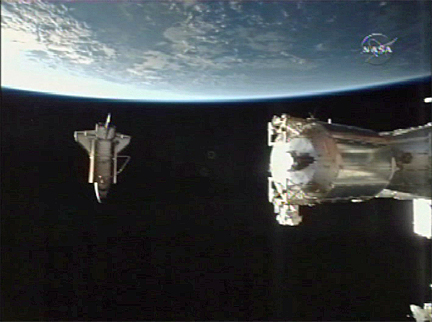
The shuttle Atlantis leaves the International Space Station.
(Credit: NASA TV)
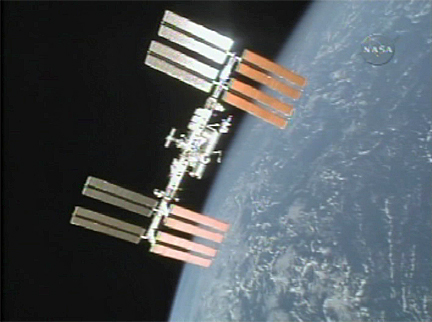
The International Space Station during Atlantis' fly around.
(Credit: NASA TV)
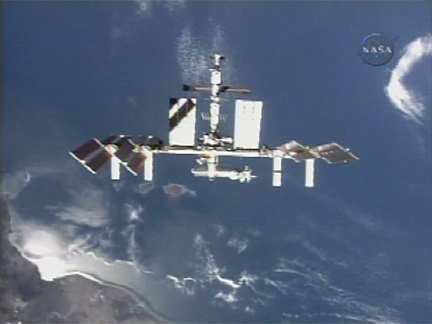
The space station passes above the Mexican coast. (Credit: NASA TV)
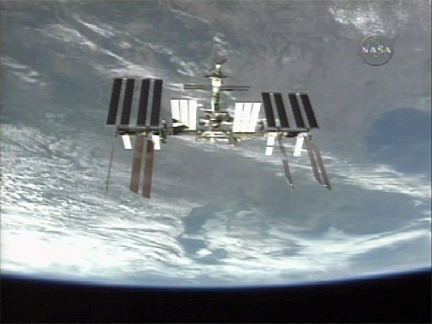
The space station passes above the great lakes. (Credit: NASA TV)
"Atlantis, station is now in attitude control," flight engineer Timothy Creamer radioed a few moments later. "Hock, I've gotta tell you, you guys were consummate professionals with a great sense of humor, we were so glad to see you, loved working with you. See you soon, brother. Stay safe."
"Copy all, T.J., and same comments right back at you, brother," Ham replied.
Atlantis slowly pulled away to a point about 400 feet directly in front of the station where Antonelli began a 360-degree photo-documentation loop around the lab complex.
"I get to fly the separation," he said before launch. "I'll do a one-lap fly around of the space station. We train that a lot in the sim. It turns out the view is much better for real and the flying is more fun when you can actually feel the vehicle moving around."
The astronauts beamed down spectacular views of the space station as the shuttle looped up, over and behind the lab complex as the two spacecraft sailed above Mexico and the central United States on a southwest-to-northeast trajectory.
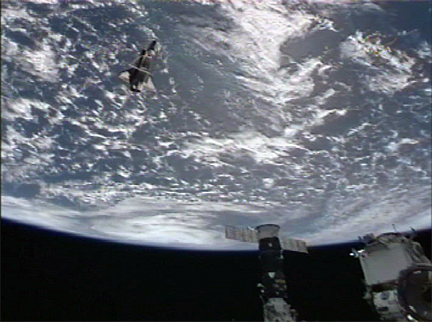
Atlantis passes above the North Atlantic Ocean. (Credit: NASA TV)
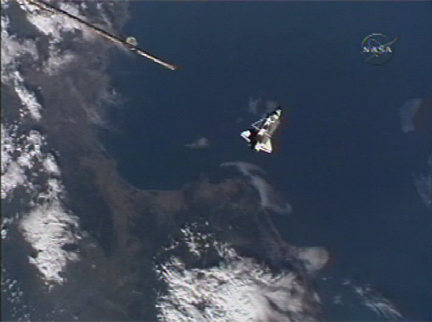
Atlantis crosses the southeast coast of Spain. (Credit: NASA TV)
During a week of docked operations, the astronauts installed the 17,760-pound Russian mini-research module known as Rassvet and staged three spacewalks last Monday, Wednesday and Friday to install a backup Ku-band antenna system, an equipment mounting platform and to replace six batteries in the port-6 solar array.
The astronauts also delivered 2,192 pounds of equipment and supplies that were carried up in the shuttle's crew cabin, along with 1,300 pounds of fresh water generated by the ship's fuel cells. Some 1,763 pounds of equipment and experiment samples were transferred from the station to the shuttle's crew cabin for the trip home.
Altogether, the Atlantis astronauts delivered 28,792 pounds of equipment and supplies to the space station. Total cargo being carried back to Earth, including the old P6 batteries and the cargo pallet holding them in place, adds up to 8,229 pounds.
The Atlantis astronauts plan to carry out a final heat shield inspection Monday before packing up and testing the shuttle's re-entry systems Tuesday. Landing back at the Kennedy Space Center is targeted for 8:48 a.m. Wednesday morning, weather permitting.
Three hours before undocking, the two crews gathered for a brief farewell ceremony in the forward Harmony module.
"This is time when we have to say goodbye to our friends, our colleagues, the excellent crew of shuttle Atlantis that did an excellent job performing three EVAs, installing the new Russian module, having good fun, enjoying living on station and working in space," said Expedition 23 commander Oleg Kotov.
"They show good example of friendship, professionalism and classic attitudes in their behavior. ... So again, thank you Ken, for excellent job. We enjoyed working with you."
"Well Oleg, we are one happy shuttle crew," Ham replied. "And we are happy because of all of your effort, too. I think through our entire docked timeframe here we were a 12-person crew that operated together. And that was the only way we got everything done. ... So we are happy. But this one is to friends we're going to leave behind, and new friends that we've made, close friends. We've had a great time together.
"We are going to close the hatch shortly and we're going to depart," Ham said. "And of course, as always, it'll be a little bit sad. But we'll see you all on the surface of planet Earth again soon."
Kotov, Creamer and Japanese astronaut Soichi Noguchi plan to follow the Atlantis astronauts back to Earth in nine days, departing June 1 (U.S. time) aboard the Soyuz TMA-17 capsule for a landing in Kazakhstan to close out a six-month stay in space.
Cosmonaut Alexander Skvortsov will take command from Kotov, remaining aboard the station with Caldwell Dyson and Mikhail Kornienko as the Expedition 24 crew. They will be joined by cosmonaut Fyodor Yurchikhin, Douglas Wheelock and Shannon Walker, who are scheduled for launch aboard the Soyuz TMA-19 spacecraft on June 15.

Station commander Oleg Kotov, left, shakes hands with shuttle
commander Ken Ham during a brief departure ceremony.
(Credit: NASA TV)

Flight engineer Tracy Caldwell Dyson prepare to close the hatch
between shuttle Atlantis and the space station. (Credit: NASA TV)

The combined shuttle-station crew hold a news conference before
undocking. (Credit: NASA TV)
5:00 AM, 5/23/10, Update: Atlantis astronauts prep for undocking
The Atlantis astronauts worked early Sunday to complete a final few equipment transfers from the International Space Station before a crew news conference, a final joint meal with the station crew and undocking to wrap up a successful three-spacewalk assembly mission.
"They're going to start with final transfer activities and get the last remaining cargo off the International Space Station that they plan to return in Atlantis' middeck," shuttle Flight Director Mike Sarafin said Saturday. "They'll transfer the suits they used to perform their spacewalks back into Atlantis and we'll perform a final verification, make sure all the science and transfers are back across the hatch and ready for return.
"Around midday, they'll close hatches, perform some leak checks and then if all goes as planned, will undock Atlantis from the International Space Station. Following undock, pilot Tony Antonelli will perform a one-lap fly around, a full 360-degree rotation around the exterior of the International Space Station at a range of 400 to 600 feet. We should get some outstanding views for engineering data as well as a good view of the (Russian) Rassvet module that was recently installed."
The astronauts planned to participate in a joint crew news conference aboard the station at 6:25 a.m. EDT, followed by lunch and a brief farewell ceremony at 8:10 a.m. If all goes well, Atlantis will undock from the space station at 11:22 a.m. to wrap up a busy week of assembly work.
This is Antonelli's second flight as pilot and his second time to manually guide a space shuttle through a loop around the station.
"I get to fly, so thatŐs the most important part for me," he said before launch in a NASA interview. "I get to fly the separation. ... I'll do a one-lap fly around of the space station. We train that a lot in the sim. It turns out the view is much better for real and the flying is more fun when you can actually feel the vehicle moving around.
"It'll be crowded on the flight deck. There are only six of us, but everybody that can fit a camera in the window will want to either take a peek and/or take a picture and so it will be crowded in there. But (I'm) really looking forward to that. We'll undock in the afternoon. We'll do our fly around and then it'll be almost dinner and bedtime and we can just talk about what a great afternoon it was."
Here is an updated timeline of today's activity (in EDT and mission elapsed time; includes revision H of the NASA television schedule; best viewed with fixed-width font):
EDT........DD...HH...MM...SS...EVENT 05/23 12:50 AM...08...10...30...00...Crew wakeup 02:20 AM...08...12...00...00...ISS daily planning conference 03:55 AM...08...13...35...00...Middeck transfers 05:05 AM...08...14...45...00...Rendezvous tools checkout 06:05 AM...08...15...45...00...Joint crew photo 06:25 AM...08...16...05...00...Joint crew news conference 07:10 AM...08...16...50...00...Joint crew meal 08:10 AM...08...17...50...00...Farewell ceremony 08:25 AM...08...18...05...00...Hatches closed 08:55 AM...08...18...35...00...ODS leak checks 08:55 AM...08...18...35...00...Centerline camera install 09:50 AM...08...19...30...00...Group B computer powerup 09:54 AM...08...19...34...00...ISS in prox ops mode 10:05 AM...08...19...45...00...Start maneuver to undock attitude 10:10 AM...08...19...50...28...Sunrise 10:34 AM...08...20...14...00...Orbiter/ISS in undock attitude 10:38 AM...08...20...18...39...Noon 11:05 AM...08...20...45...00...Russian arrays feathered 11:06 AM...08...20...46...50...Sunset 11:22 AM...08...21...02...00...UNDOCKING 11:22 AM...08...21...02...05...Maintain corridor 11:23 AM...08...21...03...00...Initial separation 11:23 AM...08...21...03...40...ISS holds current attitude 11:27 AM...08...21...07...00...Range = 50 ft: reselect -x jets 11:29 AM...08...21...09...00...Range = 75 ft: lowz 11:42 AM...08...21...21...57...Sunrise 11:51 AM...08...21...31...00...Start flyaround at 400 ft 11:52 AM...08...21...32...00...Russian arrays resume tracking 12:00 PM...08...21...40...30...Range = 600 feet 12:02 PM...08...21...42...30...Shuttle directly above ISS 12:10 PM...08...21...50...08...Noon 12:14 PM...08...21...54...00...Shuttle directly behind ISS 12:24 PM...08...22...04...33...Start - sun in win fov (1) 12:25 PM...08...22...05...30...Shuttle directly below ISS 12:36 PM...08...22...16...45...Start - sun in win fov (2) 12:37 PM...08...22...17...00...Shuttle directly ahead of ISS 12:37 PM...08...22...17...00...Sep 1 (1.5 fps radial burn) 12:38 PM...08...22...18...20...Sunset 12:50 PM...08...22...30...00...Range > 2000 ft 12:54 PM...08...22...34...00...Range > 3000 ft 01:05 PM...08...22...45...00...Sep 2 (1.5 fps posigrade burn) 01:05 PM...08...22...45...00...Group B computer powerdown 01:05 PM...08...22...45...00...Laptop computer reconfig 01:30 PM...08...23...10...00...Video playback 02:05 PM...08...23...45...00...US arrays resume tracking 04:00 PM...09...01...40...00...Mission status briefing on NTV 04:50 PM...09...02...30...00...ISS crew sleep begins 04:50 PM...09...02...30...00...STS crew sleep begins 05:00 PM...09...02...40...00...Daily highlights 07:00 PM...09...03...40...00...HD crew highlights
6:05 AM, 5/22/10, Update: Cargo pallet returned to shuttle; crew gets afternoon off (UPDATED at 12:15 p.m. with mission status briefing)
Astronauts Piers Sellers and Garrett Reisman, operating the space station's robot arm, moved a cargo pallet loaded with old solar array batteries back to the shuttle Atlantis' cargo bay Saturday for return to Earth.
Working at the robotics work station inside the station's multi-window cupola, Sellers and Reisman began moving the integrated cargo carrier, or ICC, back to the shuttle just after 4:30 a.m., completing the operation at 5:50 a.m.
For launch, the ICC was loaded with a backup Ku-band dish antenna, an 8-foot antenna boom, an equipment storage platform and six new batteries to replace outdated power packs in the station's far left solar array.
The antenna, its support boom and the equipment platform were moved to the space station during a spacewalk Monday. The new batteries were installed during spacewalks Wednesday and Friday and the old batteries were bolted to the ICC for return to Earth.
"Today the crew completed all of their primary mission objectives with the return of the integrated cargo carrier and the six old batteries from the port six location of the International Space Station's power channel," said shuttle Flight Director Mike Sarafin.
"So we've got the integrated cargo carrier back in the payload bay, we've got three very successful spacewalks under our belt and the (Russian) Rassvet module has been installed on the International Space Station. So now the mission shifts to returning Atlantis home, hopefully mid next week."
After answering video questions from school kids at 7:40 a.m., the combined 12-member shuttle-station crew shared a joint meal before the Atlantis astronauts enjoyed two and a half hours of off-duty time starting at 11:05 a.m. Crew sleep on tap at 4:50 p.m.
Atlantis is scheduled to undock from the International Space Station around 11:22 a.m. Sunday with landing back at the Kennedy Space Center expected around 8:48 a.m. Wednesday, weather permitting.
Sarafin said the 132nd shuttle mission had been conducted in near flawless fashion with only a few relatively minor glitches. He called attention to a complex set of robot arm procedures using a work station in the station's new multi-window cupola for the first time.
"All the robotics that we worried about leading into this mission were just handled in an exception manner," he said. "Coming into this mission, we talked about nine of the 12 days of this mission were populated with very heavily integrated and choreographed robotics activities.
"Today, the crew of Atlantis and the International Space Station took a few moments to compliment the folks who helped plan all the robotics on this mission as well as the folks who built and delivered the cupola and the robotics work station associated with it. And I'll just second their words that all of that was done in an outstanding manner.
"Canadarm 2 performed in a fantastic fashion," Sarafin said. "It was all over the exterior of the International Space Station this mission, it was reaching down into the payload bay to remove cargo as well as put it back, it moved from the center of the truss back to the Russian segment, over to the port side of the truss and then back to the center of the International Space Station. Again, it was just an outstanding piece of machinery."
Here is an updated timeline of today's activity (in EDT and mission elapsed time; includes revision H of the NASA television schedule):
EDT........DD...HH...MM...EVENT 05/22 01:20 AM...07...11...00...Crew wakeup 02:50 AM...07...12...30...ISS daily planning conference 03:35 AM...07...13...15...SSRMS berths ICC in payload bay 04:55 AM...07...14...35...EVA prep for transfer 05:05 AM...07...14...45...SSRMS maneuver 06:25 AM...07...16...05...EVA transfer to shuttle 07:40 AM...07...17...20...PAO event 08:00 AM...07...17...40...Joint crew meal 09:00 AM...07...18...40...Middeck transfers 10:30 AM...07...20...10...Mission status briefing on NTV 11:05 AM...07...20...45...Shuttle crew off duty 02:00 PM...07...23...40...ISS daily planning conference 04:20 PM...08...02...00...ISS crew sleep begins 04:50 PM...08...02...30...STS crew sleep begins 05:00 PM...08...02...40...Daily video highlights reel 08:00 PM...08...05...40...HD crew highlights
1:25 PM, 5/21/10, Update: Spacewalk No. 3 ends
Astronauts Michael Good and Garrett Reisman carried out a successful six-hour 46-minute spacewalk Friday, completing the replacement of six space station solar array batteries, installing an ammonia coolant jumper and retrieving a robot arm grapple fixture.
The spacewalkers also got around to a few final "get-ahead" tasks, adjusting an insulation blanket on a robot arm extension and restocking external tool boxes.
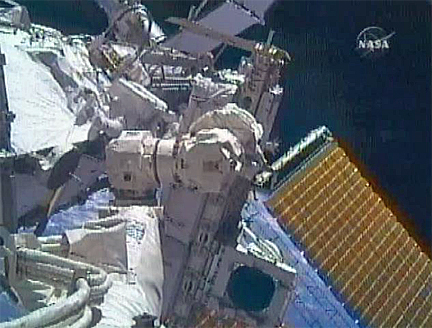
Astronauts Michel Good and Garrett Reisman wrap up battery
replacement work on the far left end of the station's
main power truss. (Credit: NASA TV)
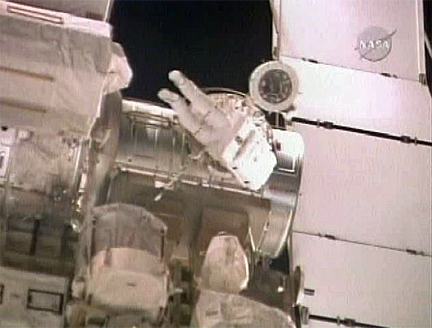
Astronaut Michael Good carries a robot arm grapple fixture to
the Quest airlock. (Credit: NASA TV)
They even found time for a bit of sightseeing before returning to the International Space Station's Quest airlock module, marveling at the view of the Kennedy Space Center and Cape Canaveral from 220 miles up.
"Are we over, like, Bermuda or something?" Reisman asked.
"Yep. The Bahamas," pilot Dominic Antonelli replied from Atlantis' flight deck.
"The Bahamas. Fantastic."
"You can see the Cape if you look back the other way," Antonelli said.
"Oh, I can."
"Runway 15/33 looks pretty clear," someone said.
"Oh, wow," Good exclaimed.
"You can see it?" Reisman asked.
"Yeah. That's cool," Good replied.
"I can see the SLF, I can see the two pads, I can see the skid strip."
"And Houston, we've got the field in site," Antonelli joked.
"Houston copies. We'd rather you not land just yet," astronaut Steve Swanson replied from mission control.
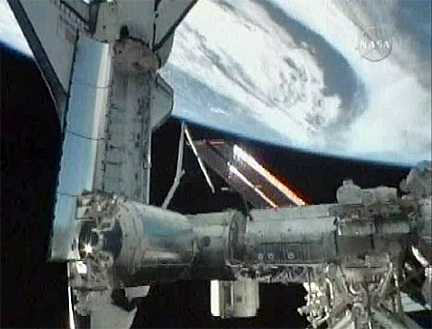
The shuttle-station complex flies over the North Atlantic Ocean
after a third and final spacewalk. (Credit: NASA TV)
The spacewalk began at 6:27 a.m. EDT and ended at 1:13 p.m., boosting the crew's total EVA time through three spacewalks to 21 hours and 20 minutes. Total space station EVA construction time through 146 spacewalks now stands at 914 hours and 53 minutes, or 38.1 days.
"It was three great, fantastic EVAs," Swanson called at the end of the spacewalk. "We appreciate all your work."
9:45 AM, 5/21/10, Update: Battery replacement complete; ammonia jumper installed
Astronauts Michael Good and Garrett Reisman installed an ammonia cooling system jumper between two solar array truss segments Friday and completed final installation of replacement batteries in the International Space Station's left-side P6 solar array. Four 375-pound batteries were installed during a spacewalk Wednesday and the final two were replaced today. The six old batteries that were removed from the truss are now secured on a cargo carrier for return to Earth aboard the shuttle Atlantis. The carrier pallet will be mounted back in the shuttle's cargo bay Saturday.
Good and Garrett currently are cleaning up the P6 worksite before moving on to their next tasks, retrieving a robot arm grapple fixture from Atlantis' cargo bay and adjusting an insulation blanket on a robot arm extension. If time is available, they plan to restock external tool boxes.
There have been no problems of any significance in today's spacewalk and as of 9:45 a.m., the astronauts were about a half hour ahead on their timeline.
6:35 AM, 5/21/10, Update: Spacewalk No. 3 begins
Running ahead of schedule, astronauts Michael Good and Garrett Reisman, floating in the space station's Quest airlock module, switched their spacesuits to battery power at 6:27 a.m. to kick off a planned six-and-a-half-hour spacewalk. They floated out of the airlock a few minutes later to begin the day's work.
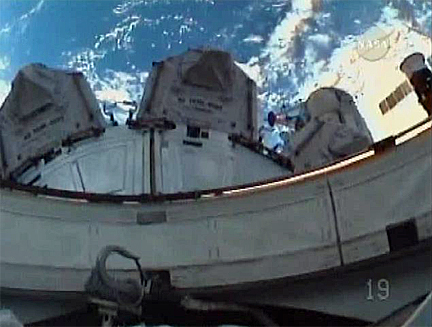
The view from Michael Good's helmet cam, looking out of the
Quest airlock. (Credit: NASA TV)
The first item on the agenda, after setting up tools and tethers, will be to install an ammonia coolant jumper between two solar array truss segments on the left side of the space station.
The astronauts then will begin work to replace a final two batteries in the P6 solar array segment, bolting the old batteries to a cargo carrier anchored to the end of the statin's robot arm. Four batteries were replaced during a spacewalk Wednesday.
After the battery work is complete, the astronauts will reposition an insulation blanket on a robot arm extension and retrieve a grapple fixture from the shuttle Atlantis' payload bay that will be attached to a Russian module during an upcoming spacewalk by the station crew.
05:05 AM, 5/21/10, Update: Astronauts prep for third spacewalk
Astronauts Michael Good and Garrett Reisman are suiting up for a planned six-and-a-half-hour spacewalk today to finish replacing the International Space Station's oldest set of solar array batteries. They also plan to install an ammonia coolant jumper between two power truss segments, retrieve a robot arm grapple fixture and repair insulation on a Canadian robot arm extension.
The spacewalk is scheduled to begin around 6:45 a.m. EDT when Reisman and Good, floating in the station's Quest airlock module, switch their spacesuits to battery power.
This will be the 146th spacewalk devoted to station assembly and maintenance since construction began in 1998, the 10th so far this year and the third and final excursion planned by the Atlantis astronauts. Good, call sign EV0-1, will be making the fourth spacewalk of his career, while Reisman, EV-2, will be making his third.
One of the major objectives of Atlantis' mission was the replacement of six aging batteries in the P6 solar array segment on the far left end of the station's power truss. Four batteries were replaced by Good and Stephen Bowen during a spacewalk Wednesday, one more than called for in the flight plan.
"Because the crew's been so good this mission in getting ahead, we did add a couple of things to (Friday's) EVA," said space station Flight Director Scott Stover. "The first thing they do when they go out, they're going to be installing a jumper that runs between the P4 and P5 truss segments on the space station. ... It's an ammonia jumper, although it's going to be filled with nitrogen so we don't have to worry about any ammonia getting on the suits or anything like that."
The P5 truss segment acts as a spacer between the P4 and P6 solar arrays. The jumper will help complete a path from an inboard ammonia reservoir in the P3 segment to the outboard solar arrays.
"The P6 and the P4 modules both have ammonia cooling systems on there, but the ammonia tanks for the external thermal control system are inside the solar alpha rotary joint," Stover said. "If one of those outboard, P4 or P6, modules develop a leak or need to be refilled with ammonia, we need this jumper to help us with those refill operations. So that's the first thing they're going to do, install a jumper that in the future would be used for refill operations.
"The second thing they're going to do is (go) back to battery ops. They still have two new batteries to install and two old batteries to put onto the ICC (integrated cargo carrier). Plus, that one battery they left temp stowed needs to go back on the ICC. So those activities will finish up all the battery ops."
After that, Good and Reisman will make their way to the base of the station's robot arm where a Canadian hand-like extension known as DEXTRE is mounted. Engineers earlier spotted an insulation blanket that was not in the proper configuration and the astronauts will take a moment to fix that before moving to the shuttle's cargo bay.
"The final scheduled activity is to go down to the payload bay of Atlantis and get what we call a power and data grapple fixture, which is the structure the station arm connects to," Stover said. "It's an extra one we have brought up on Atlantis for planned install on a later EVA on the (Russian) Zarya module. That EVA is currently scheduled for the summer."
A final get-ahead task will be carried out if time is available, replacing tools in external tool boxes that were carried inside the station by previous spacewalkers.
Along with replacing the batteries in the P6 solar array segment, a second major objective of Atlantis' mission was installing a new Russian module known as Rassvet, or mini-research module No. 1. The new compartment was attached to the Earth-facing port of the Zarya module Tuesday and opened up on Thursday.
Entering the module, Expedition 23 commander Oleg Kotov reported seeing what appeared to be metal flakes, or shavings, floating in the air, debris presumably shaken loose during launch. As always when opening a new module, Kotov was wearing goggles and a dust mask as a safety precaution.
"One thing that we did find were some metal flakes, or shavings, that were unexpected," Stover said. "In the one-G environment when it was on the ground you can imagine they hide in the nooks and crannies of the module itself. Now in zero G, they're floating around.
"When the crew entered, we were prepared for it, we made sure they were wearing the protective gear, goggles and dust mask," he said. "They reported seeing the metal flakes, so we had them make sure the (air) scrubbers were running."
The module's hatch was closed overnight and "hopefully the scrubbers will collect all of that debris," Stover said. "When we do go back in, we'll again have them wear the protective equipment just in case there's something floating around in the air."
Here is an updated timeline of today's activity (in EDT and mission elapsed time; includes revision G of the NASA television schedule):
EDT........DD...HH...MM...EVENT 05/21 01:50 AM...06...11...30...STS/ISS crew wakeup 03:00 AM...06...12...40...EVA-3: 14.7 psi repress/hygiene break 03:15 AM...06...12...55...EVA-3: Airlock depress to 10.2 psi 03:40 AM...06...13...20...EVA-3: EVA prep 03:50 AM...06...13...30...ISS daily planning conference 05:10 AM...06...14...50...EVA-3: Spacesuit purge 05:25 AM...06...15...05...EVA-3: Spacesuit prebreathe 06:05 AM...06...15...45...SSRMS cargo pallet move to EVA worksite 06:15 AM...06...15...55...EVA-3: Crew lock depressurization 06:45 AM...06...16...25...EVA-3: Spacesuits to battery power 06:50 AM...06...16...30...EVA-3: Airlock egress/setup 07:05 AM...06...16...45...EVA-3: Setup 07:15 AM...06...16...55...EVA-3: Ammonia jumper install 07:30 AM...06...17...10...EVA-3: P6 battery 5 R&R 08:00 AM...06...17...40...EVA-3: P6 battery E/6 R&R 09:05 AM...06...18...45...EVA-3: P6 battery F R&R 09:40 AM...06...19...20...EVA-3: Install battery on pallet 10:15 AM...06...19...55...EVA-3: P6 cleanup 11:15 AM...06...20...55...EVA-3: Retrieve grapple fixture from cargo bay 11:35 AM...06...21...15...SSRMS moves cargo pallet to solar array truss 12:15 PM...06...21...55...EVA-3: Get aheads 12:20 PM...06...22...00...SSRMS releases cargo pallet 12:40 PM...06...22...20...EVA-3: Cleanup and ingress 01:15 PM...06...22...55...EVA-3: Airlock repressurization 01:25 PM...06...23...05...Spacesuit servicing 02:25 PM...07...05...00...ISS daily planning conference 03:15 PM...07...55...00...EVA tagup 04:00 PM...07...01...40...Mission status briefing on NTV 04:50 PM...07...02...30...ISS crew sleep begins 05:00 PM...07...02...40...SRB launch video 05:20 PM...07...03...00...STS crew sleep begins 06:00 PM...07...03...40...Daily highlights reel 09:00 PM...07...06...40...HD crew highlights
3:00 PM, 5/20/10, Update: Suspended 'metal shavings' reported floating in new Russian module
Initial work inside a new Russian module loaded with supplies and equipment was interrupted Thursday when the space station's commander reported what appeared to be metal shavings floating in the cabin, debris presumably shaken loose during launch aboard shuttle Atlantis.
Expedition 23 commander Oleg Kotov said he was wearing a mask and safety goggles during his initial work in the module and was not in any danger of inhaling the debris or getting it in his eyes. But Russian flight controllers told him to stand down while engineers discussed ways to remove the particulate from the cabin air.
Because of the possibility of suspended debris floating free when a new module is launched into the weightlessness of space, it is standard practice for astronauts and cosmonauts to don safety goggles and surgical masks when opening a new compartment for the first time.
Kotov and his crewmates did just than when the new mini-research module, or MRM, was opened up early Thursday following its attachment to the station Tuesday.
"How much interference is created by the metal shavings?" a flight controller asked in a translated air-to-ground conversation.
"Well, it doesn't create any interference, really, it's just we have to take precautions when operating in that area," Kotov replied. "We need to make sure that settles, or clears, before we (work in the module). It's actually not dust, it's metal shavings. They appear as shavings that are produced when a metal is drilled."
Copy. And these shavings only are found in the MRM?
"Well, you know, there are some powerful fans in the module," Kotov said.
"Are you working in the gas masks?"
"Of course. Of course," Kotov answered. "We donned the masks and the goggles. From the personal protection standpoint, we take all necessary precautions, so no hazard in that sense."
"OK, Oleg. How about we stop operations in MRM for today? Because we are in the evening and this gives us time to develop some recommendations."
"Well, we have one more layer of hardware to remove and then we're going to stop, of course, after that," Kotov said. "The shavings appear to be occurring behind the metal parts and when we retrieve, extract those units of hardware, the particles get tracked with the air."
"OK, Oleg, we copy. So let's complete what we have scheduled and we'll stop after that and we'll think about recommendations," the flight controller said. "Perhaps it will be something along the line of vacuum cleaner."
"Well let me tell you right away, vacuum cleaner will be useless in this case because of the specifics of the area and the surrounding structure," Kotov said.
"I copy. OK, Oleg. Thank you. So let's summarize. We will let you complete what you have started and then we will stop operations in MRM-1 for today."
A few minutes later, ground controllers told Kotov to close the hatch to the mini-research module overnight.
10:10 AM, 5/20/10, Update: Astronauts pleased with progress of shuttle mission
The commander of the shuttle Atlantis says his crew is "elated" with the progress of their mission to the International Space Station, including two complex-but-successful spacewalks and the problem-free attachment of a new Russian module.
In an interview with CBS News early Thursday, Ham said he was especially pleased with the "Rassvet" module's docking by shuttle astronaut Garrett Reisman, operating the space station's robot arm, because of the complexities inherent in the task.
"As you remember from our conversation a few weeks ago, as I went through all of the intricacies of the operation that had to happen to get MRM (mini-research module) docked and talking to space station, I started scaring myself talking to you!" Ham joked. "Making sure that happened (Tuesday) with the crew, everybody working together, everyone on the ground, it turned out to be absolutely fantastic. We were elated.
"The spacewalk we did yesterday was another difficult spacewalk and the boys outside performed flawlessly and got us well ahead of our timeline. Everybody on board here last night, as well as our ground team, we had a nice conference with them yesterday evening, we were all absolutely thrilled with how this mission is going so far. So we're just going to stay focused and get through the next few days and hopefully call this one a good one."

Piers Sellers (left), Tracy Caldwell Dyson, shuttle pilot Dominic
Antonelli and commander Ken Ham (floating upside down)
field questions from CBS News,. (Credit: NASA TV)
Reisman and Michael Good plan to stage a third and final spacewalk Friday to install a final two solar array batteries and to retrieve a robot arm grapple fixture from the shuttle's cargo bay that will be installed later on the Russian Zarya module. The spacewalkers also will carry out a variety of more minor get-ahead tasks before returning to the Quest airlock module.
Piers Sellers will operate the station's arm during the spacewalk from inside the new multi-window cupola on the Earth-facing side of the Tranquility module. A robotic work station was moved into the cupola before Atlantis' launch and this is the first assembly mission in which arm operators have had a direct line of sight to the space crane.
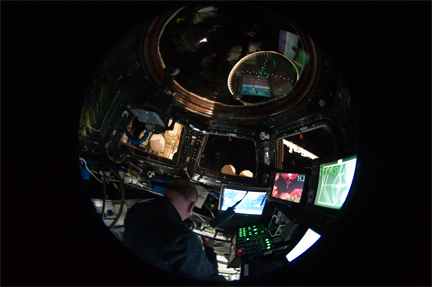
Garrett Reisman, operating the space station's robot arm
from inside the new multi-window cupola. The Russian MRM-1
- "Rassvet" - module is visible out the window at upper left with
the station's robot arm extending from the right. (Credit: NASA)
Sellers said the new arrangement is a major improvement over the indirect television views arm operators had to settle for before the cupola arrived.
"Tracy and I have been sitting in this little glass bubble that hangs underneath the space station and you can see everything," he said. "You can see big chunks of station, you can see the shuttle docked to one end and the arm stretched out in front of you and it makes it so much easier to figure out what's going on with the arm, which is like a big, monstrous crane. You can actually see what it's doing and go and grab things with it. Much better than watching it all on TV, I can tell you."
Reisman used the arm Tuesday to attach the Rassvet module. The new compartment was opened up early Thursday but the station crew does not plan to begin unloading the 1.5-tons of NASA equipment and supplies that are stored inside until after Atlantis departs.
"Our Russian crewmates have just opened up the hatch and looked inside," Caldwell Dyson said. "I went back to get an update and it sounds like it's full of stuff, not the least of which is hardware that must be removed before they can actually get to all of the goods they're to bring out. So I think there's a little bit of work to be done before we can go in and start enjoying it and utilizing it for the laboratory it's intended to be.
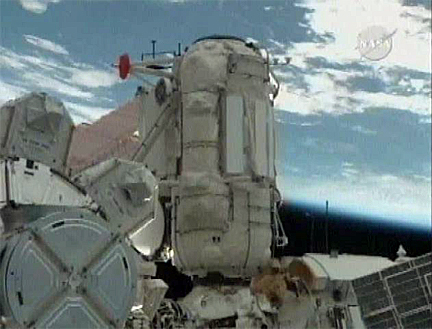
The Russian MRM-1 module docked to Zarya's Earth-facing port.
(Credit: NASA TV)
"But it's a great addition to the space station, especially for our Russian segment," she said. "I think we can look forward to some relief in terms of stowage as well as some extra space to do the very valuable experiments we've brought on board."
Caldwell, a shuttle veteran, was launched to the space station last month from the Baikonur Cosmodrome in Kazakhstan aboard a Russian Soyuz capsule. She took a moment Thursday to describe the experience.
"Launching on a Soyuz is a bit different from launching on the shuttle, not the least of which is the environment you're in," she said. "Having launched on a shuttle, being in Florida and surrounded by all that is familiar, to launch and live in Baikonur for two weeks, and also leave your home in Houston and family and friends months prior to that, really makes the mission start a lot earlier than the moment the rocket lights.
"I can tell you the Soyuz itself is a very robust vehicle, and it's very interesting, the differences between a solid rocket like the shuttle launches with and the liquid engines of a Soyuz rocket. And the fact that the Soyuz actually hangs on its launch pad rather than (is) bolted to it also creates an interesting sensation the moment of liftoff. There's a lot more yawing involved in the launch as well as more Gs being pulled.
"Life on board the Soyuz is, of course, different than shuttle," she said. "You have much more cozy quarters, but much fewer people to share that with. I could go on and on. The differences are very unique and very curious as well. But suffice it to say it is a vehicle I felt very safe in, and a ride that I'll never forget.
"Living on board the space station, I was warned by those who have come before me and spent many months on station that it takes about three weeks to actually kind of feel your legs aren't under you any more and to start actually utilizing this place for what it is, a floating laboratory.
"But it's not until about the six-week period that I'm reaching now that you actually feel like you've got a handle on the place. I do feel a lot more skilled at moving around this very large ship than I did when I first got here, of course, and I'm in awe every day of what our countries have accomplished and feel very privileged being here."
5:10 AM, 5/20/10, Update: Russian module hatch opening on tap; crew off-duty time
The Atlantis astronauts worked through a relatively light day in space Thursday, preparing for a third and final spacewalk Friday before taking their afternoon off to relax and enjoy the view from 220 miles up.
Their space station colleagues, meanwhile, planned to open the hatch of the new mini-research module - Rassvet - that was attached to the Earth-facing port of the Russian Zarya module Tuesday. The module is loaded with 1.5 tons of U.S. supplies and equipment, most of which will be unloaded after Atlantis departs.
The major item on the agenda today is to sample and filter the air inside the module to remove any suspended particles that might have shaken free during launch. As always when a new module is opened for the first time, the crew planned to wear goggles and dust masks as a safety precaution.
"The first thing we need to do is make sure the crew's going to be safe when they get into the new module," said Flight Director Scott Stover. "So we spent a lot of time going over procedures and getting a lot of equipment, like goggles and dust masks, all that ready for the crew to go in.
"Things like dust can be shook up, paint flecks could have come off from some of the material inside there and now that it's in a zero gravity environment, we are afraid that stuff's going to float around and either get into the eyes of the crew members or they could inhale it. So that's why we have them wear the goggles and dust masks."
After leak checks to verify the integrity of the seal between the new module and Zarya, the hatch will be opened around 6:30 a.m.
"It's always a great day for us to get a new module on the space station and open it up so we can get to work inside," Stover said.
Shuttle commander Ken Ham, pilot Tony Antonelli, robot arm operator Piers Sellers and space station flight engineer Tracy Caldwell Dyson planned to participate in round-robin media interviews with CBS News, Fox News and The Associated Press starting at 8:25 a.m.
The shuttle crew was scheduled begin a half day of off-duty time at 9:45 a.m. They planned to review procedures for Friday's spacewalk at 1:45 p.m. and go to bed at 5:50 p.m.
Astronauts Garrett Reisman and Michael Good planned to spend the night in the space station's Quest airlock module at a reduced pressure of 10.2 pounds per square inch to help purge nitrogen from their bloodstreams in preparation for a spacewalk Friday to finish installing a set of solar array batteries.
Here is an updated timeline of today's activity (in EDT and mission elapsed time; includes revision F of the NASA television schedule):
EDT........DD...HH...MM...EVENT 05/20 01:50 AM...05...11...30...Crew wakeup 03:35 AM...05...13...15...ISS daily planning conference 05:00 AM...05...14...40...EVA-3: Spacesuit reconfig 05:15 AM...05...14...55...MRM-1/Zarya leak checks 05:50 AM...05...15...30...EVA-3: Tools configured 06:30 AM...05...16...10...MRM-1 hatch open 06:50 AM...05...16...30...MRM-1 air cleaning/sample 07:30 AM...05...17...10...EVA-3: Equipment lock preps 08:15 AM...05...17...55...EVA-3: Procedures review (1) 08:25 AM...05...18...05...CBS Radio/Fox News/AP interviews 08:45 AM...05...18...25...Joint crew meal 09:45 AM...05...19...25...Shuttle crew off duty 10:15 AM...05...19...55...MRM-1 ingress prep 11:30 AM...05...21...10...Mission status briefing on NTV 01:45 PM...05...23...25...EVA-3: Procedures review (2) 02:50 PM...06...30...00...ISS daily planning conference 04:15 PM...06...01...55...EVA-3: Oxygen pre-breathe protocol 04:50 PM...06...02...30...EVA-3: 10.2 psi campout begins 05:20 PM...06...03...00...ISS crew sleep begins 05:50 PM...06...03...30...STS crew sleep begins 06:00 PM...06...03...40...Daily highlights reel 09:00 PM...06...06...40...HD crew highlights
2:00 PM, 5/19/10, Update: Spacewalk No. 2 ends
Astronauts Stephen Bowen and Michael Good completed an extended seven-hour nine-minute spacewalk today, repressurizing the space station's Quest airlock module starting at 1:47 p.m.
This was the 145th spacewalk devoted to station assembly and maintenance since construction began in 1998, the ninth so far this year and the second of three planned by the Atlantis astronauts. Total space station EVA time now stands at 908 hours and seven minutes, or 37.8 days.
Good, a veteran of two Hubble Space Telescope repair spacewalks, has now logged 23 hours and seven minutes of EVA time through three excursions while Bowen's total through five spacewalks moves him up to 28th on the list of most experienced spacewalkers, with 34 hours and 30 minutes.
01:15 PM, 5/19/10, Update: Spacewalkers install four of six solar array batteries; fix problems with spare antenna, inspection boom
Astronauts Stephen Bowen and Michael Good, working at the far left end of the International Space Station's main power truss, successfully replaced four massive solar array batteries today, leaving just two powerpacks to be installed during a third spacewalk Friday.
Running well ahead of schedule, the astronauts were asked to perform a bit of troubleshooting on a spare Ku-band antenna that was installed during a spacewalk Monday. Working together, Bowen and Good tightened four bolts with a power wrench in a bid to eliminate a 1-millimeter gap between the base of the antenna and its support mast.
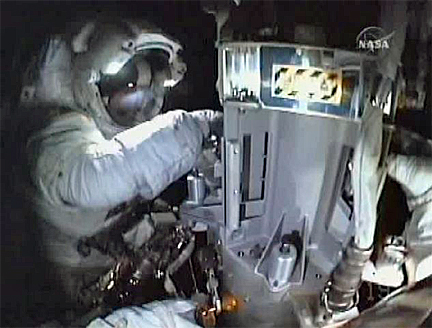
Astronauts Stephen Bowen and Michael Good tighten bolts
holding a spare Ku-band antenna in place. (Credit: NASA TV)
"I'm doing a wiggle test and I'm not getting any motion," Good reported, pulling on the boom and looking for any signs of play in the antenna-mast interface.
"I'm seeing absolutely nothing," Bowen agreed. "Nothing like we had the other day, that's for sure. ... And I don't see any gaps."
"Great job, that does it," astronaut Steve Swanson called from mission control a few moments later. "SGANT (space-to-ground antenna) is on firmly."
The spacewalkers then worked to remove gimbal locks from the antenna's steering system that were left in place Monday. The additional work pushed the spacewalk beyond the planned six-hour 30-minute mark, but both astronauts said they were in good shape as they worked to complete their final task.
Earlier in the spacewalk, Bowen freed a snagged cable that was preventing a pan-and-tilt unit on the end of the shuttle's heat shield inspection boom from moving through its full range of motion. He had no problems securing the offending cable.
Mission managers are still considering whether to order any additional inspections while Atlantis is docked to the station or whether to wait until an already planned post-undocking inspection. With Bowen's successful repair work, the sensor package should be available for normal operation whenever it is needed.

A view of the International Space Station as Bowen and Good
returned to the Quest airlock, visible at lower left). (Credit: NASA TV)
The astronauts had no major problems removing the 375-pound batteries from a cargo pallet held in place by the station's fully extended robot arm and installing them in the P6 solar array's integrated electronics assembly.
Each of the station's four main solar array segments includes 12 batteries that are charged during orbital daylight and supply the station's electrical power during orbital darkness. The batteries have a design life of 6.5 years. Launched in November 2000, the P6 arrays are the oldest on the space station. Six of its batteries were replaced in 2009 and the rest are being swapped out during the current flight.
Going into today's spacewalk, the objective was to change out just three batteries. Based on past experience, flight controllers were concerned about possible alignment problems. But after wrestling the first new battery into place, Bowen and Good said they had a good feel for how the hardware behaved.
"What I saw, Steve, I think the H1 side, my side in your left hand, was too far in, so I think we had a little bit of yaw and I think once we brought it back out ... then it seemed to go in," Good observed. "So I think we had a little yaw in it."
"I agree with that," Bowen said. "And I will tell you, I did feel more of a ka-thunk, like it went over a bit of a soft dock that last time when, you know, we kind of rocked it gently. I think that may be the key, get the alignment, get the yaw (corrected), just kind of rock it gently and it should fall into place."
"OK, great," pilot Dominic Antonelli, the spacewalk coordinator, called from Atlantis. "I was thinking when you were getting ready to drive it the successful time that H1 was a lot farther out than it had been before and my first thought was oh, you don't have it pushed in far enough. But with the yaw error, it was the exact opposite. So great job."
"So don't push each one in all the way, let it stay level," Good said.
"It'll be a lot easier now," Bowen agreed.
7:45 AM, 5/19/10, Update: Astronaut frees jammed cable in heat shield inspection boom
Astronaut Stephen Bowen, anchored to the top of the space station's power truss, tied off a cable jamming the pan-and-tilt mechanism of the shuttle Atlantis' heat shield inspection boom in a bid to restore a sensor package to normal operation.
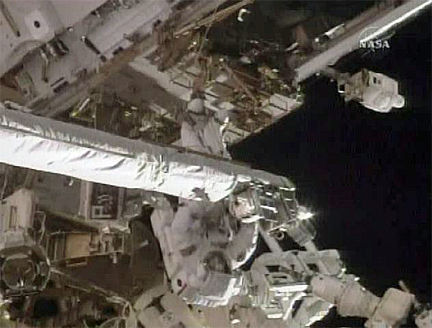
Astronaut Stephen Bowen ties off a cable interfering with
the motion of the pan-and-tilt mechanism on the shuttle's
heat shield inspection boom. (Credit: NASA TV)
"You are 'go' to unsnag the LDRI cable," astronaut Steve Swanson radioed from mission control after Bowen was in place.
"OK, I have it unsnagged," Bowen replied a moment later.
"Well done, superhero," called shuttle pilot Dominic Antonelli. "Now let's see if you can handle the tie wraps."
Bowen then tied off the offending cable. A quick test showed the mechanism was still experiencing interference from a different cable tie that was sliding along a group of cables as the pan-and-tile unit moved, preventing a full range of motion.
But engineers concluded any additional hang ups could be resolved by simply moving the pan-and-tilt mechanism back and forth and Bowen was cleared to join astronaut Michael Good on the far left end of the station's power truss to begin replacing aging batteries.
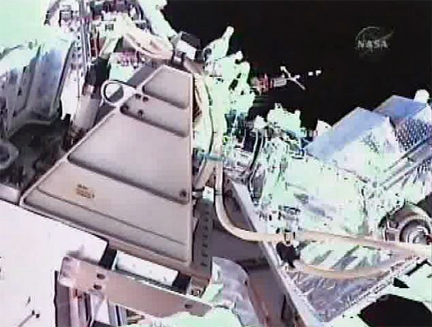
A helmet cam view of the pan-and-tilt mechanism showing a
green cable tie, at center, that caused additional interference.
(Credit: NASA TV)
6:50 AM, 5/19/10, Update: Spacewalk No. 2 begins
Astronauts Stephen Bowen and Michael Good switched their spacesuits to battery power at 6:38 a.m. EDT to officially kick off a planned six-and-a-half-hour spacewalk. The goal of today's excursion is to replace at least three of six aging solar array batteries on the far left side of the space station's main power truss.
While Good is setting up foot restraints and other equipment for the battery swap out, Bowen will move to the top of the power truss where the shuttle Atlantis' heat shield inspection boom will be positioned for an impromptu repair job.
Bowen plans to tie off a cable jamming the pan-and-tilt mechanism used by a sensor package on the end of the boom. Assuming the repair is successful, the preferred sensor package may be used later in the mission to collect additional imagery of critical areas that were missed earlier because of the cable jam.
This is the 145th spacewalk devoted to station assembly and maintenance since construction began in 1998, the ninth so far this year and the second of three planned by the Atlantis astronauts.
5:00 AM, 5/19/10, Update: Astronauts prep for second spacewalk
Astronauts Michael Good and Stephen Bowen are gearing up for a planned six-and-a-half-hour spacewalk, the first of two devoted to replacing six of the International Space Station's oldest solar array batteries.
Bowen, a veteran submariner, also will take a moment at the beginning of the EVA to tie off a cable jamming the pan-and-tilt mechanism on the shuttle's heat shield inspection boom. Assuming the impromptu repair is successful, sensors on the end of the boom may be used later in the mission to collect additional imagery of critical areas that were not imaged earlier because of the cable snag.
NASA's Damage Assessment Team, based on imagery and other data collected earlier in the mission, has not spotted any damage that could cause problems during re-entry. While flight controllers are still considering using the repaired inspection boom for additional surveys of Atlantis' left wing leading edge panels, the inspections are not considered a requirement.
"Although the regular suite of imagery was not obtained, the teams used all the available assets to perform an engineering assessment on the thermal protection system," NASA's Mission Management Team said in an overnight message to the crew.
"The DAT cleared the TPS for entry based on these assessments. For the RCC (reinforced carbon carbon nose cap and wing leading edge panels), the DAT has high confidence, based on all available data, that there were no signatures indicating any damage from ascent debris. Based on these conclusions, there were no requirements from the DAT for additional docked surveys. Even without the full suite of imagery the MMT felt that it was a very low risk to wait until late inspection for the next survey."
The so-called late inspection is typically carried out after undocking to look for any signs of damage that might have occurred since the initial post-launch examination.
Today's spacewalk is scheduled to begin around 7:15 a.m. EDT. This will be the 145th spacewalk devoted to station assembly and maintenance since construction began in 1998, the ninth so far this year and the second of three planned by the Atlantis astronauts. Good, call sign EV-2, is a veteran of two Hubble Space Telescope spacewalks while Bowen, call sign EV-1, will be making his fifth excursion, his second during the current mission.
Today's excursion is the first of two devoted to replacing batteries in the P6 solar array at the far left end of the space station's power truss. The space station's solar array batteries are charged during daylight and provide the lab's electrical power during orbital darkness.
The P6 array, one of four NASA-supplied solar generators, was launched in November 2000. Six of its nickel-hydrogen batteries were replaced during a shuttle flight in July 2009 and the other six, well past their 6.5-year design life, are being replaced during Atlantis' mission.
"These aren't double As," Good joked before launch. "One of my brothers likes to give me a hard time about flying up in space and changing batteries, he thinks this is not a very difficult task, not a big deal. But these are like 400-pound nickel-hydrogen batteries, they're the size of a big suitcase, probably bigger than the airlines would let you take on without charging you extra. And they're pretty tricky. ... The alignment and the tolerances are very tight."
The six new batteries were carried aloft attached to an integrated cargo carrier in Atlantis' cargo bay. Astronaut Piers Sellers, using a robotic work station in the multi-window cupola, will extend the lab's robot arm to its maximum length to get the pallet as close as possible to the P6 array.
"This whole battery R & R is like a shell game, or one of those puzzles where you move the numbers around," said Lisa Shore, the lead spacewalk officer for Atlantis' mission. "The first thing you need to do is create an open spot to start the shuffle. So we'll install some handling aids onto the first battery we intend to remove. We're also going to install a ball stack, it's a metal tether that can be rigidized to temporarily stow the battery during the EVAs."
Good will be responsible for removing batteries from the truss and installing their replacements while Bowen moves batteries to and from the cargo carrier. After the first battery is removed from P6 and mounted on the ball stack, Bowen will pull a replacement battery from the cargo carrier. Both astronauts will carefully maneuver the massive power pack into place, taking special care not to damage fragile cooling fins on the back side.
Once the new battery is in place and electrically connected, the astronauts will move the old battery from its temporary mounting point and install it in the cargo carrier for return to Earth. That process will continue until at least three and possibly four batteries are installed. The remainder will be installed during the third and final spacewalk Friday.
"It's all about batteries," Good said before launch. "We're doing six of them on this flight and I get to do them all, with Steve on one EVA and Garret (Reisman) on the other. We've got to get them all done. They come up on a pallet in the shuttle's payload bay, the arm gets them out there to the very end of the truss on the space station, out there amongst the solar arrays. And that's probably got my biggest concern spacewalking wise, just getting through those batteries."
Lessons learned during the 2009 battery replacement work will be applied, but Good said problems are not unexpected.
"They got through them all, but they had a lot of curve balls thrown at them," he said. "The batteries are out there on this pallet, and they're on the end of the arm, and it's stretched out as far as it can go to get them out there, just to get them close. It can't actually get them all the way out to where we're going to be installing them. So we're going to take them off the pallet, shepherd them over to where they're going to go in and out of the truss, and it's kind of tricky to get them in and out."
Each battery is held in place by two bolts and "it seems like it would be pretty simple just to put them in and screw two bolts in," Good said. "But they go in on these posts, and they have to align just perfectly, and you have to overcome a soft dock to get them set in there before you can drive the bolts. And if you don't get it all the way in there just right, you could drive that bolt all you want, but you'd never catch a thread to make it draw into the slot where it goes. So there's going to be some work there."
Said Bowen: "A single stuck bolt, something slightly misaligned (can cause problems). ... It's a very delicate task. Hopefully we'll learn from the first one we do, we'll get into a groove and just be able to work our way through each of the batteries. How many batteries we get done on EVA-2 really sets up EVA-3."
Here is an updated timeline of today's activity (in EDT and mission elapsed time; includes revision D of the NASA television schedule):
EDT........DD...HH...MM...EVENT 05/19 02:20 AM...04...12...00...Crew wakeup 03:00 AM...04...12...40...EVA-1: Airlock repress/hygiene break 03:45 AM...04...13...25...EVA-1: Airlock depress to 10.2 psi 04:05 AM...04...13...45...ISS daily planning conference 04:10 AM...04...13...50...EVA-1: EVA prep 05:40 AM...04...15...20...EVA-2: Spacesuit purge 05:55 AM...04...15...35...EVA-2: Spacesuit prebreathe 06:45 AM...04...16...25...EVA-2: Crew lock depressurization 07:15 AM...04...16...55...EVA-2: Spacesuits to battery power 07:20 AM...04...17...00...EVA-2: Airlock egress 07:35 AM...04...17...15...EVA-2: Setup 07:45 AM...04...17...25...EVA-2 (Good): Worksite prep 07:45 AM...04...17...25...EVA-3 (Bowen): Inspection boom cable repair 08:05 AM...04...17...45...EVA-2 (Bowen): Worksite prep 08:45 AM...04...18...25...EVA-2: Temp stow battery 09:20 AM...04...19...00...EVA-2: P6 battery A/2 replacement 10:25 AM...04...20...05...EVA-2: P6 battery B/3 replacement 11:30 AM...04...21...10...EVA-2: P6 battery C replacement 12:05 PM...04...21...45...EVA-2: Install battery on pallet 12:40 PM...04...22...20...EVA-2: Cleanup and ingress 01:00 PM...04...22...40...SSRMS maneuvers to SARJ clear 01:45 PM...04...23...25...EVA-2: Airlock repressurization 01:55 PM...04...23...35...Spacesuit servicing 03:25 PM...05...01...05...ISS daily planning conference 04:00 PM...05...01...40...Mission status briefing on NTV 04:05 PM...05...01...45...EVA tagup 05:20 PM...05...03...00...ISS crew sleep begins 05:50 PM...05...03...30...STS crew sleep begins 06:00 PM...05...03...40...Daily highlights reel 10:00 PM...05...07...40...HD crew highlights
9:05 AM, 5/18/10, Update: Russian module docked to station in orbital 'hole in one'
Using robotic precision in place of brute force, a nine-ton Russian module loaded with U.S. supplies and equipment was successfully attached to the International Space Station early today after an orbital "hole in one" by robot arm operator Garrett Reisman.
Appropriately, Reisman waited until orbital sunrise to dock the "Rassvet" - Dawn - compartment to the Earth-facing port of the Russian Zarya module as the shuttle Atlantis and the space station sailed 220 miles above Argentina
"Capture," astronaut Piers Sellers called at 8:20 a.m. "Contact. And Houston, ISS robo. It looked like a pretty good docking. We never got 'contact 1,' straight down the middle and got capture and contact."
"Houston copies," astronaut Steve Swanson replied from mission control.
"And Houston, ISS robo. Just to follow up on (readings from the Russian) laptop," Sellers called. "We said before 'contact 1' never came on and it's still not showing. And also we got a fault, a yellow block, 'no auto docking signal' statement under the ADS faults."
"And station, that error's expected," Swanson replied. "Everything looks good at this time to us. ... The reason you didn't get 'contact 1' is because Garrett did too good of a job flying. He went right down the middle and got a hole in one."
"He knows that and he's loving it," Sellers replied.
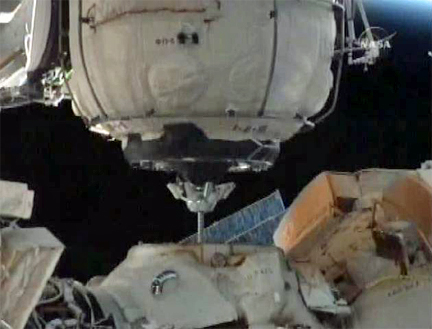
The Russian Rassvet module, driven into the Zarya module's
docking port by the station's robot arm. (Credit: NASA TV)
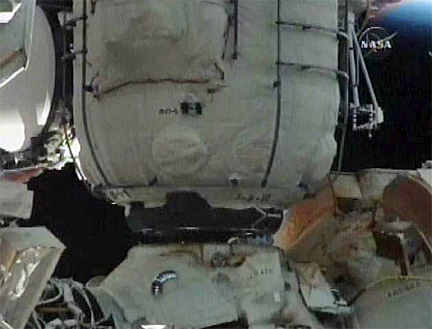
Docking complete. (Credit: NASA TV)
With the attachment of Rassvet, also known as the mini-research module - MRM-1 - the International Space Station now masses 816,349 pounds and is 93 percent complete by mass and 98 percent complete by habitable volume, with more than 29,500 cubic feet of pressurized volume.
Reisman thanked station Flight Director Emily Nelson and the rest of the U.S.-Russian team, saying "great job getting us to this point and we're very happy that we now have MRM-1 docked to the station."
Reisman and Sellers, speaking Russian, both then thanked the Russian mission control team.
"Houston, Moscow, thank you for delivering a new module," station commander Oleg Kotov radioed, speaking English. "We really enjoy work with excellent crew and they did excellent job. Thank you very much."
Shuttle commander Ken Ham and pilot Dominic Antonelli, operating Atlantis' robot arm, pulled the mini-research module from the shuttle Atlantis' payload bay around 5:50 a.m.
Reisman, operating the station's arm, then locked on and took over, maneuvering the squat module into position for attachment to the Zarya module.
Russian modules normally dock autonomously, using more force than NASA typically employs. Using that momentum to overcome alignment errors, a probe on the front end of an approaching Russian module can hit anywhere in the receiving cone and it will end up in the correct central position for capture.
The station's robot arm could not deliver the normal docking force, but it more than made up for that shortcoming by the precision alignment achieved before the final capture sequence. The approach was so precisely aligned the Russian laptop computer Sellers was using to monitor the docking sequence did not even register several intermediate steps.
With Rassvet in place, the Atlantis astronauts will spend the rest of the day gearing up for a spacewalk Wednesday, the second of three planned for the mission, to begin replacing six aging batteries in the station's oldest set of solar arrays.
Reisman also will use the station arm to pull the shuttle's heat shield inspection boom from the orbiter's payload bay, handing it off to Atlantis' arm.
Interference with a cable in the pan-and-tilt mechanism of the primary sensor package on the end of the boom forced the astronauts to use a backup procedure to inspect the shuttle's nose cap and wing leading edge panels the day after launch. Additional inspections may be necessary later.
But engineers have developed a repair plan to move the offending cable and tie it out of the way. Repair plans were uplinked to the crew overnight for possible use during the crew's second spacewalk.
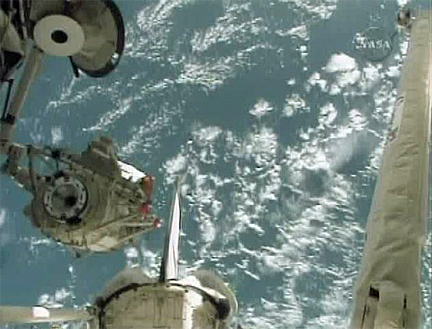
The MRM-1 "Rassvet" module, being moved from the shuttle
Atlantis to the Zarya module for installation. (Credit: NASA TV)

(Credit: NASA TV)
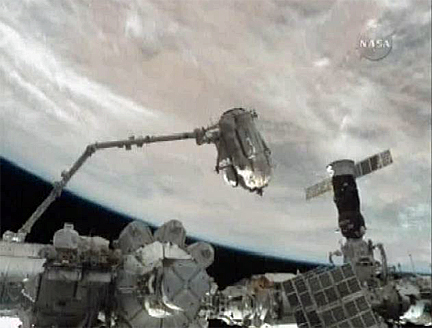
(Credit: NASA TV)
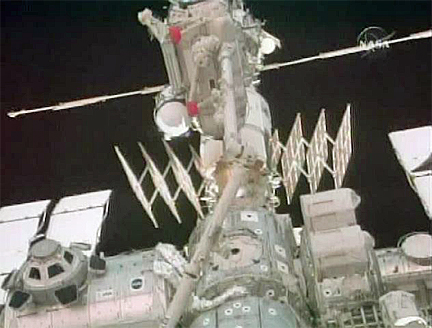
Robot arm operator Garrett Reisman is inside the multi-window
cupola at left.(Credit: NASA TV)
5:00 AM, 5/18/10, Update: Russian module installation on tap
Astronauts Garrett Reisman, operating the space station's robot arm, and Piers Sellers, sending commands from a laptop computer, plan to attach a nine-ton Russian module to the International Space Station today in a complex operation blending U.S. and Russian docking systems.
The station arm will move the "Rassvet" module in for docking at a much slower speed than Russian spacecraft typically employ. But Reisman and Sellers - the "Rassvet Rammers" - plan to make up for the lack of force by using the arm to precisely align the two docking systems, ensuring a successful capture.
"I think everything's going to work out just fine," shuttle commander Ken Ham told CBS News before launch. "But with any 'first' that you do, and this is the test pilot speaking, you've got to wonder about what is it that hasn't been thought about yet. And there are potentials in this scenario trying to get this on there with the arm. That makes it different."
The 17,760-pound mini-research module, known as Rassvet or "Dawn," is packed with 3,086 pounds of NASA equipment and supplies and carrying an experiment airlock and European robot arm equipment that will be attached to other modules later.
Docked to the Earth-facing port of the central Zarya module, MRM-1 will bring additional pressurized volume for research and stowage and provide needed clearance between the forward Russian docking port and a U.S. storage module scheduled for attachment later this year.
Installation operations were scheduled to begin around 5:20 a.m. EDT when Atlantis commander Ken Ham and pilot Dominic Antonelli, operating the shuttle's robot arm, planned to pull the mini-research module, or MRM-1, from the orbiter's cargo bay.
After positioning the module within reach of the station's robot arm, Reisman and Sellers will take over and move MRM-1 into position for installation on Zarya's Earth-facing port.
"From that point, Garrett and Piers will maneuver the Rassvet module to where it's about five feet below the docking port where it's going to be installed," said space station Flight Director Scott Stover. "At that point, we check out the docking probe itself that's on Rassvet, making sure it's good."
The docking probe, extending from the front of the Rassvet module, is designed to fit into a cone-like receptacle in the Zarya docking interface. After the probe is in place, it will retract, pulling the two modules together so hooks and latches can engage to firmly seal the docking interface.
"Once the docking mechanism is activated, Garrett will go ahead and use the arm to push Rassvet into the docking port," Stover said. "They'll be looking for some telemetry from Rassvet, what we call 'capture confirmed' telemetry, which will tell us it's in place and ready for docking. At that point, Piers will use a Russian laptop to command Rassvet to do the docking.
"The docking probe will actually retract, which pulls the interface together. And then we'll drive some hooks that'll make a hard mate of Rassvet to Zarya."
After verifying Rassvet is securely attached and drawing power from the space station, Reisman will move the robot arm back to the shuttle's cargo bay to pick up the ship's heat shield inspection boom and hand it off to the shuttle arm.
Interference with a cable in the pan-and-tilt mechanism of the primary sensor package on the end of the boom forced the astronauts to use a backup procedure to inspect the shuttle's nose cap and wing leading edge panels the day after launch and additional inspections may be necessary later.
But engineers have developed a repair plan to move the offending cable and tie it out of the way. Repair plans were uplinked to the crew overnight for possible use during the crew's second spacewalk Wednesday.
The Russian module's docking system is virtually identical to the systems used by Progress and Soyuz spacecraft that dock with considerably more force than NASA typically employs. The station's robot arm cannot match that docking force, but by precisely centering the docking mechanisms, engineers are confident the Canadian space crane can get the job done.
"This module was originally designed to fly up, like all the other Russian modules, and dock under its own power, autonomously," Reisman said. "The way they do that is they have big cone (on one module) and a big probe (on the other), they get a good running start and it's almost like bringing train cars together. I was inside the station a couple of times when dockings occurred and you can feel her come in. It's definitely an event.
"What we're trying to do here is very different. ... They call it 'mini' but like many things, it's actually very big," said Reisman, who stands 5 feet 4 inches tall and is jokingly known as "Big G." "To have it on the very end of the arm, with the arm fully extended, there are a lot of dynamics at play. So the arm can't get the kind of ramming speed it normally develops under its nominal means of docking. So we're going to be restricted to coming in approximately five times slower, and that's the fastest the arm can do safely.
"What we hope to do is have very fine control and have it come right down the middle. There are a lot of people who have worked really hard, did a lot of analysis to verify this is going to work. But the exciting thing is it's never been done before and so I'm sure we'll all be watching very carefully as we bring that in on flight day five."
Commanding to the active side of the docking mechanism, inside the MRM-1 module, will be routed via ethernet from a laptop computer in the U.S. segment of the station to a Russian central computer and then back to the station's robot arm. Signals will move down the arm, through an electrically powered grapple fixture on the hull of the new module and then to an internal Russian computer.
On the positive side, Reisman and Sellers will be operating the arm and sending computer commands from the station's new multi-window cupola observation deck attached to the Tranquility module. Up until this point, the arm was operated from inside the Destiny lab module, using indirect television views to provide operators with views of various work sites.
For the MRM-1 installation, Reisman and Sellers will have a direct view of the module and the Russian docking port where it will be installed.
"This is going to be something," Sellers said. "Because up to now, the operators of the arm have never seen it, they've only watched it all on their TV screens. This is going to be kind of a first in that I'll be able to look out the window and see what I'm doing directly. Not all the time, but some of the time. I think it makes a huge difference. ... We're not looking at the toenail of the elephant here, we're seeing the whole elephant."
The direct view will help, but first, commanding through the Russian computer system must work properly.
"Getting data, power, communications, all of that is going through the arm," said station Flight Director Emily Nelson. "But the control goes from a laptop at the cupola robotic work station that Piers will be running that's connected through our ethernet connections on board all the way back to the Russian central computer and then comes back through the same ethernet connections, through the arm and into MRM-1. So all of that data's going through a pretty long path to get to where it's headed, which is new and different.
"Also, and I don't know how many of you have watched Progress and Soyuz dockings, but those vehicles don't come in slowly, they come in with quite a bit of force. There's a great deal of spring force in the probe head of the docking probe that has to be overcome, so we've also worked hard to ensure we've got the right rates on the arm, that the arm has sufficient rates to overcome those spring forces so that we can actually get the docking probe into the docking cone for the first physical mate."
The Russian docking system was designed to be tolerant of alignment errors. The approaching spacecraft's docking system features a long probe designed to fit into a cone-shaped receptacle on the target docking port. Once the probe is captured, hooks and latches are activated to firmly pull the two modules together.
"One of the reasons it's designed to bang together is then you can have tremendous errors in your alignment," Reisman said. "The receiving end is shaped like a cone. If you hit the side, with that momentum, the (probe) will just slide down the cone and end up in the hole."
The station's robot arm cannot drive MRM-1's probe into the docking cone on the Zarya module with the same amount of force. It makes up for that with high precision.
"Even though we're coming in five times slower, if we come in five times more accurately - which puts a lot of pressure on me! - (it will work)," Reisman said.
Assuming a successful docking, the station crew will be in no rush to open MRM-1 and begin unloading the NASA supplies and equipment that are stored inside. Because of the tight timeline for the Atlantis astronauts, that work is planned for after the shuttle departs.
Here is an updated timeline of today's activity (in EDT and mission elapsed time; includes revision G of the NASA television schedule):
EDT........DD...HH...MM...EVENT 05/18 02:50 AM...03...12...30...Crew wakeup 04:50 AM...03...14...30...ISS daily planning conference 05:20 AM...03...15...00...MRM-1 unberth 06:15 AM...03...15...55...MRM-1 docking operations 06:30 AM...03...16...10...EMU swap for EVA-2 06:55 AM...03...16...35...MRM-1 release 07:35 AM...03...17...15...OBSS repair tie wrap preps 07:55 AM...03...17...35...SRMS views docking 08:05 AM...03...17...45...EVA-2: Tools configured 09:35 AM...03...19...15...EVA-2: Equipment lock preps 10:05 AM...03...19...45...Crew meals begin 11:10 AM...03...20...50...SSRMS grapples OBSS 11:25 AM...03...21...05...SSRMS unberths OBSS 11:55 AM...03...21...35...SSRMS moves OBSS to handoff position 12:25 PM...03...22...05...SRMS grapples OBSS 12:45 PM...03...22...25...SSRMS releases OBSS 02:20 PM...04...00...00...PAO event 02:45 PM...04...25...00...EVA-2: Procedures review 03:30 PM...04...01...10...Mission status briefing on NTV 03:55 PM...04...01...35...ISS evening planning conference 05:15 PM...04...02...55...EVA-2: Mask pre-breathe 05:50 PM...04...03...30...EVA-2: 10.2 psi campout begins 06:20 PM...04...04...00...ISS crew sleep begins 06:50 PM...04...04...30...STS crew sleep begins 07:00 PM...04...04...40...Daily highlights reel 10:00 PM...04...07...40...HD crew highlights reel
3:35 PM, 5/17/10, Update: Spacewalk No. 1 ends (UPDATED at 7:30 p.m. with news briefing)
Astronauts Garrett Reisman and Stephen Bowen carried out an extended seven-hour 25-minute spacewalk Monday, moving a backup Ku-band antenna to the International Space Station along with an equipment mounting platform. They also loosened bolts holding six new solar array batteries to a cargo pallet as get-ahead work for two upcoming spacewalks.
"The EVA was pretty much a raging success," said Lisa Shore, the lead spacewalk officer for Atlantis' mission at the Johnson Space Center. "We met every one of our major objectives. These EVAs were a challenge to train because we could not complete them end to end in (ground facilities). Until we actually performed them, we weren't sure how the timing was going to come out. And the crew just did a fantastic job."
The spacewalkers had to contend with a space station computer glitch during the excursion, struggled with a balky electrical connector and were unable to completely tighten down the new dish antenna on its eight-foot-tall support mast.
Engineers are considering whether the bolts in question should be re-tightened at some point down he road to close up a 1-millimeter gap in the dish-boom interface. Because the current configuration has never been analyzed in terms of its response to structural loads, the astronauts were told to re-engage the antenna's steering system launch locks and to tether the antenna to the truss as a safety precaution.
Even so, mission managers said they considered the spacewalk and the progress of the Atlantis mission to this point to be an overall success.
"We couldn't be more pleased with how the mission is going so far," said LeRoy Cain, chairman of NASA's Mission Management Team. "We've had a few glitches here and there, but they're not significant in the grand scheme of the kinds of things we're trying to accomplish on this docked mission."
The computer glitch occurred as Reisman, anchored to the end of the station's robot arm, was in the process of getting the dish antenna from a cargo pallet before moving it up to the Z1 truss for installation. One of the station's three primary command-and-control computers, or C&C machines, dropped off line and handed operations over to a backup.
That, in turn, shut down the station's video system and the lab's robot arm. The robot arm was re-enabled after a brief interruption and the spacewalk proceeded.
Flight Director Emily Nelson said engineers believe the glitch may have been triggered when Bowen removed caps from electrical connectors in preparation for installation of the new Ku-band antenna.
"When the cap was removed, what we suspect is that that broke continuity in one of our data buses and that confused our C&C, our command and control computer, such that it suspected a failure," she said. "And in case the failure is with that computer, it goes off line and allows its backup to come up.
"All of the critical functions that that computer provides are handed over immediately to the backup machine. So we maintained communications via S-band, the (robot) arm safed itself because of that transition of its controller. But all of our other functions within the machine were handed over from one to the next."
The space station currently is operating with two C&C machines, a primary and a backup, pending a review of telemetry to make sure the problem with C&C No. 3 is fully understood.
Monday's spacewalk was the 144th devoted to station assembly and maintenance since construction began in 1998, the eighth so far this year and the first of three planned by the shuttle Atlantis' crew. Total EVA time now stands at 900 hours and 58 minutes, or 37.5 days. Bowen's EVA time through four spacewalks is 27 hours and 21 minutes while Reisman's total through two EVAs stands at 14 hours and 26 minutes.
01:15 PM, 5/17/10, Update: Spacewalkers fall behind schedule installing dish antenna
Spacewalkers Garrett Reisman and Stephen Bowen successfully mounted a 6-foot-wide dish antenna to an 8-foot-tall support boom atop the International Space Station, but they fell well behind schedule locking the dish in place and getting a balky electrical connector plugged in.
The backup Ku-band antenna was carried to the work site by Garrett, riding on the end of the station's robot arm. He and Bowen secured the dish around 11:39 a.m., but it took more than an hour to plug the connecter into its socket and to re-torque bolts holding the antenna to its boom.
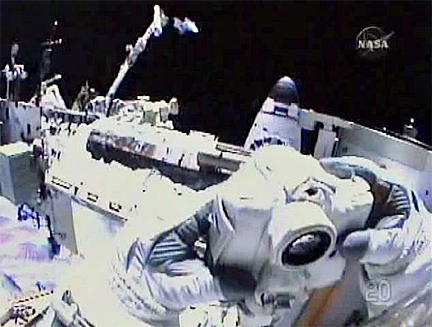
Steve Bowen's helmet cam, showing Garrett Reisman in the
background at upper left carrying a new antenna. (Credit: NASA TV)
An overly tight fit was resolved by allowing sunlight to heat up the socket while the astronauts shaded the plug. When the connector finally locked in place, the spacewalkers bumped fists in a brief celebration.
Reisman then left the area to begin the crew's next task while Bowen worked to disengage launch locks on the antenna's steering system. While that work was going on, engineers at the Johnson Space Center decided they were not comfortable with a slightly loose fit between the antenna and its support boom.
Bowen was asked to re-engage the gimbal locks and to use a tether to firmly secure the antenna pending additional discussions. By the time the antenna was tethered in place, the spacewalkers had spent five hours on a task that was budgeted for about three.
The next item on the agenda is to install an equipment mounting platform on the Canadian Special Purpose Dexterous Manipulator, a hand-like attachment that can be used by the robot arm to remotely install various components and experiments.
Because of time lost during the antenna, today's spacewalk likely will last longer than the planned six and a half hours.
11:00 AM, 5/17/10, Update: Antenna boom installed; dish antenna installation in work after computer glitch
Astronauts Garrett Reisman and Stephen Bowen have installed an 8-foot boom on the space station's Z1 truss that eventually will support a backup Ku-band antenna system.
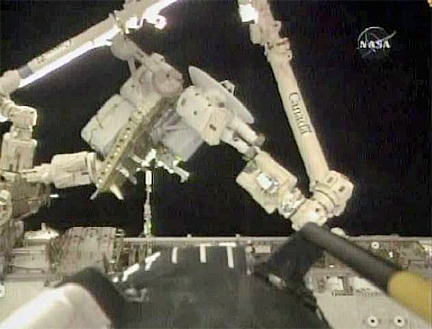
Garrett Reisman, anchored to the space station's robot arm,
works to detach a dish antenna from its carrier pallet.
(Credit: NASA TV)
The support mast was bolted in place shortly before 10 a.m. EDT and Reisman, anchored to the end of the space station's robot arm, was carried back to a cargo pallet to retrieve the 6-foot-wide dish antenna.
"Wow! I'm way up here now," he said. "I might only be five foot four, but right now I think I'm the highest person around. Whoo!"
Reisman was preparing to unbolt the antenna from the cargo carrier when a computer glitch aboard the lab complex knocked out power to several systems, including the video displays being used by robot arm operator Piers Sellers.
It took about a half hour to bring up a different system and restore the displays to normal operation. The antenna work resumed just after 10:30 a.m.
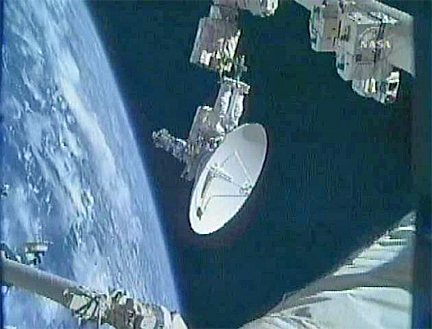
Reisman holds the antenna while Piers Sellers, operating
the station's robot arm, moves them both toward the Z1 truss.
(Credit: NASA TV)
8:10 AM, 5/17/10, Update: Spacewalk No. 1 begins
Floating in the Quest airlock module, astronauts Garrett Reisman and Stephen Bowen switched their spacesuits to battery power at 7:54 a.m. EDT to officially begin a planned six-and-a-half-hour spacewalk. They floated out of the airlock a few moments later to begin the day's work.

Astronaut Garrett Reisman, left, and Stephen Bowen, right,
exit the Quest airlock. (Credit: NASA TV)
The primary goals of the excursion, the first of three planned by the Atlantis astronauts, are to install a backup Ku-band dish antenna on the International Space Station, along with a robot arm equipment mounting platform.
It will take about an hour for the spacewalkers to set up their tools and equipment. The antenna installation is expected to take nearly three hours to complete. Attaching the robot arm equipment platform will take another hour and a half or so.
If time is available, the astronauts will wrap up today's EVA by loosening bolts holding six solar array batteries in place on a cargo pallet. The batteries will be installed during the crew's second and third spacewalks.
5:45 AM, 5/17/10, Update: Astronauts suit up for spacewalk
Astronauts Garrett Reisman and Stephen Bowen are suiting up for a planned six-and-a-half-hour spacewalk to install a backup Ku-band dish antenna on the International Space Station, along with a robot arm equipment mounting platform.
The spacewalk is scheduled to begin at 8:15 a.m. EDT when Reisman and Bowen, floating in the Quest airlock module, switch their spacesuits to battery power. Bowen, call sign EV-2, will be wearing a suit with red stripes around the legs while Reisman, EV-1, will be wearing an unmarked suit.
This is the 144th spacewalk devoted to station assembly and maintenance since construction began in 1998, the eighth so far this year and the first of three planned by the shuttle Atlantis' crew. Bowen is making his fourth spacewalk and Reisman is making his second. Total space station EVA time going into Monday's excursion was 893 hours and 33 minutes, or 37.2 days.
Reisman and Bowen spent the night in the Quest module at a reduced pressure of 10.2 pounds per square inch to help purge nitrogen from their bloodstreams, a routine protocol intended to prevent decompression sickness, or the bends, when working in NASA's 5 psi spacesuits.
"It's going to be a long EVA," said station flight director Scott Stover. "We have two major objectives. The first one is installing the new space-to-ground antenna system that came up with Atlantis. What this is going to be is a backup high-data-rate antenna that's used for space station video and experiment data. Right now there's only one on board the space station and this will be a backup for that.
"Garrett will be on the end of the arm and he will be handling the big pieces of this antenna, moving (them) back and forth while Steve is there to run cables and bolts to make sure everything is being attached," Stover said. "So you'll see multiple times where Garrett is getting a piece of equipment off the ICC (integrated cargo carrier) and moving it over to the right place on space station for it to be installed by Steve."
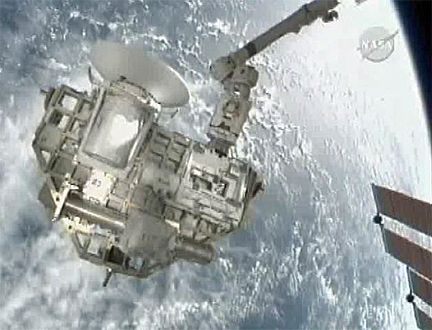
The integrated cargo carrier being moved from the shuttle
to the space station Sunday. The backup Ku-band antenna dish
and its support beam are visible. (Credit: NASA TV)
The second objective of the spacewalk is to install an enhanced spare parts storage platform on the Canadian special purpose dexterous manipulator, or DEXTRE, a hand-like robot arm attachment that can be used to install replacement components or service external experiments.
"The current one that's installed on DEXTRE can only handle one spare box," Stover said. "This new enhanced version is able to handle multiple boxes, so what Garrett and Steve are going to do is remove the old one, temporarily stow it on that on the space station and install the new one."
The backup antenna dish and its support beam, along with robot arm storage platform and six new solar array batteries, are mounted on the integrated cargo carrier. The carrier was pulled from the shuttle's cargo bay after docking Sunday and mounted on the robot arm transporter on the front side of the station's solar power truss.
After exiting the airlock, Reisman and Bowen will make their way to the cargo pallet and install foot restraints, one on the pallet itself and one of the robot arm. The eight-foot-long boom that will support the spare antenna will be removed from the pallet, and Reisman, riding on the end of the robot arm, will carry it to the Z1 truss atop the station's central Unity module.
The spacewalkers then will secure the boom with two bolts. While Bowen is making electrical connections, Reisman will ride the arm, operated by Piers Sellers from the new multi-window cupola, in a windshield wiper-like trajectory back to the cargo pallet to pick up the six-foot-wide Ku-band antenna.
"The dish is pretty fragile and we're instructed not to bump that into anything," Reisman said. "Piers is going to be operating the big arm, and I'll be standing on the end of it while we bring the dish out. At that point, the dish comes very close to the boom of the arm.
"The worrisome thing for me is I can't really see it because I have a big face full of dish, and the boom is on the other side. So I'll be counting on Piers to talk me through it and give me nice calls. We'll have to coordinate very carefully. It's definitely an area of concern."
Reisman, holding the dish, will follow another windshield wiper trajectory back to the top of the Z1 truss where Bowen will help move it into position before driving four bolts to hold it in place and hooking up two electrical connectors.
After installing insulation around the base of the antenna, Reisman will ride the arm back to the cargo pallet to retrieve an equipment stowage platform that will be attached to the Canadian special purpose dexterous manipulator, or SPDM, robot arm extension. The platform will be used down the road to temporarily hold components that are being replaced by the space crane.
Once the platform is in place the astronauts will turn their attention to a get-ahead task if time is available, loosening the bolts holding new solar array batteries to the cargo pallet.
"While the pallet's based on the truss there, we can actually break all the torque on the bolts with a ratchet wrench instead of using this heavy torque multiplier," Reisman said. "Just like lug nuts on your car, we can do it very quickly."
Bowen said the key to the first spacewalk is "a very intricate choreography."
"And the reason for that is using the arm to remove the pieces off the pallet and then taking them all over station to install them. ... I get to climb all over, he gets to fly all over. But the choreography is key to EVA-1. If the choreography works and the timing works out and we complete all the tasks on EVA-1, we will be well set up for EVA-2.
"Everything has to work," he said. "Any one of these EVAs, a single bolt can put everything behind. So we have to be very efficient and hopefully get through our tasks in a very nominal timeframe so the next piece is ready to go."
Here is an updated timeline of today's activity (in EDT and mission elapsed time; includes revision B of the NASA television schedule; best viewed with fixed-width font):
EDT........DD...HH...MM...EVENT 05/17 03:20 AM...02...13...00...Crew wakeup 04:00 AM...02...13...40...EVA-1: Airlock repress/hygiene break 04:45 AM...02...14...25...EVA-1: Airlock depress to 10.2 psi 04:50 AM...02...14...30...ISS daily planning conference 06:40 AM...02...16...20...EVA-1: Spacesuit purge 06:55 AM...02...16...35...EVA-1: Spacesuit prebreathe 07:10 AM...02...16...50...Docking playback 07:45 AM...02...17...25...EVA-1: Crew lock depressurization 08:15 AM...02...17...55...EVA-1: Spacesuits to battery power 08:20 AM...02...18...00...EVA-1: Egress 08:35 AM...02...18...15...EVA-1: Setup 08:45 AM...02...18...25...EVA-1: Pallet preps 09:40 AM...02...19...20...EVA-1 (Reisman): SGANT installation 10:05 AM...02...19...45...EVA-1 (Bowen): SGANT installation 12:20 PM...02...22...00...EVA-1 (Reisman): EOTP install 01:15 PM...02...22...55...EVA-1 (Bowen): EOTP install 01:50 PM...02...23...30...EVA-1 (Reisman): SSRMS cleanup 01:50 PM...02...23...30...EVA-1 (Bowen): Battery preps 02:15 PM...02...23...55...Cleanup and ingress 02:45 PM...03...25...00...EVA-1: Airlock repressurization 02:55 PM...03...35...00...Post-EVA servicing 03:45 PM...03...01...25...ISS daily planning conference 04:00 PM...03...01...40...Mission status briefing on NTV 04:15 PM...03...01...55...EVA tagup 06:20 PM...03...04...00...ISS crew sleep begins 06:50 PM...03...04...30...STS crew sleep begins 07:00 PM...03...04...40...Daily highlights reel
10:55 AM, 5/16/10, Update: Shuttle Atlantis docks with space station (UPDATED at 12:45 p.m. with hatch opening; UPDATED at 3 p.m. with mission status briefing)
The shuttle Atlantis, carrying a Russian docking module and critical spare parts, glided to a smooth docking with the International Space Station Sunday, capping a two-day orbital chase that began with blastoff Friday.
Piloting the shuttle from the aft flight deck, commander Kenneth Ham deftly guided the 120-ton spacecraft to a picture-perfect docking with the lab's forward port at 10:28 a.m. EDT as the 1-million-pound shuttle-station complex sailed 220 miles above the South Pacific Ocean.
"Houston and station, capture confirmed," pilot Dominic Antonelli radioed as the shuttle's payload bay docking mechanism engaged its station counterpart.
"Atlantis, station, ISS is in free drift," Japanese astronaut Soichi Noguchi replied. "And welcome to station." A few moments later, flight engineer Timothy Creamer rang the ship's bell in the forward Harmony module to formally announce Atlantis' arrival.
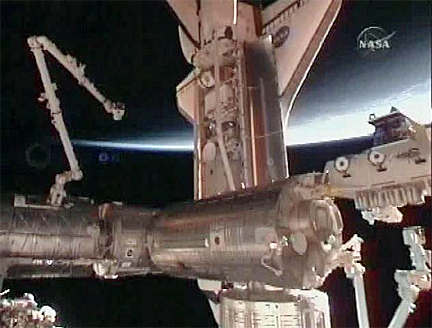
The shuttle Atlantis, moments after docking with the
International Space Station. (Credit: NASA TV)
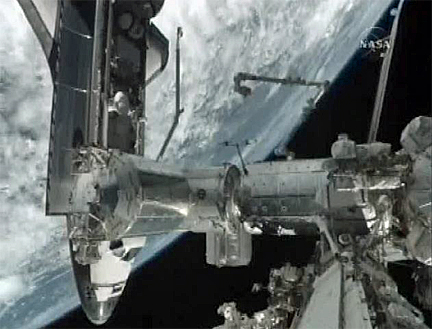
Atlantis and the space station against the limb of planet
Earth. (Credit: NASA TV)
It took a bit less than two hours to firmly lock the two spacecraft together and complete leak checks before hatches were opened at 12:18 p.m. and the station crew - Noguchi, Creamer, Expedition 23 commander Oleg Kotov, Tracy Caldwell Dyson, Alexander Skvortsov and Mikhail Kornienko - welcomed their shuttle colleagues aboard.
"And Houston, station, on the big loop, with Atlantis crew on board ISS," Kotov called down as the two crews shared hugs and handshakes in the forward Harmony module. "It is our pleasure to welcome them and to see them here. It's a really big event for us, bringing us a new Russian module to station."
With the exception of Michael Good, veteran of a Hubble Space Telescope servicing mission, the rest of the Atlantis crew - Ham, Antonelli, Stephen Bowen, Piers Sellers and Garrett Reisman - are veterans of at least one previous space station visit.
"For almost all of us on board Atlantis, we've been here before but it's bigger than we remember and speaking for myself, better than I remember," Ham said. "I love this place!"
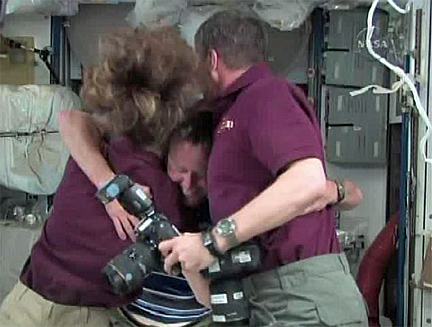
Shuttle commander Ken Ham, center, is embraced by station
astronauts Tracy Caldwell Dyson, left, and Timothy Creamer, right.
(Credit: NASA TV)
After a brief safety briefing from Kotov, the astronauts got back to work, transferring equipment to the lab and gearing up for a spacewalk Monday, the first of three planned for the mission.
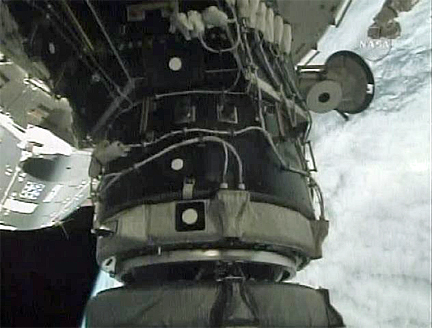
Latches engage to pull the space station and shuttle docking
systems together. (Credit: NASA TV)
Just before 3 p.m., Sellers and Caldwell Dyson used the station's robot arm to pull a cargo pallet out of the shuttle's payload bay so it could be mounted on a stowage fixture on the front side of the station's solar power truss. The cargo carrier holds a spare Ku-band dish antenna that will be installed by Reisman and Bowen during Monday's spacewalk, along with an equipment mounting platform that will be attached to a Canadian robot arm extension.
The cargo carrier also holds six 375-pound batteries that will be installed during the mission's second and third spacewalks.
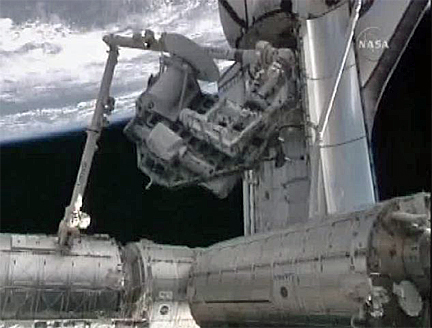
The integrated cargo carrier, holding a spare dish antenna
and solar array batteries, is moved to the space station.
(Credit: NASA TV)
Ham and company began the shuttle's final approach to the station with a rocket firing at 7:40 a.m. to begin closing the final 9.2. miles. Moving in to a point about 600 feet directly below the lab complex, Ham guided Atlantis through a spectacular 360-degree back-flip maneuver as the spaceplane sailed across southern Europe, exposing the shuttle's underside to the station.
Kotov and Creamer, using digital cameras equipped with powerful telephoto lenses, photographed the heat shield tiles on the belly of the orbiter while Caldwell Dyson focused on the shuttle's left wing leading edge panels.
The shuttle's carbon composite nose cap and wing leading edge panels, which experience the most extreme heating during re-entry, were inspected Saturday. But problems with a pan-and-tilt mechanism on the end of the shuttle's inspection boom forced the crew to use backup procedures and they were unable to complete the left wing.
Lead shuttle Flight Director Mike Sarafin said inspection procedures may be added to the crew's timeline later, depending on the quality of the photos shot by Caldwell Dyson during Sunday's approach.
"All of the images, roughly 400 digital still images, are on the ground, currently being assessed and analyzed," Sarafin said. "We expect those folks to meet later this evening to decide whether we need to go off and gather additional imagery to clear Atlantis' heat shield or if we have everything we need.
"We're looking at backup methods to use the shuttle's robotic arm in the event some of those activities do require arm support from the shuttle," he said. "The activities we have ahead of us tomorrow, with our first spacewalk as well as installation of the (Russian) Rassvet module, are going to be performed as planned. So any changes to the mission timeline will occur after the module is installed on flight day five."
Late last week, flight controllers began monitoring a piece of unidentified space debris that was expected to pass within a few miles of the station shortly after the shuttle docking.
Saturday evening, after additional radar tracking showed the debris would not pass close enough to cause any problems, plans for a possible avoidance maneuver were called off. Sarafin said Sunday the actual miss distance was about 10 statute miles, well outside the station's safety zone.
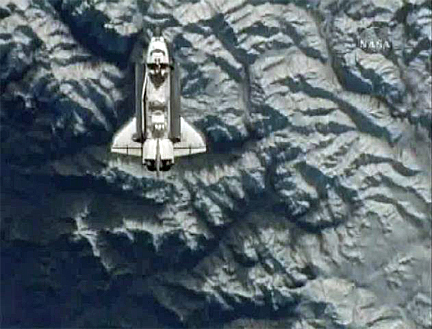
The shuttle passes above the Andes Mountains during final
approach to the space station. (Credit: NASA TV)
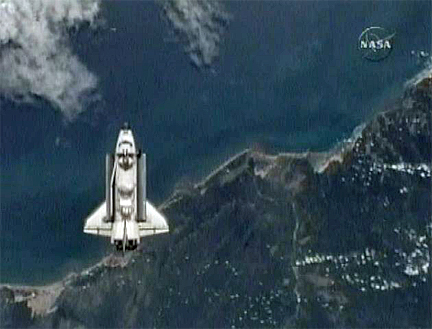
Atlantis crosses over the northeast coast of South America.
(Credit: NASA TV)
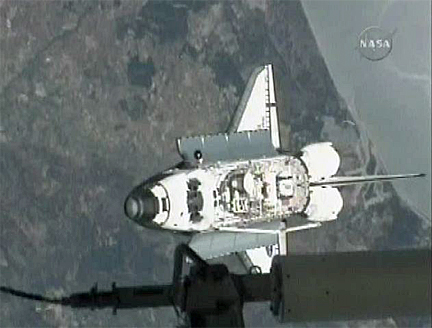
Atlantis above the Spain/Portugal coast. (Credit: NASA TV)

Atlantis performs a back-flip maneuver above southern France.
(Credit: NASA TV)

The shuttle above the Alps. (Credit: NASA TV)
7:15 AM, 5/16/10, Update: Atlantis closes in on space station
The shuttle Atlantis closed in on the International Space Station early Sunday as the astronauts worked through the final stages of a complex two-day rendezvous. Docking is expected around 10:27 a.m. EDT.
The terminal phase of the rendezvous was expected to begin around 7:40 a.m. with a critical rocket firing to start closing the final 9.2 miles to the space station.
Commander Kenneth Ham said before launch he was looking forward to seeing how the station has grown since his last visit in 2008.
"That first time, you get really busy in the cockpit during the rendezvous," he said in a NASA interview. "There's a whole bunch of stuff you need to get done and at some point in there you actually look out the window when you're close and you see this monstrosity that is out there orbiting the planet. There's that moment of 'Holy cow! What has humanity built up here?' It is amazing and I'm looking forward to that because the station's even bigger than it was last time I was there and it's just a neat thing to look at. It's a reality check."
Pausing about 600 feet directly below the lab complex, Ham plans to oversee a computer assisted 360-degree back-flip maneuver, exposing the shuttle's underside to the station and allowing the lab crew to photograph the protective tiles on the orbiter's belly to look for any signs of damage that might have occurred during launch Friday.
Expedition 23 commander Oleg Kotov, Soichi Noguchi and Timothy Creamer will focus on the heat shield tiles while flight engineer Tracy Caldwell Dyson will concentrate on the shuttle's left wing leading edge panels.
The shuttle's carbon composite nose cap and wing leading edge panels, which experience the most extreme heating during re-entry, were inspected Saturday. But problems with a pan-and-tilt mechanism on the end of the shuttle's inspection boom forced the crew to use backup procedures and they were unable to complete the left wing.
"All of the images will be loaded onto laptops for downlink to the ground in Houston for review by the imagery analysts and engineers to help clear the vehicle and ensure that we have no additional areas of interest that need further review," lead Flight Director Mike Sarafin said before launch.
Mission managers are still assessing what additional work will be required - and when it will be carried out - to complete the Saturday inspection work.
Following the rendezvous pitch maneuver, Ham will guide Atlantis up to a point about 300 feet directly in front of the station, with the shuttle's nose pointed toward deep space and its open cargo bay facing the lab's forward docking port.
"From there, he'll approach along a very narrow, two-and-a-half-degree corridor," Sarafin said. "Once he verifies final alignment at 30 feet, he'll press in and perform the docking."
Ham and his crewmates - pilot Dominic Antonelli, flight engineer Michael Good, Stephen Bowen, Piers Sellers and Garrett Reisman - will be welcomed aboard by Kotov, Noguchi, Creamer, Caldwell Dyson, Alexander Skvortsov and Mikhail Kornienko.
After a safety briefing, the crew will get back to work, transferring spacesuits and other gear needed for the mission's first spacewalk Monday. Sellers and Caldwell Dyson, meanwhile, will use the station's robot arm to pull a cargo pallet out of the shuttle's cargo bay and position it atop the station's power truss.
The integrated cargo carrier holds a spare Ku-band antenna, a support boom, an equipment stowage platform and six new batteries for one of the station's four sets of solar arrays. During a spacewalk Monday by Reisman and Bowen, the spare antenna will be installed, along with the equipment stowage platform.
"Aside from getting all the rendezvous tasks done, when we get on board we need to pull that ICC, that (cargo) rack, out of the payload bay which Piers and Tracy are going to do, pulling that out of the bay and sticking it up on top of space station in preparation for some further arm motions that the ground is going to take care of overnight," Ham said.
"All the while, we're getting our two first spacewalkers, which is Steve Bowen and Garrett Reisman, in the airlock ready for campout, getting their blood chemistry right, overnight to get ready to go out the door the next day. So there are an awful lot of things that have to happen and happen on time so that we can get to bed and get up the next day and go to work."
Here is an updated timeline of today's activity (in EDT and mission elapsed time; includes revision B of the NASA television schedule):
EDT........DD...HH...MM...SS>..EVENT 05/16 03:20 AM...01...13...00...00...STS/ISS crew wakeup 04:25 AM...01...14...05...00...Group B computer powerup 04:40 AM...01...14...20...00...Rendezvous timeline begins 04:50 AM...01...14...30...00...ISS daily planning conference 05:22 AM...01...15...02...07...NH rendezvous rocket firing 06:07 AM...01...15...47...35...NC-4 rendezvous rocket firing 07:30 AM...01...17...10...00...Spacesuit removal from airlock 07:40 AM...01...17...20...00...Ti rendezvous rocket firing 07:55 AM...01...17...34...51...US arrays configured for dock 08:05 AM...01...17...44...51...ISS Ku mask enabled 08:05 AM...01...17...44...51...ISS to prox ops mode 08:18 AM...01...17...57...51...Service module lights on 08:18 AM...01...17...58...31...Sunset 08:30 AM...01...18...09...51...ISS maneuver start 08:35 AM...01...18...14...51...ISS in docking attitude 08:38 AM...01...18...18...36...Range = 10000 ft 08:47 AM...01...18...27...16...Range = 5000 ft 08:52 AM...01...18...32...45...Range = 3000 ft 08:54 AM...01...18...33...51...SM lights off 08:54 AM...01...18...34...44...Sunrise 08:57 AM...01...18...36...54...MC4 rendezvous rocket firing 09:01 AM...01...18...40...54...Range = 1500 ft 09:06 AM...01...18...45...54...Range = 1000 ft 09:09 AM...01...18...48...54...KU to LO (800 ft) 09:10 AM...01...18...49...54...Shuttle directly below station (725 ft) 09:15 AM...01...18...55...06...Range = 600 ft 09:22 AM...01...19...02...22...Noon 09:26 AM...01...19...06...22...RPM start window open 09:26 AM...01...19...06...23...Start pitch maneuver 09:30 am...01...19...10...34...RPM full photo window close 09:34 am...01...19...14...23...End pitch maneuver 09:37 am...01...19...16...59...Initiate torva (575 ft) 09:39 am...01...19...18...58...RPM start window close 09:48 AM...01...19...27...51...Russian arrays feathered 09:48 AM...01...19...28...29...Shuttle directly in front of ISS (310 ft) 09:49 AM...01...19...29...19...Range = 300 ft 09:50 AM...01...19...29...59...Sunset 09:53 AM...01...19...33...29...Range = 250 ft 09:57 AM...01...19...37...39...Range = 200 ft 10:00 AM...01...19...40...09...Range = 170 ft 10:01 AM...01...19...41...49...Range = 150 ft 10:06 AM...01...19...45...59...Range = 100 ft 10:09 AM...01...19...48...59...Range = 75 ft 10:13 AM...01...19...53...09...Range = 50 ft 10:16 AM...01...19...56...29...Range = 30 ft; start stationkeeping 10:21 AM...01...20...01...29...Push to dock 10:25 AM...01...20...05...49...Range = 10 ft 10:26 AM...01...20...06...13...Sunrise 10:27 AM...01...20...07...28...DOCKING 10:40 AM...01...20...20...00...Leak checks 10:54 AM...01...20...33...51...Noon 11:10 AM...01...20...50...00...Orbiter docking system set for ingress 11:10 AM...01...20...50...00...Group B computer powerdown 11:21 AM...01...21...01...28...Sunset 11:40 AM...01...21...20...00...Hatch open 12:25 PM...01...22...05...00...Welcome aboard! 12:30 PM...01...22...10...00...Safety briefing 01:00 PM...01...22...40...00...Spacesuits moved to Quest 01:30 PM...01...23...10...00...SSRMS ICC grapple 01:30 PM...01...23...10...00...EVA-1: Equipment lock preps 01:40 PM...01...23...20...00...REBA checkout 01:50 PM...01...23...30...00...SSRMS ICC unberth 02:00 PM...02...23...40...00...Mission status briefing on NTV 02:20 PM...02...00...00...00...SSRMS installs ICC on POA 02:20 PM...02...00...00...00...EVA-1: Tools configured 03:15 PM...02...00...55...00...EVA-1: Procedures review 04:00 PM...02...01...40...00...Post-MMT briefing on NTV 04:25 PM...02...02...05...00...ISS evening planning conference 04:30 PM...02...02...10...00...Video playback ops 05:45 PM...02...03...25...00...EVA-1: Mask pre-breathe 06:20 PM...02...04...00...00...EVA-1: 10 psi campout begins 06:50 PM...02...04...30...00...ISS crew sleep begins 07:20 PM...02...05...00...00...STS crew sleep begins 08:00 PM...02...05...40...00...Daily highlights reel on NTV
6:25 PM, 5/15/10, Update: Debris avoidance maneuver ruled out
Additional radar tracking shows an unidentified piece of space debris expected to pass by the International Space Station early Sunday will not come close enough to require a protective avoidance maneuver.
Flight controllers had considered an overnight rocket firing to lower the station's orbit slightly and increase the miss distance between the debris and the lab complex. Earlier in the day, tracking indicated the object could pass within 6 miles or so of the station shortly after the shuttle Atlantis' scheduled 10:27 a.m. EDT docking Sunday.
But around 6 p.m. Saturday, flight controllers concluded the debris posed no threat to the station or the space shuttle and plans for an avoidance maneuver were called off.
4:45 PM, 5/15/10, Update: Astronauts use backup method to inspect heat shield; flight director confident all necessary data will be collected
The Atlantis astronauts used a less-capable backup sensor system to inspect the shuttle's carbon composite nose cap and wing leading edge panels today after an overly-tight cable prevented them from using a more sophisticated, steerable sensor package. The crew lost several hours troubleshooting the problem, but the lead flight director said he was confident all the necessary data would be collected when all was said and done.
"We've got some of the best engineers and imagery analysts on the planet supporting Atlantis," Mike Sarafin told reporters Saturday afternoon. "I'm confident that given a little bit of time, we'll come up with a solution that will cover the entire heat shield on Atlantis and we'll get there well in advance of when a decision is required to bring her home. We just need to give that process a little bit of time ... I'll bet you given a day, things will come together very quickly."
Space station flight controllers, meanwhile, continued to track a piece of unidentified space debris in a highly elliptical orbit that was projected to pass within about 6 miles of the space station shortly after Atlantis' planned docking Sunday around 10:27 a.m. EDT. Engineers were considering a rocket firing Saturday evening to lower the station's altitude by about 3,000 feet to eliminate any chance of a close encounter.
"We're kind of cutting it close as to whether we can dock and get structurally mated to the International Space Station and then into the docked attitude relative to this debris avoidance maneuver," Sarafin said. "We really can't get confident that if we need to get out of the way of this piece of space debris we'll be able to do that after the shuttle docks, just due to the timeline.
Given the five-mile-per-second orbital velocity of the space station, "just a small error in the amount of time we determine where something is could make a big difference in your total miss distance," Sarafin said. "A couple of seconds at that speed could mean you'd miss by a huge amount or you'd miss by a very little distance. That's being factored into the debris avoidance maneuver plan."
A decision on whether or not to maneuver the station was expected around 6 p.m.
As usual for post-Columbia shuttle missions, the Atlantis astronauts faced a busy second day in space Saturday with the heat shield inspection the most time-consuming activity. The idea was to scan the nose cap and leading edge panels, which experience the most heat during re-entry, with a steerable laser and camera system on the end of a 50-foot-long boom attached to the shuttle's robot arm.
But a cable interference issue prevented the sensor system's pan-and-tilt unit from working properly.
"We determined that we had quite literally run into a snag with the gimbal system on the end of the boom," Sarafin said. "One of the cables on the end of the boom is pulling taut and causing us to not be able to tilt our primary camera system fully up, which is affecting our ability to see all of the heat shield on Atlantis.
"So what we've done is, we've gone to a secondary mode, which is a different camera, it's a digital camera that is hard mounted to the boom, it doesn't sit on this pan-and-tilt unit, and we're proceeding with the inspection of the starboard wing, we completed that earlier today, we're currently in the process of scanning the nose cap and we expect to get the majority of the port wing later."
The secondary system can only be used during the daylight portions of each orbit and it was not clear whether the crew would be able to complete the inspection of the shuttle's left wing by the end of the day.
To fill in any gaps, station astronaut Tracy Caldwell Dyson plans to use a digital camera equipped with a powerful telephoto lens to photograph the parts of the left wing's leading edge during Atlantis' approach to the station Sunday.
Positioned 600 feet directly below the station, commander Ken Ham plans to guide Atlantis through a 360-degree back-flip maneuver to expose the shuttle's heat shield tiles to view. Station commander Oleg Kotov, Soichi Noguchi and Timothy Creamer already planned to photograph the shuttle's heat shield tiles from the station. Caldwell Dyson now will join them to photograph the left wing's leading edge panels.
"Once we get all that imagery on the ground, the team will determine if we need to go get additional information or views of Atlantis before we're ready to declare the heat shield ready to go or if we've got al of what we need," Sarafin said.
A block of time is available on flight day five for an additional "focused" inspection if necessary.
11:45 AM, 5/15/10, Update: Glitch delays heat shield inspection
A pinched cable in the pan-and-tilt mechanism of an instrument package on the end the shuttle Atlantis' 50-foot-long heat shield inspection boom threw a wrench into the crew's plans for inspecting the ship's carbon composite nose cap and wing leading edge panels Saturday.
It appears a cable is snagged in the mechanism, preventing a laser/camera scanning system from being correctly aimed. Flight controllers at the Johnson Space Center have asked the crew to use a different set of sensors that does not require such precise aiming and to follow a so-called "late inspection" protocol that focuses on the most critical areas of the shuttle, skipping other, less sensitive regions.
Additional inspections can be carried out, if necessary, after Atlantis docks with the International Space Station early Sunday. Today's delay will not have any impact on the rendezvous and docking timeline but it could stretch out the time needed for engineers to finish assessing the health of the heat shield.
6:10 AM, 5/15/10, Update: Heat shield inspection on tap
The Atlantis astronauts, awakened at 4:20 a.m. EDT to begin their first full day in space, plan to inspect the shuttle's carbon composite nose cap and wing leading edge panels Saturday and to check out equipment needed for upcoming spacewalks. Two rendezvous rocket firings are planned to fine tune the shuttle's approach to the International Space Station for a docking Sunday morning.
Space station flight controllers, meanwhile, are continuing to discuss a possible debris avoidance maneuver to increase the distance between the lab complex and a piece of space junk expected to fly past Sunday morning. If additional radar tracking indicates an avoidance maneuver is needed, it likely would be carried out remotely during crew sleep Saturday evening. A decision one way or the other is expected by 5 p.m.
The heat shield inspection, standard fare for post-Columbia shuttle crews, uses an instrumented 50-foot-long boom attached to the end of the ship's robot arm to scan the nose cap and wing leading edge panels to look for any signs of impact damage that might have occurred during the climb to space.
"Back in those first couple (post-Columbia) flights when they were doing this, this was considered a very difficult and unique robotics maneuver so a lot of attention was spent on it," commander Ken Ham said in a NASA interview. "Since those flights, we've flown a bunch more. We've a lot more confidence in how this works and at the risk of sounding cavalier ... that task is now almost considered somewhat mundane.
The heat shield inspection will be carried out by Ham, pilot Dominic Antonelli, Piers Sellers and Garrett Reisman. Crewmates Michael Good and Stephen Bowen will spend part of the day checking out spacesuits and other equipment needed for upcoming station assembly spacewalks. Later this afternoon, Reisman and Bowen will make sure the crew's rendezvous tools are set up for docking Sunday around 10:27 a.m.
"It's a little bit of a long day, a long inspection," Antonelli said of the heat shield examination. "We'll use the space shuttle's robotic (arm), and we'll pick up what we'll call the 'boom.' On the end of that there's a still camera, a laser camera and then also a video camera. We're going to use that to inspect the leading edge of both wings and the nose.
"It's a long series of automated robotic procedures. We'll put the arm and the boom in a starting configuration, hit 'go,' and it should run through an auto sequence kind of thing to scan the leading edge of the wings. We have to do the top, the front and the bottom so it'll be several of these in a row, and it'll take most of the day. We'll (take) turns either flying the arm or running the checklist or keeping the extra computers and data recording going. It's kind of a three-person job. Then we'll rotate out because it's a bit of a long day."
A mission status briefing is planned for 2 p.m., followed by a post-Mission Management Team briefing at 4 p.m. to provide a status report on the progress of work to access the shuttle's overall health following Friday's launch.
Here is an updated timeline of today's activity (in EDT and mission elapsed time; includes revision A of the NASA television schedule; best viewed with fixed-width font):
EDT........DD...HH...MM...EVENT 05/15 04:20 AM...00...14...00...Crew wakeup 06:25 AM...00...16...05...OMS pod survey 06:45 AM...00...16...25...Ergometer setup 07:15 AM...00...16...55...Shuttle arm (SRMS) unberths inspection boom (OBSS) 07:20 AM...00...17...00...Window 4 minicam downlink 07:33 AM...00...17...13...NC-2/NPC rendezvous rocket firing 07:40 AM...00...17...20...Spacesuit checkout preps 07:45 AM...00...17...25...SAFER emergency jetpack checkout 08:10 AM...00...17...50...Spacesuit checkout 08:30 AM...00...18...10...OBSS starboard wing survey 10:10 AM...00...19...50...Crew meals begin 10:15 AM...00...19...55...Middeck transfer preps 10:35 AM...00...20...15...OBSS nose cap survey 11:10 AM...00...20...50...Spacesuit prepped for transfer to station 12:25 PM...00...22...05...OBSS port wing survey 02:00 PM...00...23...40...Mission status briefing on NTV 02:40 PM...01...00...20...SRMS berths OBSS 02:45 PM...01...00...25...Rendezvous tools checkout 03:15 PM...01...00...55...Laser scan data (LDRI) downlink 03:55 PM...01...01...35...Centerline camera setup 04:00 PM...01...01...40...Post-MMT briefing on NTV 04:25 PM...01...02...05...Orbiter docking system ring extension 05:35 PM...01...03...15...NC-3 rendezvous rocket firing 07:20 PM...01...05...00...Crew sleep begins 08:00 PM...01...05...40...Daily highlights reel on NTV
2:50 PM, 5/14/10, Update: Shuttle Atlantis rockets into orbit (UPDATED at 6:30 p.m. with quotes, details)
The shuttle Atlantis blasted off on its 32nd and final planned mission Friday, closing out 25 years of service with a 12-day flight to deliver a Russian docking module and critical spare parts to the International Space Station.
With its three hydrogen-fueled main engines roaring at full thrust, the shuttle's twin solid-fuel boosters ignited on time at 02:20:09 p.m. EDT, instantly pushing the fully-fueled 4.5-million-pound spacecraft away from pad 39A.
Accelerating through 100 mph - straight up - in just eight seconds, Atlantis wheeled about its long axis and lined up on a trajectory paralleling the East Coast. Liftoff was timed for roughly the moment Earth's rotation carried the launch pad into the plane of the space station's orbit, the first step in a two-day rendezvous procedure.
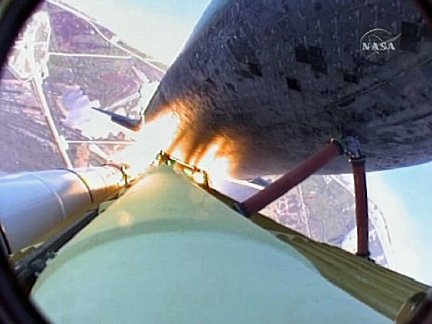
The Florida "Space Coast" drops away below the shuttle Atlantis
as the orbiter thundered toward orbit. (Credit: NASA TV)
Atlantis quickly arced away to the northeast, putting on a spectacular afternoon sky show for area residents and tourists who gathered along Florida's "Space Coast" to witness the shuttle's final planned flight.
Commander Kenneth Ham, pilot Dominic Antonelli and flight engineer Michael Good monitored the shuttle's computer-controlled ascent, joined by Stephen Bowen, a former submariner, Piers Sellers and Garrett Reisman, who spent three months aboard the space station in 2008.
"We're going to take her on her 32nd flight and if you don't mind, we'll take her out of the barn and make a few more laps around the planet," Ham radioed launch director Mike Leinbach a few minutes before takeoff.
The shuttle's ascent appeared normal with no obvious impacts from external tank foam insulation. Video from a camera mounted on the side of the tank showed a few bits of insulation separating and falling away, but by that point the shuttle was out of the dense lower atmosphere where debris impacts pose a more significant threat.
"Just wanted to let you know, the preliminary imagery and observation looks really clean, looks like another fantastic flight for Atlantis and the ET," astronaut Charles Hobaugh radioed from mission control after the shuttle reached orbit. "So that's good news. Of course, we'll find out a whole bunch more as we go on."
Later, as Hobaugh and the ascent team was going off shift in mission control, Ham radioed "This is one more fantastic ride for Atlantis, She's doing us proud."Engineers will spend several days assessing launch imagery, as well as photos taken from the shuttle and subsequent heat shield inspections before giving the ship a clean bill of health for re-entry.
"All the work that led up to this launch today was just phenomenal, the Atlantis team did a great job of processing the vehicle out at the launch pad," said Bill Gerstenmaier, chief of space operations for NASA. "The vehicle looks like it's in really clean shape, we're ready to go do a pretty challenging mission."
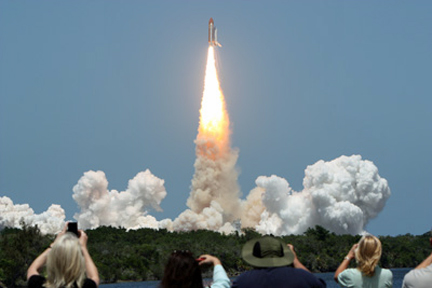
Atlantis climbs away from pad 39A. (Credit: Stephen Clark/Spaceflight Now)
The primary goals of the 132nd shuttle mission are to deliver the Russian Rassvet - "dawn" - docking module, to install a spare 6-foot-wide Ku-band dish antenna system and to replace six aging batteries in one of the station's four sets of U.S. solar arrays.
If all goes well, Ham will guide Atlantis to a docking at the space station's forward port Sunday morning. The exact time is a bit uncertain because of a possible close encounter with a piece of space debris an hour or so later that could force station flight controllers to carry out a protective debris avoidance maneuver. But no major problems were anticipated.
Ham and his crewmates will be welcomed aboard the station by Expedition 23 commander Oleg Kotov, Soichi Noguchi, Timothy Creamer, Alexander Skvortsov, Mikhail Kornienko and Tracy Caldwell Dyson.
Reisman, Good and Bowen will work in two-man teams for three planned spacewalks to install the backup antenna, the solar array batteries and other equipment. Sellers, who will operate the station's robot arm during the spacewalks, will assist Reisman on the arm during installation of the Russian mini-research module, or MRM-1, on the fifth day of the mission, the day after the first spacewalk.
The 17,760-pound mini-research module, or MRM, is packed with 3,086 pounds of NASA equipment and supplies and carrying an experiment airlock and European robot arm equipment that will be attached to other modules later.
Docked to the Earth-facing port of the central Zarya module, MRM-1 will bring additional pressurized volume for research and stowage and provide needed clearance between the forward Russian docking port and a U.S. storage module scheduled for attachment later this year.
The Russian module's docking system is virtually identical to the systems used by Progress and Soyuz spacecraft that dock with considerably more force than NASA typically employs. The station's robot arm cannot match that docking force, but by precisely centering the docking mechanisms, engineers are confident the Canadian space crane can get the job done.
"This module was originally designed to fly up, like all the other Russian modules, and dock under its own power, autonomously," Reisman said. "The way they do that is they have big cone (on one module) and a big probe (on the other), they get a good running start and it's almost like bringing train cars together.
"What we're trying to do here is very different. ... The arm can't get the kind of ramming speed it normally develops under its nominal means of docking. So we're going to be restricted to coming in approximately five times slower, and that's the fastest the arm can do safely.
"What we hope to do is have very fine control and have it come right down the middle. There are a lot of people who have worked really hard, did a lot of analysis to verify this is going to work. But the exciting thing is it's never been done before and so I'm sure we'll all be watching very carefully as we bring that in on flight day five."

The shuttle's open payload bay, showing the heat shield
inspection boom along the orbiter's starboard sill. (Credit: NASA TV)
MRM-1 complexities aside, the timelines for all three spacewalks are extremely tight and the excursions must be conducted in serial fashion.
During the first spacewalk on flight day four, Reisman and Bowen plan to install the backup Ku-band dish antenna atop an 8-foot-tall mast and mount an equipment support platform on a Canadian robot arm extension.
During the second spacewalk the day after the MRM-1 docking, Bowen and Good will begin work to replace six 365-pound nickel-hydrogen batteries on the far left end of the station's main power truss. The battery swap out will be completed during a third spacewalk by Reisman and Good.
"These aren't double As," Good joked before launch. "One of my brothers likes to give me a hard time about flying up in space and changing batteries, he thinks this is not a very difficult task, not a big deal. But these are like 400-pound nickel-hydrogen batteries, they're the size of a big suitcase, probably bigger than the airlines would let you take on without charging you extra. And they're pretty tricky. ... The alignment and the tolerances are very tight."
Atlantis is scheduled to undock from the station around 11:20 a.m. on May 23, setting up a landing back at the Kennedy Space Center around 8:44 a.m. on Wednesday, May 26.
While STS-132 is Atlantis' final planned mission, the shuttle will be processed for stand-by duty as an emergency rescue vehicle to support the shuttle Endeavour's launch late this year or early next on what is currently the program's final mission.
But NASA managers are considering the possibility of launching Atlantis on a final space station resupply mission after Endeavour's flight, using a reduced crew of four. A four-person crew could seek safe haven aboard the space station if necessary and rotate back to Earth aboard Russian Soyuz spacecraft, eliminating the need for a rescue mission.
NASA managers believe the benefits to the space station outweigh the marginal cost of the flight, but it remains to be seen whether such a mission will win the necessary political support. A decision is expected early this summer.
"I've personally asked the president that that's what he ought to do, fly one extra shuttle flight, because we've got the hardware, it's ready to go," said Sen. Bill Nelson, a Florida Democrat who flew aboard the shuttle Columbia in 1986.
"It sits for the remaining flights as a rescue shuttle and when you would fly it as the last flight, the risk would be (minimal) because even if something happened that you couldn't return to Earth, they could take safe harbor on the space station.
"So I think NASA is seriously considering it and I'm going to continue to press the White House that they ought to approve it," Nelson said.
11:10 AM, 5/14/10, Update: Astronauts board shuttle
Commander Ken Ham and his five crewmates began strapping in aboard the shuttle Atlantis today for blastoff at 2:20:09 p.m. EDT on a 12-day space station assembly mission. The shuttle is fully fueled, there are no technical problems of any significance and the weather appears favorable.
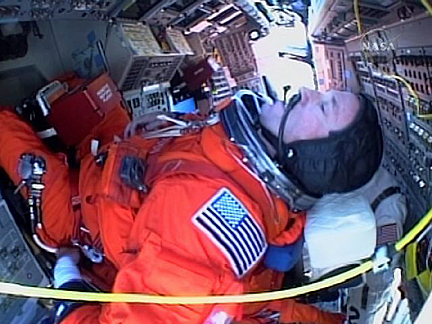
Commander Ken Ham straps into his seat aboard Atlantis. (Credit: NASA TV)
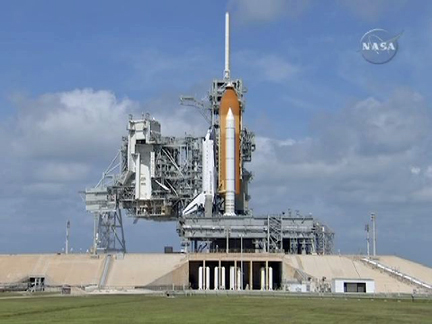
The shuttle Atlantis at pad 39A. (Credit: NASA TV)
The astronauts departed crew quarters at the Kennedy Space Center around 10:30 a.m. and reached the pad shortly before 11 a.m. After a quick look at the shuttle from the deck of the launch pad, the crew headed up the gantry to begin strapping in for launch.
Flight controllers in Houston, meanwhile, are assessing a possible close encounter with space debris Sunday morning, about an hour after Atlantis' planned docking. It is not yet clear whether an avoidance maneuver may be necessary, but controllers do not anticipate any major problems.
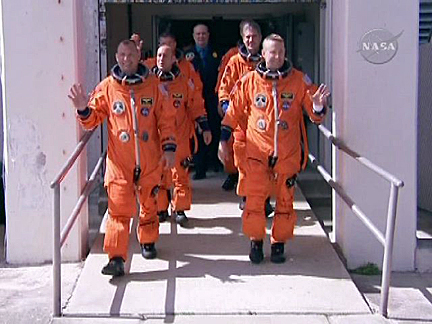
The Atlantis astronauts depart crew quarters and head for the pad.
(Credit: NASA TV)
8:15 AM, 5/14/10, Update: Shuttle fueling complete
The shuttle Atlantis' external tank has been loaded with some 535,000 gallons of supercold liquid oxygen and hydrogen rocket fuel. The three-hour procedure was completed at 7:56 a.m. EDT and engineers transitioned to "stable replenish" mode as the countdown entered a planned two-hour 30-minute hold. There are no technical problems of any significance at pad 39A and launch remains on track for 2:20:09 p.m.
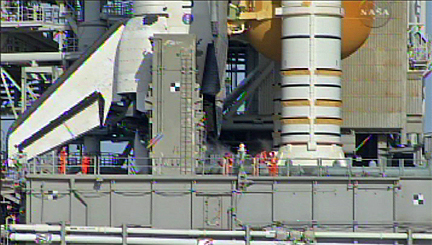
The shuttle Atlantis, fueled for launch. (Credit: NASA TV)
The official forecast remains 70 percent "go" with the only concern being a chance for low clouds to develop that might violate NASA's safety rules. But NASA commentator Allard Beutel said the forecast may improve slightly as the morning wears on.
5:15 AM, 5/14/10, Update: Shuttle fueling begins
Engineers began pumping a half-million gallons of liquid oxygen and hydrogen rocket fuel into the shuttle Atlantis' external tank early Friday, setting the stage for blastoff at 2:20:09 p.m. EDT on a space station assembly mission. Forecasters are continuing to predict a 70 percent chance of good weather.
The fueling procedure began on time at 4:55 a.m. when the supercold propellants began flowing through transfer lines to the shuttle atop launch pad 39A. If all goes well, the tank should be topped off and in "stable replenish" mode by around 8 a.m.
Commander Kenneth Ham, pilot Dominic Antonelli, flight engineer Michael Good, Stephen Bowen, Piers Sellers and Garrett Reisman plan to begin strapping in around 11 a.m. to await liftoff on the 132nd shuttle mission.
Here is a timeline of major events through the remainder of today's countdown (in EDT):
EDT...........EVENT 07:55 AM......Begin 2-hour 30-minute built-in hold (T-minus 3 hours) 07:55 AM......Closeout crew to white room 07:55 AM......External tank in stable replenish mode 08:10 AM......Astronaut support personnel comm checks 08:40 AM......Pre-ingress switch reconfig 09:00 AM......NASA TV launch coverage begins 09:55 AM......Final crew weather briefing 10:00 AM......Crew suit up begins 10:25 AM......Resume countdown (T-minus 3 hours) 10:30 AM......Crew departs O&C building 11:00 AM......Crew ingress 11:50 AM......Astronaut comm checks 12:15 PM......Hatch closure 12:45 PM......White room closeout 01:05 PM......Begin 10-minute built-in hold (T-minus 20m) 01:15 PM......NASA test director countdown briefing 01:15 PM......Resume countdown (T-minus 20m) 01:16 PM......Backup flight computer to OPS 1 01:20 PM......KSC area clear to launch 01:26 PM......Begin final built-in hold (T-minus 9m) 01:56:09 PM...NTD launch status verification 02:11:09 PM...Resume countdown (T-minus 9m) 02:15:09 PM...Orbiter access arm retraction 02:15:09 PM...Launch window opens 02:15:09 PM...Hydraulic power system (APU) start 02:15:14 PM...Terminate LO2 replenish 02:16:09 PM...Purge sequence 4 hydraulic test 02:16:09 PM...IMUs to inertial 02:16:14 PM...Aerosurface profile 02:16:39 PM...Main engine steering test 02:17:14 PM...Liquid oxygen tank pressurization 02:17:34 PM...Fuel cells to internal reactants 02:17:39 PM...Clear caution-and-warning memory 02:18:09 PM...Crew closes visors 02:18:12 PM...Hydrogen tank pressurization 02:19:19 PM...Booster joint heater deactivation 02:19:38 PM...Shuttle computers take control of countdown 02:19:48 PM...Booster steering test 02:20:02 PM...Main engine start (T-6.6 seconds) 02:20:09 PM...Booster ignition (LAUNCH) 02:22:38 PM...Trans-Atlantic abort option available 02:24:51 PM...Abort to orbit option available 02:26:36 PM...Normal orbit achievable with two engines 02:28:32 PM...Main engine cutoff 02:57:00 PM...OMS-2 orbit circularization rocket firing 03:15:00 PM...Post-launch news conference 03:45:00 PM...Payload bay door opening 05:54:00 PM...NC-1 rendezvous rocket firing 06:20:00 PM...Robot arm powerup and checkout 07:00:00 PM...External tank photography downlink 08:20:00 PM...Crew sleep begins
11:35 AM, 5/13/10, Update: Countdown on track; weather still 70 percent 'go'
The shuttle Atlantis' countdown continues to tick smoothly toward launch Friday on a space station assembly mission. There are no technical problems of any significance at pad 39A and forecasters continue to expect a 70 percent chance of good weather.
Launch on the 132nd shuttle mission - the final planned flight for Atlantis - is targeted for 2:20:08 p.m. EDT, roughly the moment Earth's rotation carries launch complex 39A into the plane of the International Space Station's orbit.
The primary goals of the 12-day, three-spacewalk mission are to deliver and install a Russian research and docking module, to install a backup Ku-band antenna system and to replace six aging solar array batteries.
"We've had a very clean countdown so far," said NASA Test Director Jeremy Graeber. "We're currently on schedule and we're not working any issues."
Forecasters are predicting a 70 percent chance of good weather Friday, Saturday and Sunday with the primary concern being a possibility for low clouds to develop that could violate NASA's flight rules.
"We're looking for scattered skies once again, winds will be out of the east peaking at 18 knots," said shuttle weather officer Todd McNamara. "One thing I am a little concerned with is if we get some additional low-level convergence, we could see some of those areas of clouds be fairly large and ... we could see a low-cloud ceiling. So because of those low-cloud ceilings, we're looking at a 30 percent chance of weather prohibiting launch here at KSC."Engineers plan to retract a protective service structure starting around 5:30 p.m., exposing Atlantis to view and setting the stage for fueling. The three-hour procedure to pump a half-million gallons of liquid oxygen and hydrogen rocket fuel into the shuttle's external tank is scheduled to begin around 4:55 a.m. Friday.
Assuming no problems develop, commander Kenneth T. Ham, pilot Dominic A. Antonelli, flight engineer Michael T. Good, Stephen G. Bowen, Piers J. Sellers and Garrett E. Reisman will depart crew quarters at 10:30 a.m. and to begin strapping in for launch a half hour later.
Graeber said Atlantis has enough on-board hydrogen and oxygen to power the ship's electricity producing fuel cells for four launch attempts through May 18. If launch is scrubbed Friday, he said, NASA likely would make a second attempt Saturday before standing down 48 hours to top off the fuel cell system.
"We have enough on-board fuel cell reactants to get four launch attempts in five days, and that's using our standard 24- and 48-hour scrub-turnaround options," Graeber said.
As it now stands, if Atlantis is not off the pad by May 18, the flight will be delayed to June 29 because of conflicts with other rocket launches and temperature constraints related to the space station's orbit.
In the meantime, "teams are busy retracting access platforms and configuring the pad for launch," Graeber said. "The countdown is proceeding very well and we're not tracking any issues. The hard work and dedication of everyone involved with STS-132 has gotten us to this point and all our systems are 'go' to proceed. We're looking forward to a spectacular launch tomorrow afternoon."
01:45 PM, 5/12/10, Update: STS-132 mission preview
The shuttle Atlantis is poised for launch Friday on its 32nd and final planned mission, a three-spacewalk flight to the International Space Station to install a new Russian module, a backup Ku-band dish antenna and six massive batteries to replace aging power packs in one of the station's solar arrays.
The shuttle's six-man, all-veteran crew also will deliver needed supplies and equipment as NASA stages its final three shuttle missions to complete the assembly of the lab complex by late this year or early next.
"Twelve days, three EVAs, tons of robotics, we're putting on spares that will make us feel good about the long-term sustainability of ISS, we're replacing batteries that have been up there for a while, docking a Russian-built ISS module," said shuttle Program Manager John Shannon. "This flight has a little bit of everything.
On board for the 132nd shuttle mission will be commander Kenneth T. Ham, pilot Dominic A. Antonelli, flight engineer Michael T. Good, Stephen G. Bowen, Piers J. Sellers and Garrett E. Reisman, who spent three months aboard the space station in 2008.
Reisman, Good and Bowen will work in two-man teams for three planned spacewalks to install the backup antenna, the solar array batteries and other equipment. Sellers, who will operate the station's robot arm during the spacewalks, will assist Reisman on the arm during installation of the Russian mini-research module, or MRM-1, on the fifth day of the mission.
The 17,760-pound MRM-1, also known as "Rassvet," is packed with 3,086 pounds of NASA equipment and supplies and carrying an experiment airlock and European robot arm equipment that will be attached to other modules later. Docked to the Earth-facing port of the central Zarya module, MRM-1 will bring additional pressurized volume for research and stowage and provide needed clearance between the forward Russian docking port and a U.S. storage module scheduled for attachment later this year.
The Russian module's docking system is virtually identical to the systems used by Progress and Soyuz spacecraft that dock with considerably more force than NASA typically employs. The station's robot arm cannot match that docking force, but by precisely centering the docking mechanisms, engineers are confident the Canadian space crane can get the job done.
"This module was originally designed to fly up, like all the other Russian modules, and dock under its own power, autonomously," Reisman said. "The way they do that is they have big cone (on one module) and a big probe (on the other), they get a good running start and it's almost like bringing train cars together. I was inside the station a couple of times when dockings occurred and you can feel her come in. It's definitely an event.
"What we're trying to do here is very different. ... They call it 'mini' but like many things, it's actually very big," said Reisman, who stands 5 feet 4 inches tall and is jokingly known as "Big G." "To have it on the very end of the arm, with the arm fully extended, there are a lot of dynamics at play. So the arm can't get the kind of ramming speed it normally develops under its nominal means of docking. So we're going to be restricted to coming in approximately five times slower, and that's the fastest the arm can do safely.
"What we hope to do is have very fine control and have it come right down the middle. There are a lot of people who have worked really hard, did a lot of analysis to verify this is going to work. But the exciting thing is it's never been done before and so I'm sure we'll all be watching very carefully as we bring that in on flight day five."
Ham will be watching very carefully indeed. Making his first flight as a shuttle commander, he said "I hope that I'm the only person who's a little concerned about it, but I have to be, it's my job to worry."
"I think everything's going to work out just fine," he told CBS News. "But with any 'first' that you do, and this is the test pilot speaking, you've got to wonder about what is it that hasn't been thought about yet. And there are potentials in this scenario trying to get this on there with the arm. That makes it different."
MRM-1 complexities aside, the timelines for all three spacewalks are extremely tight and the excursions must be conducted in serial fashion.
During the first spacewalk on flight day four, Reisman and Bowen plan to install the backup Ku-band dish antenna atop an 8-foot-tall mast and mount an equipment support platform on a Canadian robot arm extension. During the second spacewalk, Bowen and Good will begin work to replace six 365-pound nickel-hydrogen batteries on the far left end of the station's main power truss.
"These aren't double As," Good said. "One of my brothers likes to give me a hard time about flying up in space and changing batteries, he thinks this is not a very difficult task, not a big deal. But these are like 400-pound nickel-hydrogen batteries, they're the size of a big suitcase, probably bigger than the airlines would let you take on without charging you extra. And they're pretty tricky. ... The alignment and the tolerances are very tight."
Again, the robot arm will be fully extended to position the battery pallet near the work site while Bowen and Good, and then Good and Reisman, swap out the batteries using new spacesuit gear specially modified to minimize the risk of electric shocks.
"EVA-1 is packed," Ham said. "Any little thing that goes wrong will slow the rest of the EVA down and it puts us in a very vulnerable spot. ... I don't want this to sound the wrong way, but it is a house of cards. if you don't get all the cards to line up just right, then all the EVAs fall apart. I trust these guys, they're awesome, they're great. But there are aspects of it that are mechanical that they cannot foresee or counter when they go wrong."
Launch from pad 39A at the Kennedy Space Center is targeted for 2:20:08 p.m. EDT, roughly the moment Earth's rotation carries the firing stand into the plane of the space station's orbit. If all goes well, Ham will guide the shuttle to a docking with the space station's forward port around 10:27 a.m. on Sunday, May 16.
The next day, Reisman and Bowen will stage the first spacewalk, followed by installation of MRM-1. The second spacewalk is targeted for May 19 with the third on May 21. Atlantis is scheduled to undock from the station around 11:20 a.m. on May 23, setting up a landing back at the Kennedy Space Center around 8:44 a.m. on Wednesday, May 26.
FINAL PLANNED FLIGHT FOR ATLANTIS
This will be Atlantis' final planned mission before the shuttle fleet is retired at the end of the year.
As of this writing, NASA plans to launch the shuttle Discovery on its final flight around Sept. 16 to deliver more supplies and equipment to the space station, along with a cargo module that is being modified to remain permanently attached to the lab.
The shuttle Endeavour is slated to close out the program in late November, delivering a $1.5 billion physics experiment to the station. Endeavour's flight could end up slipping to late February because of conflicts with other station missions and temperature constraints related to the station's orbit. NASA managers say they can stretch shuttle funding to late February if necessary without any additional appropriations from Congress.
As with all post-Columbia missions, NASA will be prepared to launch a shuttle rescue mission in case of any major problems that might prevent a crew from safely returning to Earth. For the final mission in November, Atlantis is the launch-on-need shuttle and it will be processed for flight as if it will actually fly.
And it just might get a "last hurrah," as veteran astronaut Jerry Ross put it during a recent news conference.
NASA managers are holding out hope they can win approval to launch Atlantis next spring or summer on what would really be the shuttle program's final mission, a flight to deliver a final load of supplies and critical equipment to the station. By launching Atlantis with a crew of four, NASA could avoid the need for a launch-on-need mission, using the space station as a safe haven until the crew could be rotated home aboard Russian Soyuz spacecraft.
Because of the projected multi-year gap between the shuttle's retirement and the debut of commercial rockets and cargo ships needed to replace it, NASA managers want to take advantage of every possible shuttle launch opportunity to stock the lab with supplies. One shuttle launch can carry the equivalent of multiple Russian, European and Japanese cargo flights.
While it is not yet clear whether Atlantis will get another flight - a decision is needed by the end of June or thereabouts - engineers have been marking the shuttle's processing milestones as if the current mission is, in fact, its last.
"I would liken it to the final season of a champion athlete," said Mike Sarafin, lead shuttle flight director for STS-132. "When a champion athlete announces their retirement, folks show up in large numbers to show their respect for that athlete. And we're seeing that right now with the space shuttle program, we're seeing a lot of interest from the public showing up for not only the launches, but also the other events, the rollout from the VAB to the launch pad, the landings. It's just an increase and an upswell in public interest and public support.
"That doesn't take away from the fact that we need to retire the space shuttle program. We are in the ninth inning. There is a possibility we'll have a launch-on-need flight, STS-135. Atlantis may go into extra innings, we don't know. We'll see how all that plays out."
Whatever the outcome, "she's been around a long time and a lot of us have known that ship for 25 years," said Launch Director Michael Leinbach. "So it'll be bittersweet to be sure."
"She's flown 31 times already, 115 million miles ... about a third of her design life," he said. "But our mission is coming to an end, so we're coming to grips with that. The team is very professional. We know it's the last one, probably, but that doesn't affect the way we process or launch this thing. We're going to do it safely and surely and we hope we do it next Friday."
ASTRONAUTS FACE TIGHT TIMELINE, CHALLENGING SPACEWALKS
As with all post-Columbia missions, the Atlantis astronauts will spend the second day of the mission carrying out an extensive inspection of the shuttle's reinforced carbon carbon nose cap and wing leading-edge panels, which experience the most extreme heating during re-entry, to make sure nothing was damaged during the climb to space.
Engineers on the ground, meanwhile, will be assessing launch-day video and still imagery, including footage from a camera mounted on the external tank, to look for any signs of foam insulation that might have come off, posing an impact threat.
On the third day of the mission, Ham will guide Atlantis to a point about 600 feet directly below the lab complex before executing a 360-degree back-flip maneuver to expose the shuttle's heat shield tiles to the station. Expedition 23 commander Oleg Kotov and flight engineer Timothy Creamer will photograph Atlantis' belly using digital cameras with powerful telephoto lenses to look for any signs of damage.
With the rendezvous pitch maneuver, or RPM, complete, Ham plans to guide Atlantis up to a point directly in front of the station before moving in for a docking with pressurized mating adaptor No. 2 on the front of the Harmony module.
"Rendezvous day is a great day," Ham said in a NASA interview. "I am really looking forward to that one, not just because I get to fly the orbiter this time. That first time, you get really busy in the cockpit during the rendezvous. There's a whole bunch of stuff you need to get done and at some point in there you actually look out the window when you're close, and you see this monstrosity that is out there orbiting the planet.
"There's that moment of 'Holy cow! What has humanity built up here?' It is amazing, and I'm looking forward to that because the station's even bigger than it was last time I was there, and it's just a neat thing to look at. ItŐs a reality check."
Waiting to welcome Ham and his crewmates aboard will be Kotov, Creamer, Soichi Noguchi, Tracy Caldwell Dyson, Alexander Skvortsov and Mikhail Kornienko. Kotov, Creamer and Noguchi are scheduled to return to Earth aboard the Soyuz TMA-17 spacecraft on June 1. They will be replaced by Douglas Wheelock, Shannon Walker and Fyodor Yurchikhin, who are scheduled for launch aboard Soyuz TMA-19 on June 15.
After a brief welcome aboard, the Atlantis astronauts will get to work. The first item on the agenda is for Sellers and Caldwell Dyson, operating the station's robot arm, to pull a pallet carrying the new high-gain antenna and solar array battery packs out of the shuttle's cargo bay. The pallet, called the integrated cargo carrier, or ICC, will be temporarily mounted on an attachment fitting at the base of a cart that moves the robot arm from point to point on the front of the solar power truss.
At the end of the day, Reisman and Bowen will "camp out" in the station's Quest airlock module at a reduced pressure of 10.2 pounds per square inch to help purge nitrogen from their bloodstreams. That will help prevent the bends when the astronauts spend the day working in NASA's 5-psi spacesuits.
"This mission is all rush, rush, rush," Reisman said. "It's going to be action packed. It was originally designed for one of the missions that has the capability to get power from the space station, so those vehicles can stay longer. We have the same content, the same mission to accomplish, but less time to do it in because Atlantis can't get power from the space station.
"So we're going to do our first spacewalk the day after we get there. We're going to arrive at the space station, we'll go inside for the first time then bam, we go inside the airlock, lock myself in with Steve and start doing our campout."
COMPLEX SPACEWALKS ON TAP
For the first spacewalk, Bowen, call sign EV-1, will be wearing a suit with red stripes around the legs. Reisman, EV-2, will be wearing an unmarked suit.
After exiting the airlock, the spacewalkers will make their way to the cargo pallet and install foot restraints, one on the pallet itself and one of the robot arm. The eight-foot-long boom that will support the spare antenna will be removed from the pallet, and Reisman, riding on the end of the robot arm, will carry it to the Z1 truss atop the station's central Unity module.
The spacewalkers then will secure the boom with two bolts. While Bowen is making electrical connections, Reisman will ride the arm in a windshield wiper-like trajectory back to the cargo pallet to pick up the six-foot-wide Ku-band antenna.
"The dish is pretty fragile and we're instructed not to bump that into anything," Reisman said. "Piers is going to be operating the big arm, and I'll be standing on the end of it while we bring the dish out. At that point, the dish comes very close to the boom of the arm.
"The worrisome thing for me is I can't really see it because I have a big face full of dish, and the boom is on the other side. So I'll be counting on Piers to talk me through it and give me nice calls. We'll have to coordinate very carefully. It's definitely an area of concern."
Reisman, holding the dish, will follow another windshield wiper trajectory back to the top of the Z1 truss where Bowen will help move it into position before driving four bolts to hold it in place and hooking up two electrical connectors.
After installing insulation around the base of the antenna, Reisman will ride the arm back to the cargo pallet to retrieve an equipment stowage platform that will be attached to the Canadian special purpose dexterous manipulator, or SPDM, robot arm extension. The platform will be used down the road to temporarily hold components that are being replaced by the space crane.
Once the platform is in place the astronauts will turn their attention to a get-ahead task if time is available, loosening the bolts holding the new batteries to the cargo pallet.
"While the pallet's based on the truss there, we can actually break all the torque on the bolts with a ratchet wrench instead of using this heavy torque multiplier," Reisman said. "Just like lug nuts on your car, we can do it very quickly."
Bowen said the key to the first spacewalk is "a very intricate choreography."
"And the reason for that is using the arm to remove the pieces off the pallet and then taking them all over station to install them. ... I get to climb all over, he gets to fly all over. But the choreography is key to EVA-1. If the choreography works and the timing works out and we complete all the tasks on EVA-1, we will be well set up for EVA-2.
"Everything has to work," he said. "Any one of these EVAs, a single bolt can put everything behind. So we have to be very efficient and hopefully get through our tasks in a very nominal timeframe so the next piece is ready to go."
With the first spacewalk out of the way, the astronauts will work the next day to install MRM-1, one of the more challenging robot arm tasks yet attempted by a station assembly crew.
There are two aspects to the docking procedure that are unusual, at least from NASA's perspective.
First, the module will be mated at a much lower velocity - five times slower - than typically used by Russian Progress and Soyuz spacecraft.
Second, commanding to the active side of the docking mechanism, inside the MRM-1 module, will be routed from a laptop computer in the U.S. segment of the station to a Russian central computer and then back through an ethernet link to the station's robot arm. Signals will move down the arm, through an electrically powered grapple fixture on the hull of the new module and then to an internal Russian computer.
On the positive side, Reisman and Sellers will be operating the arm and sending computer commands from the station's new multi-window cupola observation deck attached to the Tranquility module. Up until this point, the arm was operated from inside the Destiny lab module, using indirect television views to provide operators with views of various work sites.
For the MRM-1 installation, the arm will be operated from inside the cupola, giving Reisman and Sellers a direct view of the module and the Russian docking port where it will be installed.
"This is going to be something," Sellers said. "Because up to now, the operators of the arm have never seen it, they've only watched it all on their TV screens. This is going to be kind of a first in that I'll be able to look out the window and see what I'm doing directly. Not all the time, but some of the time.
"I think it makes a huge difference. Seeing it with your own eyes and being able to scan left and right and see the whole length of the arm makes a big difference. With TV, you can pan it this way, tilt it up a bit in order to look around. But somehow, to be able to see something with your own eyes, move your head around and look at it, seems to make a better model inside your head of whatever it is you're looking at. We're not looking at the toenail of the elephant here, we're seeing the whole elephant."
The direct view will help, but first, commanding through the Russian computer system must work properly.
"Getting data, power, communications, all of that is going through the arm," said station Flight Director Emily Nelson. "But the control goes from a laptop at the cupola robotic work station that Piers will be running that's connected through our ethernet connections on board all the way back to the Russian central computer and then comes back through the same ethernet connections, through the arm and into MRM-1. So all of that data's going through a pretty long path to get to where it's headed, which is new and different.
"Also, and I don't know how many of you have watched Progress and Soyuz dockings, but those vehicles don't come in slowly, they come in with quite a bit of force. There's a great deal of spring force in the probe head of the docking probe that has to be overcome, so we've also worked hard to ensure we've got the right rates on the arm, that the arm has sufficient rates to overcome those spring forces so that we can actually get the docking probe into the docking cone for the first physical mate."
The Russian docking system was designed to be tolerant of alignment errors. The approaching spacecraft's docking system features a long probe designed to fit into a cone-shaped receptacle on the target docking port. Once the probe is captured, hooks and latches are activated to firmly pull the two modules together.
"One of the reasons it's designed to bang together is then you can have tremendous errors in your alignment," Reisman said. "The receiving end is shaped like a cone. If you hit the side, with that momentum, the (probe) will just slide down the cone and end up in the hole."
The astronauts jokingly call themselves the "Rassvet rammers." But the station's robot arm cannot drive MRM-1's probe into the docking cone on the Zarya module with the same amount of force. It makes up for that with high precision.
"Even though we're coming in five times slower, if we come in five times more accurately - which puts a lot of pressure on me! - (it will work)," Reisman said.
Ham and Antonelli, operating Atlantis' robot arm, will pull MRM-1 from the shuttle's cargo bay and hand it off to the station arm, operated by Reisman. He then will maneuver it into position and attempt a docking.
"The first time, we're just going to go at ramming speed and try to bring her down as close to the center as possible," Reisman said. "That's basically the idea, to try to mimic what it is designed to do, which is go in as fast as possible. If that doesn't work, we have a couple of different options."
One such option involves disabling software that compares what the arm operator is commanding and what the arm is actually doing, automatically correcting for misalignments.
"Sometimes when you're up against structure that can actually get you into a little bit of a force fight," Reisman said. "So what we'll do the second time if it doesn't work when it's on, we're going to turn that algorithm off for the second attempt. And then finally, we'll come in at a slower speed but hopefully with a more fine alignment and hopefully some combination of those attempts will do the trick."
The module cannot be left at the station if the docking systems fail to properly engage. In that case, MRM-1 would be returned to the shuttle's cargo bay for return to Earth. But mission managers are confident it won't come to that.
Assuming a successful docking, the station crew will be in no rush to open MRM-1 and begin unloading the NASA supplies and equipment that are stored inside. Because of the tight timeline for the Atlantis astronauts, that work is planned for after the shuttle departs.
The day after MRM-1 is installed - flight day six - Bowen and Good (EV-3), wearing an unmarked spacesuit, plan to stage a six-and-a-half-hour spacewalk to begin replacing the batteries on the P6 solar array at the far left end of the station's power truss. The batteries are charged during daylight and provide the station's electrical power during orbital darkness.
The P6 array, one of four attached to the station's main truss, was launched in November 2000. Six of its batteries were replaced during a shuttle flight in July 2009 and the other six, well past their 6.5-year design life, will be replaced during Atlantis' mission.
The new batteries will be carried aloft attached to the integrated cargo carrier. In another challenging bit of robotics, Sellers will extend the station's robot arm to its maximum length to get the pallet as close as possible to the P6 array.
"This whole battery R & R is like a shell game, or one of those puzzles where you move the numbers around," said Lisa Shore, the lead spacewalk officer for Atlantis' mission. "The first thing you need to do is create an open spot to start the shuffle. So we'll install some handling aids onto the first battery we intend to remove. We're also going to install a ball stack, it's a metal tether that can be rigidized to temporarily stow the battery during the EVAs."
Good will be responsible for removing batteries from the truss and installing their replacements while Bowen moves batteries to and from the cargo carrier. After the first battery is removed from P6 and mounted on the ball stack, Bowen will pull a replacement battery from the cargo carrier. Both astronauts will carefully maneuver the massive power pack into place, taking special care not to damage fragile cooling fins on the back side.
Once the new battery is in place and electrically connected, the astronauts will move the old battery from its temporary mounting point and install it in the cargo carrier for return to Earth. That process will continue until at least three and possibly four batteries are installed. The remainder will be installed during the third and final spacewalk on flight day eight.
"It's all about batteries," Good said. "We're doing six of them on this flight and I get to do them all, with Steve on one EVA and Garret on the other. We've got to get them all done. They come up on a pallet in the shuttle's payload bay, the arm gets them out there to the very end of the truss on the space station, out there amongst the solar arrays. And that's probably got my biggest concern spacewalking wise, just getting through those batteries."
Lessons learned during the 2009 battery replacement work will be applied, but Good said problems are not unexpected.
"They got through them all, but they had a lot of curve balls thrown at them," Good said. "The batteries are out there on this pallet, and they're on the end of the arm, and it's stretched out as far as it can go to get them out there, just to get them close. It can't actually get them all the way out to where we're going to be installing them. So we're going to take them off the pallet, shepherd them over to where they're going to go in and out of the truss, and it's kind of tricky to get them in and out."
Each battery is held in place by two bolts and "it seems like it would be pretty simple just to put them in and screw two bolts in," Good said. "But they go in on these posts, and they have to align just perfectly, and you have to overcome a soft dock to get them set in there before you can drive the bolts. And if you don't get it all the way in there just right, you could drive that bolt all you want, but you'd never catch a thread to make it draw into the slot where it goes. So there's going to be some work there."
Said Bowen: "Once again, a single stuck bolt, something slightly misaligned (can cause problems). ... It's a very delicate task. Hopefully we'll learn from the first one we do, we'll get into a groove and just be able to work our way through each of the batteries. How many batteries we get done on EVA-2 really sets up EVA-3."
Assuming the battery work goes well, the integrated cargo carrier, loaded with six old batteries, will be returned to Atlantis' payload bay the day after the third spacewalk, and the crew will enjoy a half day of off-duty time, the second rest period built into the crew's flight plan. The next day, flight day 10, the combined shuttle-station crews will hold a joint news conference before sharing a final meal together.
After a brief farewell ceremony, the Atlantis astronauts will return to the shuttle, hatches will be closed, and Atlantis will undock. In keeping with shuttle tradition, Antonelli will oversee the undocking and a 360-degree photo-documentation fly around before departing the area for good.
The astronauts will carry out a final heat shield inspection on flight day 11 to make sure the carbon composite nose cap and wing leading edge panels have not experienced any orbital debris impacts since the flight-day-two inspection. Assuming no problems are found, the crew will test Atlantis' re-entry systems the next day and land back at the Kennedy Space Center around 8:44 a.m. on Wednesday, May 26.
With Atlantis' landing, only two shuttle flights will remain.
"I think the space shuttle, as a machine, is the single most incredible machine humanity has ever built," Ham reflected. "Space station might be right up there with it, but it is an incredible machine. The fact of the matter is, if we want to use our national assets to do space exploration beyond low-Earth orbit, you can't do that in a space shuttle. So there's the logical side of all of us that realizes the program has to come to an end at some point. And it is an honor and a privilege for us to represent being part of that crew at the end."
10:00 AM, 5/12/10, Update: Soyuz capsule moved to different port, clearing way for Atlantis module (UPDATED at 12:10 p.m. with Mission Management Team meeting; shuttle countdown update)
Space station commander Oleg Kotov, Soichi Noguchi and Timothy Creamer strapped into a Russian Soyuz capsule Wednesday, undocked and flew the spacecraft to a different port, clearing the way for attachment of a new Russian module scheduled for launch Friday aboard the shuttle Atlantis.
NASA's Mission Management Team, meanwhile, met to review the shuttle's processing for launch Friday at 2:20 p.m. EDT, but with no technical problems of any significance at pad 39A, the meeting was unusually short.
"We really had nothing to talk about," said Mike Moses, MMT chairman and director of shuttle integration at the Kennedy Space Center. "In fact, I stretched the meeting out to 18 minutes long today. It was a challenge! ... Everything's looking great, the vehicle's in great shape out at the pad."
Launch Director Mike Leinbach agreed, saying "the countdown's going exceedingly well, we're not tracking any issues right now at all that would prevent an on-time liftoff Friday."
"Team Atlantis is really hitting its stride right now, we're clicking on all eight cylinders," he said. "No issues at the launch pad."
The forecast for Friday, Saturday and Sunday calls for a 70 percent chance of acceptable weather with the primary concern being a chance for low clouds that might violate NASA's flight rules.
The launch window extends through May 18. If Atlantis is not off the ground by then, the flight will slip to June 29 because of conflicts with other launches and temperature constraints related to the space station's orbit.
To prepare the International Space Station for Atlantis' upcoming visit, the Soyuz TMA-17 spacecraft undocked from the central Zarya module's Earth-facing port at 9:26 a.m. EDT. After backing a short distance away, Soyuz commander Kotov, in the crew cabin's center seat, guided the craft to the back of the station for a docking at the Zvezda command module's aft port at 9:53 a.m.
Monitoring the fly-around from inside the station were Alexander Skvortsov, Mikhail Kornienko and Tracy Caldwell Dyson.

The view of the space station from the Soyuz TMA-17 spacecraft
during a move to the Zvezda command module's aft port.
(Photo: NASA TV)
The Soyuz move was required to clear the way for attachment of a new Russian module known as Rassvet that will be delivered to the space station aboard Atlantis. Using the station's robot arm, the astronauts plan to connect the new module to Zarya's now-vacant nadir port two days after docking.
Rassvet, also known as mini-research module No. 1, will provide additional pressurized volume for storage and research as well as additional clearance between the forward docking port of the Russian segment of the station and a U.S. storage module scheduled for attachment during a shuttle mission this fall.
05:00 PM, 5/11/10, Update: Countdown begins; weather 70 percent 'go' for Friday launch
The countdown began Tuesday for launch of the shuttle Atlantis Friday on its 32nd and final mission, a 12-day three-spacewalk flight to deliver a Russian module and fresh solar array batteries to the International Space Station.
The countdown began on time at 4 p.m. EDT, setting the stage for a launch attempt at 2:20:08 p.m. Friday, roughly the moment Earth's rotation carries launch pad 39A into the plane of the space station's orbit.
Commander Kenneth Ham and his crewmates - pilot Dominic Antonelli, flight engineer Michael Good, Stephen Bowen, Piers Sellers and Garrett Reisman - flew to the Kennedy Space Center Monday afternoon to begin final preparations.
"We are ready to launch," Ham said from the shuttle runway. "We've completed every bit of training we can and we're confident. We appreciate all the hard work from the (Atlantis) team down here, they've done an amazing job getting the vehicle turned around, on the pad and ready to go. From absolutely every report I've read, the airplane, the spaceship is ready to go. And we're ready to fly! So look for a good show on Friday."
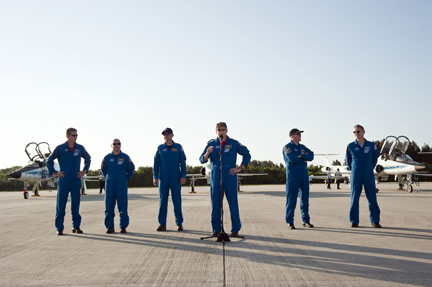
Atlantis commander Ken Ham talks to reporters at the shuttle runway
Monday. (Credit: NASA)
Forecasters are predicting a 70 percent chance of acceptable weather, with the major concern being a chance of low clouds. The forecast remains 70 percent "go" through the weekend.
"Weather is looking favorable for launch," said Kathy Winters, a shuttle forecaster. "Right now, we have a high pressure area to our northeast and an easterly flow over the area. It's a little breezy today, but the winds are going to come down over the next few days and that's going to allow us to have favorable weather for launch.
"Our only concern is sometimes when we get in this pattern we get these convergent bands of clouds and those can sometimes come over the area and cause a low-cloud ceiling. So that's our primary concern."
Going into the countdown, NASA Test Director Steve Payne said processing has gone smoothly and "our vehicle systems are in great shape."
"Atlantis, her crew and the launch team are ready to go," Payne said. "We're looking forward to a beautiful launch on Friday afternoon."
If all goes well, engineers will pump a half-million gallons of liquid oxygen and hydrogen rocket fuel into Atlantis' external tank starting at 4:55 a.m. Friday. The procedure should be complete by around 8 a.m., clearing the way for Ham and his crewmates to begin strapping in around 11 a.m.
The current launch window extends through May 18 and NASA managers say they can make four launch attempts in five days. If the shuttle is not off the ground by then, the flight would slip to June 29 because of conflicts with an upcoming Delta launch, a Russian space station mission and because of temperature constraints related to the station's orbit.
This will be the 32nd and last planned mission for Atlantis as NASA works through a final three missions before retiring the shuttle fleet. The shuttle Discovery is scheduled for launch in September, followed by a flight by Endeavour in late November or early December.
But Atlantis will be processed for launch on a possible rescue mission in case of major problems that might prevent Endeavour's crew from returning to Earth. NASA has not ruled out the possibility of actually launching Atlantis on a station resupply mission, using the last available external tank and booster set. With a reduced crew of four, a launch-on-need shuttle mission would not be required. But no such decisions have been made.
While it's not yet clear whether the current mission is, in fact, Atlantis' last, Payne said no special events have been planned to mark the occasion.
"Everybody realizes there's a lot of history going on here and that they're part of it and they're living it," Payne said. "So we're making a point of savoring the moment while we can, because this has really been a privilege for us to work out here and be associated with this program."
6:55 PM, 5/5/10, Update: NASA clears Atlantis for May 14 launch (UPDATING times for launch, docking, undocking and landing)
NASA managers Wednesday cleared the shuttle Atlantis for launch May 14 on its 32nd and final planned flight, a three-spacewalk mission to the International Space Station. The primary goals of the 132nd shuttle flight are to replace aging solar array batteries, install a backup KU-band antenna and attach a new Russian module loaded with supplies and equipment.
"We had a very thorough review today, we went through all the things that have happened on the vehicle, both the shuttle and also the station," said Bill Gerstenmaier, NASA's chief of space operations. "We're ready to go fly."
Launch is targeted for 2:20:08 p.m. EDT on May 14, roughly the moment when Earth's rotation carries launch complex 39A into the plane of the space station's orbit.
NASA's processing team at the Kennedy Space Center has one day of contingency time left in the current schedule and can make four launch attempts through May 18. If Atlantis isn't off the ground by then, the flight likely will slip to late June because of conflicts with other launches and periodic temperature issues related to the space station's orbit.
"It was a very smooth flight readiness review," said shuttle Program Manager John Shannon. "I am amazed at this team because (the shuttle) Discovery did just land 15 days ago. We're the beneficiaries of its very trouble-free mission. Atlantis has had a very trouble-free processing flow."
But Shannon said NASA managers attending an executive-level flight readiness review did go over two issues related to Discovery's flight.
Discovery's Ku-band antenna system failed shortly after launch, limiting data relay, radar operations and live video from the orbiter. After landing, the problem was traced to a specific transistor and while the same components are in place in Atlantis' Ku-band system, the odds of a similar failure two flights in a row are considered remote.
Engineers also reviewed work to better secure ceramic inserts, or plugs, that are threaded into place over bolts used to hold specific heat shield panels, window frames and other components in place. An insert worked its way loose during Discovery's re-entry, posing a potential impact threat.
Shannon said the inserts around Atlantis' windows and forward rocket pod were tested and re-installed using a thicker braided cord intended to increase friction and make it more difficult for a plug to back out.
"The tone of the meeting was extremely positive," Shannon said of the flight readiness review. "Nobody mentioned, and it wasn't purposefully avoiding it, but nobody mentioned this was Atlantis' last planned flight. Folks are so focused and doing their jobs and performing with such pride all the way to the end, it's just normal business.
"You might ask, well did you really have to go and replace all the braided cord on all these plugs which have performed pretty well in the past? And the answer is, we think we'll make it better and because it'll make it better, we're going to go do it. That's the kind of attitude this team has. Their such an asset to human spaceflight and I could not be more proud of them.
"So we're ready to go next Friday," he said. "It's 15 days since we last landed, nine days until we launch. This is the kind of pace this team thrives on."
Launch Director Mike Leinbach said the shuttle's processing was following a standard flow, with no major changes because it's Atlantis' final planned flight.
"I was just looking at the previous missions of Atlantis and reminiscing a little bit," he said after the FRR. "Yeah, she's been around a long time and a lot of us have known that ship for 25 years. So it'll be bittersweet to be sure. She's flown 31 times already, 115 million miles ... about a third of her design life.
"But our mission is coming to an end, so we're coming to grips with that. The team is very professional. We know it's the last one, probably, but that doesn't affect the way we process or launch this thing. We're going to do it safely and surely and we hope we do it next Friday."
Assuming an on-time launch, commander Ken Ham will guide Atlantis to a docking with the space station's forward port around 10:27 a.m. on Sunday, May 16.
The next day, the crew will stage the first of three spacewalks to install a spare Ku-and antenna dish, six replacement batteries for the station's oldest set of solar arrays and an equipment mounting plate for a Canadian robot arm extension.
The Atlantis astronauts also plan to install a Russian module on the Earth-facing port of the Zarya module.
The 17,400-pound mini-research module, or MRM-1, will be launched loaded with more than 3,000 pounds of NASA supplies and equipment. MRM-1 will provide better clearance between visiting Progress and Soyuz spacecraft and a NASA storage module that will be attached to the station just in front of Zarya later this year.
MRM-1 will be attached to the station on May 18, the day after the crew's first spacewalk. The next day, a second spacewalk will be staged to begin the battery replacement work. A final spacewalk is planned for May 21 to complete the battery swap outs.
If all goes well, Atlantis will undock from the station around 11:20 a.m. on May 23 and land back at the Kennedy Space Center around 8:44 a.m. on Wednesday, May 26.
"This is a very exciting mission," Shannon said. "Twelve days, three EVAs, tons of robotics, we're putting on spares that will make us feel good about the long-term sustainability of ISS, we're replacing batteries that have been up there for a while, docking a Russian-built ISS module. This flight has a little bit of everything."
NASA managers originally planned to launch the shuttle Endeavour July 29 on a mission to deliver a $1.5 billion physics experiment to the station and to close out the shuttle program with a final flight by the shuttle Discovery on Sept. 16.
But the powerful magnet at the heart of the Alpha Magnetic Spectrometer slated for launch aboard Endeavour is being replaced and NASA does not expect to launch Endeavour before late November at the earliest. If the shuttle misses a short launch window, the flight could slip to late February.
Whenever Endeavour takes off, Atlantis will be on standby for a rescue mission in case of any major problem that might prevent Endeavour's crew from safely returning to Earth.
Because an external tank and boosters will be available for the so-called "launch-on-need" mission, NASA managers have held open the possibility of launching Atlantis and a reduced crew of four on a final mission to the station next summer to deliver additional supplies and equipment.
A four-person crew could, in theory, rely on Russian Soyuz ferry craft to eventually make it home in an emergency. Whether NASA can pay for an additional mission, or win the political support that would be necessary, remains to be seen. But Gerstenmaier said Wednesday a decision one way or the other was needed by the end of June.
9:30 AM, 4/20/10, Update: Shuttle Discovery lands in Florida (UPDATED at 11:20 a.m.; crew departs runway; quotes)
The shuttle Discovery, delayed a day by cloudy Florida weather, blazed across the heartland of America Tuesday, gliding to a pinpoint landing at the Kennedy Space Center to close out an extended space station assembly mission.
Approaching the spaceport from the northwest, commander Alan Poindexter took over manual control at an altitude of 50,000 feet, guiding the shuttle through a 200-degree left turn to line up on runway 33. After giving pilot James Dutton a few moments of stick time, Poindexter flew the shuttle to a picture-perfect touchdown at 9:08:35 a.m. EDT.
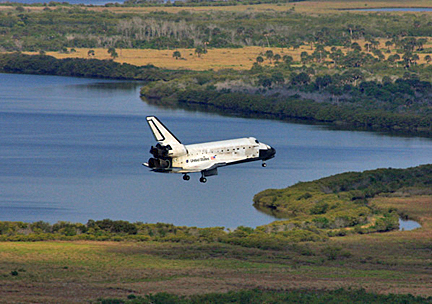
The shuttle Discovery approaches runway 33 at the Kennedy Space
Center. (Photo: Stephen Clark/Spaceflight Now)
"Wheels stopped, Houston," Poindexter radioed as Discovery rolled to a halt on the 300-foot-wide runway.
"Roger, wheels stopped, Discovery. Welcome home," called astronaut Rick Sturckow from mission control. "Dex, congratulations to you and the crew on an outstanding mission."
"Thanks for the words, it was a great mission, we enjoyed working with you and all the teams in mission control," Poindexter replied. "And we're glad the International Space Station is stocked up again. Thanks a lot."
The 131st shuttle mission covered 238 complete orbits and 6.2 million miles since blastoff April 5 for a mission duration of 15 days two hours 47 minutes and 10 seconds.
Poindexter, Dutton and their crewmates - flight engineer Dorothy Metcalf-Lindenburger, Stephanie Wilson, Japanese astronaut Naoko Yamazaki and spacewalkers Richard Mastracchio and Clayton Anderson - planned to doff their pressure suits and gather on the runway for a traditional walk-around inspection of the shuttle.
All seven astronauts plan to fly back to Houston early Wednesday after reunions with friends and family members.
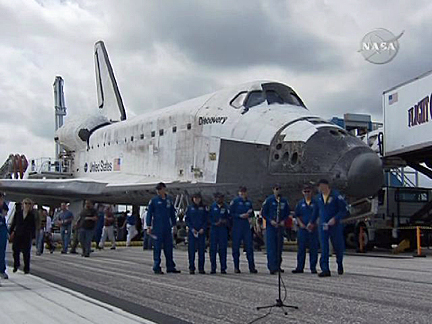
The Discovery astronauts pose in front of Discovery. (Photo: NASA TV)
Already running a day late because of low clouds at the space center Monday, the astronauts were aiming for a 7:34 a.m. landing in Florida Tuesday, but nearby showers and concern about fog prompted entry Flight Director Bryan Lunney to order a one-orbit wave off.
As the sun came up, showers moved outside NASA's 30-nautical-mile safety zone, fog was minimal and Lunney cleared Poindexter to begin a descent that gave shuttle viewers in the continental United States a rare chance to witness the fiery streak of a shuttle re-entry.
In the wake of the 2003 Columbia disaster, NASA has favored southwest-to-northeast entry trajectories that carry the shuttle above the Pacific Ocean and the Caribbean, avoiding seasonal, potentially dangerous noctilucent clouds in the northern hemisphere.
The favored trajectories also require less propellant and, while not a requirement, keep descending shuttles well away from any densely populated areas in the United States.
Discovery's return was only the second so-called "descending node" entry since 2003. NASA managers ordered the change of plans to give the astronauts more time to complete the station resupply mission and to bring in a daylight landing opportunity at the end of a long flight. The high, icy clouds that can be a concern are not an issue at this time of year.
"The neat thing about the descending opportunities is it's going to come across the country and folks will get a good opportunity, hopefully, to see the orbiter as it goes overhead," Lunney said Sunday.
Discovery plunged back into the discernible atmosphere at an altitude of about 76 miles above the central Pacific Ocean south of the Aleutian Islands at 8:36 a.m., crossing the western Canadian coast near Vancouver at an altitude of about 40 miles.
With the shuttle surrounded by superheated plasma as atmospheric friction reduced its 5-mile-per-second orbital velocity, viewers in the west with a clear sky could expect to see a "streak of white light way up high," Lunney said. "When it's down lower, it's going to be more the glowing cloud plowing through. I think both will be clearly visible" weather permitting.
With its heat shield protecting the shuttle from temperatures of up to 3,000 degrees, Discovery sailed high above Helena, Mont., just west of Casper, Wyo., and across the northeastern corner of Colorado before descending across Kansas, Oklahoma and Arkansas, passing north of Little Rock before continuing across Mississippi, Alabama and Georgia.
The shuttle crossed into Florida and then passed east of Gainesville before beginning its final approach to the Kennedy Space Center.
"It was a beautiful entry this morning," Poindexter said before leaving the runway. "We got the bonus of coming over the entire United States and it was just absolutely gorgeous. The entry track took us over the Rockies and over the midwest and across the Mississippi delta, it was just a fantastic entry.
"The landing back here at the Kennedy Space Center was really nice. It's a beautiful day, it was a great mission and we're just happy to be back here in Florida with Discovery."

Engineers service Discovery after landing. (Photo: NASA TV)
With Discovery back on the ground, engineers at the nearby Vehicle Assembly Building were readying the shuttle Atlantis for an overnight trip to launch pad 39A for liftoff May 14 on another space station assembly mission. It will be the 32nd and final planned flight for Atlantis as NASA faces the shuttle program's last three flights.
The final missions are devoted to delivering as much in the way of spare parts and supplies as possible before the shuttle fleet is retired and the station is dependent on less capable Russian, European and Japanese cargo craft.
Discovery's crew delivered more than 17,000 pounds of supplies, equipment and science gear and staged three spacewalks to replace an ammonia coolant tank o the station's main power truss. The new tank was successfully installed, but flight controllers were unable to pressurize the coolant loop because of trouble with a valve in an associated nitrogen tank.
Mission managers briefly considered asking Mastracchio and Anderson to carry out a fourth spacewalk to install a spare nitrogen tank. But after a detailed assessment, engineers concluded the coolant loop could be safely operated for at least a month without pressurization. As it now stands, the station's crew likely will stage a spacewalk later this spring to install a replacement tank.
8:10 AM, 4/20/10, Update: Discovery braking rockets fired
Flying upside down and backward, commander Alan Poindexter and pilot James Dutton fired the shuttle Discovery's twin braking rockets for two minutes and 57 seconds starting at 8:03 a.m. to begin an hourlong descent to the Kennedy Space Center. After a rare flight across the heartland of America, Poindexter plans to guide the shuttle to a landing on runway 33 at 9:08 a.m. This status report will be updated after landing or as conditions warrant.
6:20 AM, 4/20/10, Update: Shuttle entry delayed one orbit
Concerned about showers and the possible development of fog, entry Flight Director Bryan Lunney ordered the Discovery astronauts to pass up their first Florida landing opportunity Tuesday, delaying re-entry for one orbit to give forecasters more time to assess the weather in Florida and California.
Commander Alan Poindexter and his six crewmates have one more opportunity to land in Florida and three at Edwards Air Force Base in California's Mojave Desert. The second Florida opportunity and the first at Edwards come on the next orbit.
"Dex, we worked it really hard and we just can't get comfortable with the first opportunity so we're going to go ahead and wave off," astronaut Rick Sturckow radioed from mission control just after 6 a.m. EDT. "We're going to continue to look at KSC and Edwards for the next rev."
"Copy, Houston. And we understand about the wave off," Poindexter replied. "That makes sense to us."
For a landing at Edwards, the astronauts would fire Discovery's braking rockets at 7:56 a.m. EDT, setting up a landing on runway 22 at 9:01 a.m. For a landing in Florida, the braking rockets would be fired at 8:02 a.m. for a landing on runway 33 at 9:08 a.m.
The forecast for the Kennedy Space Center calls for a chance of showers within 30 nautical miles of the runway. At Edwards, the forecast is "go," but conditions are breezy with headwinds gusting to 21 knots.
3:50 AM, 4/20/10, Update: Florida forecast 'go,' but fog possible
The Discovery astronauts are working through their pre-entry checklist, rigging the shuttle for landing to close out an extended space station assembly fight. Forecasters are now predicting acceptable weather at the Kennedy Space Center, although fog is a possibility for the first of two Florida landing opportunities.
"Good news, there's a 'go' forecast at KSC," astronaut Rick Sturckow radioed from mission control around 2:30 a.m. EDT. "No precipitation concern inside of 30 miles, all the shower activity's kind of to the east of that 30-mile circle. The main concern is going to be fog. Fog is not in the forecast, but that's what we're having Fergie (astronaut Chris Ferguson) look at for the T-38 (weather assessment) flight."
"So it's going to be few (clouds) at 2,000 (feet), scattered 5,000, scattered 12,000, seven miles vis and the winds are zero-eight-zero (at) four, peak six knots," Sturckow said. "So that's all good news. We'll keep an eye on the fog for the first opportunity."
"We understand, Houston, thanks a lot," commander Alan Poindexter replied from Discovery. "That sounds like a great forecast."
Discovery's crew has two landing opportunities at Kennedy and three at Edwards:
ORBIT...SITE..DEORBIT BURN..LANDING 237.....KSC...06:28:50 AM...07:34:08 AM 238.....EDW...07:56:29 AM...09:01:17 AM ........KSC...08:02:59 AM...09:08:37 AM 239.....EDW...09:30:59 AM...10:35:57 AM 240.....EDW...11:05:39 AM...12:11:06 AM
Sturckow said NASA's backup landing site at Edwards Air Force Base, Calif., also expects good, if breezy, weather "however, later today the wind's going to go up to about 40 knots out there. So we're looking at all this and we'll have more words as we work through the checklist."
"Thanks a lot, Houston, we know you guys are working hard on it," Poindexter said. "We appreciate it."
Updating the crew at 3:40 a.m., Sturckow said Ferguson had "flown around pretty much all over and he didn't see any signs of concern. A little farther away from the SLF (Shuttle Landing Facility), like in Orlando, the vis is down pretty low, so there's fog in the neighborhood and we've just got to keep watching it."
Detailed entry timelines and ground-track charts are posted on the CBS News STS-132 Quick-Look page:
http://www.cbsnews.com/network/news/space/currentglance.html#ENTRY
9:20 AM, 5/12/10, Update: Mission preview
The shuttle Atlantis is poised for launch Friday on its 32nd and final planned mission, a three-spacewalk flight to the International Space Station to install a new Russian module, a backup Ku-band dish antenna and six massive batteries to replace aging power packs in one of the station's solar arrays.
The shuttle's six-man, all-veteran crew also will deliver needed supplies and equipment as NASA stages its final three shuttle missions to complete the assembly of the lab complex by late this year or early next.
"Twelve days, three EVAs, tons of robotics, we're putting on spares that will make us feel good about the long-term sustainability of ISS, we're replacing batteries that have been up there for a while, docking a Russian-built ISS module," said shuttle Program Manager John Shannon. "This flight has a little bit of everything.
On board for the 132nd shuttle mission will be commander Kenneth T. Ham, pilot Dominic A. Antonelli, flight engineer Michael T. Good, Stephen G. Bowen, Piers J. Sellers and Garrett E. Reisman, who spent three months aboard the space station in 2008.
Reisman, Good and Bowen will work in two-man teams for three planned spacewalks to install the backup antenna, the solar array batteries and other equipment. Sellers, who will operate the station's robot arm during the spacewalks, will assist Reisman on the arm during installation of the Russian mini-research module, or MRM-1, on the fifth day of the mission.
The 17,760-pound MRM-1, also known as "Rassvet," is packed with 3,086 pounds of NASA equipment and supplies and carrying an experiment airlock and European robot arm equipment that will be attached to other modules later. Docked to the Earth-facing port of the central Zarya module, MRM-1 will bring additional pressurized volume for research and stowage and provide needed clearance between the forward Russian docking port and a U.S. storage module scheduled for attachment later this year.
The Russian module's docking system is virtually identical to the systems used by Progress and Soyuz spacecraft that dock with considerably more force than NASA typically employs. The station's robot arm cannot match that docking force, but by precisely centering the docking mechanisms, engineers are confident the Canadian space crane can get the job done.
"This module was originally designed to fly up, like all the other Russian modules, and dock under its own power, autonomously," Reisman said. "The way they do that is they have big cone (on one module) and a big probe (on the other), they get a good running start and it's almost like bringing train cars together. I was inside the station a couple of times when dockings occurred and you can feel her come in. It's definitely an event.
"What we're trying to do here is very different. ... They call it 'mini' but like many things, it's actually very big," said Reisman, who stands 5 feet 4 inches tall and is jokingly known as "Big G." "To have it on the very end of the arm, with the arm fully extended, there are a lot of dynamics at play. So the arm can't get the kind of ramming speed it normally develops under its nominal means of docking. So we're going to be restricted to coming in approximately five times slower, and that's the fastest the arm can do safely.
"What we hope to do is have very fine control and have it come right down the middle. There are a lot of people who have worked really hard, did a lot of analysis to verify this is going to work. But the exciting thing is it's never been done before and so I'm sure we'll all be watching very carefully as we bring that in on flight day five."
Ham will be watching very carefully indeed. Making his first flight as a shuttle commander, he said "I hope that I'm the only person who's a little concerned about it, but I have to be, it's my job to worry."
"I think everything's going to work out just fine," he told CBS News. "But with any 'first' that you do, and this is the test pilot speaking, you've got to wonder about what is it that hasn't been thought about yet. And there are potentials in this scenario trying to get this on there with the arm. That makes it different."
MRM-1 complexities aside, the timelines for all three spacewalks are extremely tight and the excursions must be conducted in serial fashion.
During the first spacewalk on flight day four, Reisman and Bowen plan to install the backup Ku-band dish antenna atop an 8-foot-tall mast and mount an equipment support platform on a Canadian robot arm extension. During the second spacewalk, Bowen and Good will begin work to replace six 365-pound nickel-hydrogen batteries on the far left end of the station's main power truss.
"These aren't double As," Good said. "One of my brothers likes to give me a hard time about flying up in space and changing batteries, he thinks this is not a very difficult task, not a big deal. But these are like 400-pound nickel-hydrogen batteries, they're the size of a big suitcase, probably bigger than the airlines would let you take on without charging you extra. And they're pretty tricky. ... The alignment and the tolerances are very tight."
Again, the robot arm will be fully extended to position the battery pallet near the work site while Bowen and Good, and then Good and Reisman, swap out the batteries using new spacesuit gear specially modified to minimize the risk of electric shocks.
"EVA-1 is packed," Ham said. "Any little thing that goes wrong will slow the rest of the EVA down and it puts us in a very vulnerable spot. ... I don't want this to sound the wrong way, but it is a house of cards. if you don't get all the cards to line up just right, then all the EVAs fall apart. I trust these guys, they're awesome, they're great. But there are aspects of it that are mechanical that they cannot foresee or counter when they go wrong."
Launch from pad 39A at the Kennedy Space Center is targeted for 2:20:08 p.m. EDT, roughly the moment Earth's rotation carries the firing stand into the plane of the space station's orbit. If all goes well, Ham will guide the shuttle to a docking with the space station's forward port around 10:27 a.m. on Sunday, May 16.
The next day, Reisman and Bowen will stage the first spacewalk, followed by installation of MRM-1. The second spacewalk is targeted for May 19 with the third on May 21. Atlantis is scheduled to undock from the station around 11:20 a.m. on May 23, setting up a landing back at the Kennedy Space Center around 8:44 a.m. on Wednesday, May 26.
FINAL PLANNED FLIGHT FOR ATLANTIS
This will be Atlantis' final planned mission before the shuttle fleet is retired at the end of the year.
As of this writing, NASA plans to launch the shuttle Discovery on its final flight around Sept. 16 to deliver more supplies and equipment to the space station, along with a cargo module that is being modified to remain permanently attached to the lab.
The shuttle Endeavour is slated to close out the program in late November, delivering a $1.5 billion physics experiment to the station. Endeavour's flight could end up slipping to late February because of conflicts with other station missions and temperature constraints related to the station's orbit. NASA managers say they can stretch shuttle funding to late February if necessary without any additional appropriations from Congress.
As with all post-Columbia missions, NASA will be prepared to launch a shuttle rescue mission in case of any major problems that might prevent a crew from safely returning to Earth. For the final mission in November, Atlantis is the launch-on-need shuttle and it will be processed for flight as if it will actually fly.
And it just might get a "last hurrah," as veteran astronaut Jerry Ross put it during a recent news conference.
NASA managers are holding out hope they can win approval to launch Atlantis next spring or summer on what would really be the shuttle program's final mission, a flight to deliver a final load of supplies and critical equipment to the station. By launching Atlantis with a crew of four, NASA could avoid the need for a launch-on-need mission, using the space station as a safe haven until the crew could be rotated home aboard Russian Soyuz spacecraft.
Because of the projected multi-year gap between the shuttle's retirement and the debut of commercial rockets and cargo ships needed to replace it, NASA managers want to take advantage of every possible shuttle launch opportunity to stock the lab with supplies. One shuttle launch can carry the equivalent of multiple Russian, European and Japanese cargo flights.
While it is not yet clear whether Atlantis will get another flight - a decision is needed by the end of June or thereabouts - engineers have been marking the shuttle's processing milestones as if the current mission is, in fact, its last.
"I would liken it to the final season of a champion athlete," said Mike Sarafin, lead shuttle flight director for STS-132. "When a champion athlete announces their retirement, folks show up in large numbers to show their respect for that athlete. And we're seeing that right now with the space shuttle program, we're seeing a lot of interest from the public showing up for not only the launches, but also the other events, the rollout from the VAB to the launch pad, the landings. It's just an increase and an upswell in public interest and public support.
"That doesn't take away from the fact that we need to retire the space shuttle program. We are in the ninth inning. There is a possibility we'll have a launch-on-need flight, STS-135. Atlantis may go into extra innings, we don't know. We'll see how all that plays out."
Whatever the outcome, "she's been around a long time and a lot of us have known that ship for 25 years," said Launch Director Michael Leinbach. "So it'll be bittersweet to be sure."
"She's flown 31 times already, 115 million miles ... about a third of her design life," he said. "But our mission is coming to an end, so we're coming to grips with that. The team is very professional. We know it's the last one, probably, but that doesn't affect the way we process or launch this thing. We're going to do it safely and surely and we hope we do it next Friday."
ASTRONAUTS FACE TIGHT TIMELINE, CHALLENGING SPACEWALKS
As with all post-Columbia missions, the Atlantis astronauts will spend the second day of the mission carrying out an extensive inspection of the shuttle's reinforced carbon carbon nose cap and wing leading-edge panels, which experience the most extreme heating during re-entry, to make sure nothing was damaged during the climb to space.
Engineers on the ground, meanwhile, will be assessing launch-day video and still imagery, including footage from a camera mounted on the external tank, to look for any signs of foam insulation that might have come off, posing an impact threat.
On the third day of the mission, Ham will guide Atlantis to a point about 600 feet directly below the lab complex before executing a 360-degree back-flip maneuver to expose the shuttle's heat shield tiles to the station. Expedition 23 commander Oleg Kotov and flight engineer Timothy Creamer will photograph Atlantis' belly using digital cameras with powerful telephoto lenses to look for any signs of damage.
With the rendezvous pitch maneuver, or RPM, complete, Ham plans to guide Atlantis up to a point directly in front of the station before moving in for a docking with pressurized mating adaptor No. 2 on the front of the Harmony module.
"Rendezvous day is a great day," Ham said in a NASA interview. "I am really looking forward to that one, not just because I get to fly the orbiter this time. That first time, you get really busy in the cockpit during the rendezvous. There's a whole bunch of stuff you need to get done and at some point in there you actually look out the window when you're close, and you see this monstrosity that is out there orbiting the planet.
"There's that moment of 'Holy cow! What has humanity built up here?' It is amazing, and I'm looking forward to that because the station's even bigger than it was last time I was there, and it's just a neat thing to look at. ItŐs a reality check."
Waiting to welcome Ham and his crewmates aboard will be Kotov, Creamer, Soichi Noguchi, Tracy Caldwell Dyson, Alexander Skvortsov and Mikhail Kornienko. Kotov, Creamer and Noguchi are scheduled to return to Earth aboard the Soyuz TMA-17 spacecraft on June 1. They will be replaced by Douglas Wheelock, Shannon Walker and Fyodor Yurchikhin, who are scheduled for launch aboard Soyuz TMA-19 on June 15.
After a brief welcome aboard, the Atlantis astronauts will get to work. The first item on the agenda is for Sellers and Caldwell Dyson, operating the station's robot arm, to pull a pallet carrying the new high-gain antenna and solar array battery packs out of the shuttle's cargo bay. The pallet, called the integrated cargo carrier, or ICC, will be temporarily mounted on an attachment fitting at the base of a cart that moves the robot arm from point to point on the front of the solar power truss.
At the end of the day, Reisman and Bowen will "camp out" in the station's Quest airlock module at a reduced pressure of 10.2 pounds per square inch to help purge nitrogen from their bloodstreams. That will help prevent the bends when the astronauts spend the day working in NASA's 5-psi spacesuits.
"This mission is all rush, rush, rush," Reisman said. "It's going to be action packed. It was originally designed for one of the missions that has the capability to get power from the space station, so those vehicles can stay longer. We have the same content, the same mission to accomplish, but less time to do it in because Atlantis can't get power from the space station.
"So we're going to do our first spacewalk the day after we get there. We're going to arrive at the space station, we'll go inside for the first time then bam, we go inside the airlock, lock myself in with Steve and start doing our campout."
COMPLEX SPACEWALKS ON TAP
For the first spacewalk, Bowen, call sign EV-1, will be wearing a suit with red stripes around the legs. Reisman, EV-2, will be wearing an unmarked suit.
After exiting the airlock, the spacewalkers will make their way to the cargo pallet and install foot restraints, one on the pallet itself and one of the robot arm. The eight-foot-long boom that will support the spare antenna will be removed from the pallet, and Reisman, riding on the end of the robot arm, will carry it to the Z1 truss atop the station's central Unity module.
The spacewalkers then will secure the boom with two bolts. While Bowen is making electrical connections, Reisman will ride the arm in a windshield wiper-like trajectory back to the cargo pallet to pick up the six-foot-wide Ku-band antenna.
"The dish is pretty fragile and we're instructed not to bump that into anything," Reisman said. "Piers is going to be operating the big arm, and I'll be standing on the end of it while we bring the dish out. At that point, the dish comes very close to the boom of the arm.
"The worrisome thing for me is I can't really see it because I have a big face full of dish, and the boom is on the other side. So I'll be counting on Piers to talk me through it and give me nice calls. We'll have to coordinate very carefully. It's definitely an area of concern."
Reisman, holding the dish, will follow another windshield wiper trajectory back to the top of the Z1 truss where Bowen will help move it into position before driving four bolts to hold it in place and hooking up two electrical connectors.
After installing insulation around the base of the antenna, Reisman will ride the arm back to the cargo pallet to retrieve an equipment stowage platform that will be attached to the Canadian special purpose dexterous manipulator, or SPDM, robot arm extension. The platform will be used down the road to temporarily hold components that are being replaced by the space crane.
Once the platform is in place the astronauts will turn their attention to a get-ahead task if time is available, loosening the bolts holding the new batteries to the cargo pallet.
"While the pallet's based on the truss there, we can actually break all the torque on the bolts with a ratchet wrench instead of using this heavy torque multiplier," Reisman said. "Just like lug nuts on your car, we can do it very quickly."
Bowen said the key to the first spacewalk is "a very intricate choreography."
"And the reason for that is using the arm to remove the pieces off the pallet and then taking them all over station to install them. ... I get to climb all over, he gets to fly all over. But the choreography is key to EVA-1. If the choreography works and the timing works out and we complete all the tasks on EVA-1, we will be well set up for EVA-2.
"Everything has to work," he said. "Any one of these EVAs, a single bolt can put everything behind. So we have to be very efficient and hopefully get through our tasks in a very nominal timeframe so the next piece is ready to go."
With the first spacewalk out of the way, the astronauts will work the next day to install MRM-1, one of the more challenging robot arm tasks yet attempted by a station assembly crew.
There are two aspects to the docking procedure that are unusual, at least from NASA's perspective.
First, the module will be mated at a much lower velocity - five times slower - than typically used by Russian Progress and Soyuz spacecraft.
Second, commanding to the active side of the docking mechanism, inside the MRM-1 module, will be routed from a laptop computer in the U.S. segment of the station to a Russian central computer and then back through an ethernet link to the station's robot arm. Signals will move down the arm, through an electrically powered grapple fixture on the hull of the new module and then to an internal Russian computer.
On the positive side, Reisman and Sellers will be operating the arm and sending computer commands from the station's new multi-window cupola observation deck attached to the Tranquility module. Up until this point, the arm was operated from inside the Destiny lab module, using indirect television views to provide operators with views of various work sites.
For the MRM-1 installation, the arm will be operated from inside the cupola, giving Reisman and Sellers a direct view of the module and the Russian docking port where it will be installed.
"This is going to be something," Sellers said. "Because up to now, the operators of the arm have never seen it, they've only watched it all on their TV screens. This is going to be kind of a first in that I'll be able to look out the window and see what I'm doing directly. Not all the time, but some of the time.
"I think it makes a huge difference. Seeing it with your own eyes and being able to scan left and right and see the whole length of the arm makes a big difference. With TV, you can pan it this way, tilt it up a bit in order to look around. But somehow, to be able to see something with your own eyes, move your head around and look at it, seems to make a better model inside your head of whatever it is you're looking at. We're not looking at the toenail of the elephant here, we're seeing the whole elephant."
The direct view will help, but first, commanding through the Russian computer system must work properly.
"Getting data, power, communications, all of that is going through the arm," said station Flight Director Emily Nelson. "But the control goes from a laptop at the cupola robotic work station that Piers will be running that's connected through our ethernet connections on board all the way back to the Russian central computer and then comes back through the same ethernet connections, through the arm and into MRM-1. So all of that data's going through a pretty long path to get to where it's headed, which is new and different.
"Also, and I don't know how many of you have watched Progress and Soyuz dockings, but those vehicles don't come in slowly, they come in with quite a bit of force. There's a great deal of spring force in the probe head of the docking probe that has to be overcome, so we've also worked hard to ensure we've got the right rates on the arm, that the arm has sufficient rates to overcome those spring forces so that we can actually get the docking probe into the docking cone for the first physical mate."
The Russian docking system was designed to be tolerant of alignment errors. The approaching spacecraft's docking system features a long probe designed to fit into a cone-shaped receptacle on the target docking port. Once the probe is captured, hooks and latches are activated to firmly pull the two modules together.
"One of the reasons it's designed to bang together is then you can have tremendous errors in your alignment," Reisman said. "The receiving end is shaped like a cone. If you hit the side, with that momentum, the (probe) will just slide down the cone and end up in the hole."
The astronauts jokingly call themselves the "Rassvet rammers." But the station's robot arm cannot drive MRM-1's probe into the docking cone on the Zarya module with the same amount of force. It makes up for that with high precision.
"Even though we're coming in five times slower, if we come in five times more accurately - which puts a lot of pressure on me! - (it will work)," Reisman said.
Ham and Antonelli, operating Atlantis' robot arm, will pull MRM-1 from the shuttle's cargo bay and hand it off to the station arm, operated by Reisman. He then will maneuver it into position and attempt a docking.
"The first time, we're just going to go at ramming speed and try to bring her down as close to the center as possible," Reisman said. "That's basically the idea, to try to mimic what it is designed to do, which is go in as fast as possible. If that doesn't work, we have a couple of different options."
One such option involves disabling software that compares what the arm operator is commanding and what the arm is actually doing, automatically correcting for misalignments.
"Sometimes when you're up against structure that can actually get you into a little bit of a force fight," Reisman said. "So what we'll do the second time if it doesn't work when it's on, we're going to turn that algorithm off for the second attempt. And then finally, we'll come in at a slower speed but hopefully with a more fine alignment and hopefully some combination of those attempts will do the trick."
The module cannot be left at the station if the docking systems fail to properly engage. In that case, MRM-1 would be returned to the shuttle's cargo bay for return to Earth. But mission managers are confident it won't come to that.
Assuming a successful docking, the station crew will be in no rush to open MRM-1 and begin unloading the NASA supplies and equipment that are stored inside. Because of the tight timeline for the Atlantis astronauts, that work is planned for after the shuttle departs.
The day after MRM-1 is installed - flight day six - Bowen and Good (EV-3), wearing an unmarked spacesuit, plan to stage a six-and-a-half-hour spacewalk to begin replacing the batteries on the P6 solar array at the far left end of the station's power truss. The batteries are charged during daylight and provide the station's electrical power during orbital darkness.
The P6 array, one of four attached to the station's main truss, was launched in November 2000. Six of its batteries were replaced during a shuttle flight in July 2009 and the other six, well past their 6.5-year design life, will be replaced during Atlantis' mission.
The new batteries will be carried aloft attached to the integrated cargo carrier. In another challenging bit of robotics, Sellers will extend the station's robot arm to its maximum length to get the pallet as close as possible to the P6 array.
"This whole battery R & R is like a shell game, or one of those puzzles where you move the numbers around," said Lisa Shore, the lead spacewalk officer for Atlantis' mission. "The first thing you need to do is create an open spot to start the shuffle. So we'll install some handling aids onto the first battery we intend to remove. We're also going to install a ball stack, it's a metal tether that can be rigidized to temporarily stow the battery during the EVAs."
Good will be responsible for removing batteries from the truss and installing their replacements while Bowen moves batteries to and from the cargo carrier. After the first battery is removed from P6 and mounted on the ball stack, Bowen will pull a replacement battery from the cargo carrier. Both astronauts will carefully maneuver the massive power pack into place, taking special care not to damage fragile cooling fins on the back side.
Once the new battery is in place and electrically connected, the astronauts will move the old battery from its temporary mounting point and install it in the cargo carrier for return to Earth. That process will continue until at least three and possibly four batteries are installed. The remainder will be installed during the third and final spacewalk on flight day eight.
"It's all about batteries," Good said. "We're doing six of them on this flight and I get to do them all, with Steve on one EVA and Garret on the other. We've got to get them all done. They come up on a pallet in the shuttle's payload bay, the arm gets them out there to the very end of the truss on the space station, out there amongst the solar arrays. And that's probably got my biggest concern spacewalking wise, just getting through those batteries."
Lessons learned during the 2009 battery replacement work will be applied, but Good said problems are not unexpected.
"They got through them all, but they had a lot of curve balls thrown at them," Good said. "The batteries are out there on this pallet, and they're on the end of the arm, and it's stretched out as far as it can go to get them out there, just to get them close. It can't actually get them all the way out to where we're going to be installing them. So we're going to take them off the pallet, shepherd them over to where they're going to go in and out of the truss, and it's kind of tricky to get them in and out."
Each battery is held in place by two bolts and "it seems like it would be pretty simple just to put them in and screw two bolts in," Good said. "But they go in on these posts, and they have to align just perfectly, and you have to overcome a soft dock to get them set in there before you can drive the bolts. And if you don't get it all the way in there just right, you could drive that bolt all you want, but you'd never catch a thread to make it draw into the slot where it goes. So there's going to be some work there."
Said Bowen: "Once again, a single stuck bolt, something slightly misaligned (can cause problems). ... It's a very delicate task. Hopefully we'll learn from the first one we do, we'll get into a groove and just be able to work our way through each of the batteries. How many batteries we get done on EVA-2 really sets up EVA-3."
Assuming the battery work goes well, the integrated cargo carrier, loaded with six old batteries, will be returned to Atlantis' payload bay the day after the third spacewalk, and the crew will enjoy a half day of off-duty time, the second rest period built into the crew's flight plan. The next day, flight day 10, the combined shuttle-station crews will hold a joint news conference before sharing a final meal together.
After a brief farewell ceremony, the Atlantis astronauts will return to the shuttle, hatches will be closed, and Atlantis will undock. In keeping with shuttle tradition, Antonelli will oversee the undocking and a 360-degree photo-documentation fly around before departing the area for good.
The astronauts will carry out a final heat shield inspection on flight day 11 to make sure the carbon composite nose cap and wing leading edge panels have not experienced any orbital debris impacts since the flight-day-two inspection. Assuming no problems are found, the crew will test Atlantis' re-entry systems the next day and land back at the Kennedy Space Center around 8:44 a.m. on Wednesday, May 26.
With Atlantis' landing, only two shuttle flights will remain.
"I think the space shuttle, as a machine, is the single most incredible machine humanity has ever built," Ham reflected. "Space station might be right up there with it, but it is an incredible machine. The fact of the matter is, if we want to use our national assets to do space exploration beyond low-Earth orbit, you can't do that in a space shuttle. So there's the logical side of all of us that realizes the program has to come to an end at some point. And it is an honor and a privilege for us to represent being part of that crew at the end."
10:00 AM, 5/12/10, Update: Soyuz capsule moved to different port, clearing way for Atlantis module (UPDATED at 12:10 p.m. with Mission Management Team meeting; shuttle countdown update)
Space station commander Oleg Kotov, Soichi Noguchi and Timothy Creamer strapped into a Russian Soyuz capsule Wednesday, undocked and flew the spacecraft to a different port, clearing the way for attachment of a new Russian module scheduled for launch Friday aboard the shuttle Atlantis.
NASA's Mission Management Team, meanwhile, met to review the shuttle's processing for launch Friday at 2:20 p.m. EDT, but with no technical problems of any significance at pad 39A, the meeting was unusually short.
"We really had nothing to talk about," said Mike Moses, MMT chairman and director of shuttle integration at the Kennedy Space Center. "In fact, I stretched the meeting out to 18 minutes long today. It was a challenge! ... Everything's looking great, the vehicle's in great shape out at the pad."
Launch Director Mike Leinbach agreed, saying "the countdown's going exceedingly well, we're not tracking any issues right now at all that would prevent an on-time liftoff Friday."
"Team Atlantis is really hitting its stride right now, we're clicking on all eight cylinders," he said. "No issues at the launch pad."
The forecast for Friday, Saturday and Sunday calls for a 70 percent chance of acceptable weather with the primary concern being a chance for low clouds that might violate NASA's flight rules.
The launch window extends through May 18. If Atlantis is not off the ground by then, the flight will slip to June 29 because of conflicts with other launches and temperature constraints related to the space station's orbit.
To prepare the International Space Station for Atlantis' upcoming visit, the Soyuz TMA-17 spacecraft undocked from the central Zarya module's Earth-facing port at 9:26 a.m. EDT. After backing a short distance away, Soyuz commander Kotov, in the crew cabin's center seat, guided the craft to the back of the station for a docking at the Zvezda command module's aft port at 9:53 a.m.
Monitoring the fly-around from inside the station were Alexander Skvortsov, Mikhail Kornienko and Tracy Caldwell Dyson.

The view of the space station from the Soyuz TMA-17 spacecraft
during a move to the Zvezda command module's aft port.
(Photo: NASA TV)
The Soyuz move was required to clear the way for attachment of a new Russian module known as Rassvet that will be delivered to the space station aboard Atlantis. Using the station's robot arm, the astronauts plan to connect the new module to Zarya's now-vacant nadir port two days after docking.
Rassvet, also known as mini-research module No. 1, will provide additional pressurized volume for storage and research as well as additional clearance between the forward docking port of the Russian segment of the station and a U.S. storage module scheduled for attachment during a shuttle mission this fall.
05:00 PM, 5/11/10, Update: Countdown begins; weather 70 percent 'go' for Friday launch
The countdown began Tuesday for launch of the shuttle Atlantis Friday on its 32nd and final mission, a 12-day three-spacewalk flight to deliver a Russian module and fresh solar array batteries to the International Space Station.
The countdown began on time at 4 p.m. EDT, setting the stage for a launch attempt at 2:20:08 p.m. Friday, roughly the moment Earth's rotation carries launch pad 39A into the plane of the space station's orbit.
Commander Kenneth Ham and his crewmates - pilot Dominic Antonelli, flight engineer Michael Good, Stephen Bowen, Piers Sellers and Garrett Reisman - flew to the Kennedy Space Center Monday afternoon to begin final preparations.
"We are ready to launch," Ham said from the shuttle runway. "We've completed every bit of training we can and we're confident. We appreciate all the hard work from the (Atlantis) team down here, they've done an amazing job getting the vehicle turned around, on the pad and ready to go. From absolutely every report I've read, the airplane, the spaceship is ready to go. And we're ready to fly! So look for a good show on Friday."

Atlantis commander Ken Ham talks to reporters at the shuttle runway
Monday. (Credit: NASA)
Forecasters are predicting a 70 percent chance of acceptable weather, with the major concern being a chance of low clouds. The forecast remains 70 percent "go" through the weekend.
"Weather is looking favorable for launch," said Kathy Winters, a shuttle forecaster. "Right now, we have a high pressure area to our northeast and an easterly flow over the area. It's a little breezy today, but the winds are going to come down over the next few days and that's going to allow us to have favorable weather for launch.
"Our only concern is sometimes when we get in this pattern we get these convergent bands of clouds and those can sometimes come over the area and cause a low-cloud ceiling. So that's our primary concern."
Going into the countdown, NASA Test Director Steve Payne said processing has gone smoothly and "our vehicle systems are in great shape."
"Atlantis, her crew and the launch team are ready to go," Payne said. "We're looking forward to a beautiful launch on Friday afternoon."
If all goes well, engineers will pump a half-million gallons of liquid oxygen and hydrogen rocket fuel into Atlantis' external tank starting at 4:55 a.m. Friday. The procedure should be complete by around 8 a.m., clearing the way for Ham and his crewmates to begin strapping in around 11 a.m.
The current launch window extends through May 18 and NASA managers say they can make four launch attempts in five days. If the shuttle is not off the ground by then, the flight would slip to June 29 because of conflicts with an upcoming Delta launch, a Russian space station mission and because of temperature constraints related to the station's orbit.
This will be the 32nd and last planned mission for Atlantis as NASA works through a final three missions before retiring the shuttle fleet. The shuttle Discovery is scheduled for launch in September, followed by a flight by Endeavour in late November or early December.
But Atlantis will be processed for launch on a possible rescue mission in case of major problems that might prevent Endeavour's crew from returning to Earth. NASA has not ruled out the possibility of actually launching Atlantis on a station resupply mission, using the last available external tank and booster set. With a reduced crew of four, a launch-on-need shuttle mission would not be required. But no such decisions have been made.
While it's not yet clear whether the current mission is, in fact, Atlantis' last, Payne said no special events have been planned to mark the occasion.
"Everybody realizes there's a lot of history going on here and that they're part of it and they're living it," Payne said. "So we're making a point of savoring the moment while we can, because this has really been a privilege for us to work out here and be associated with this program."
6:55 PM, 5/5/10, Update: NASA clears Atlantis for May 14 launch (UPDATING times for launch, docking, undocking and landing)
NASA managers Wednesday cleared the shuttle Atlantis for launch May 14 on its 32nd and final planned flight, a three-spacewalk mission to the International Space Station. The primary goals of the 132nd shuttle flight are to replace aging solar array batteries, install a backup KU-band antenna and attach a new Russian module loaded with supplies and equipment.
"We had a very thorough review today, we went through all the things that have happened on the vehicle, both the shuttle and also the station," said Bill Gerstenmaier, NASA's chief of space operations. "We're ready to go fly."
Launch is targeted for 2:20:08 p.m. EDT on May 14, roughly the moment when Earth's rotation carries launch complex 39A into the plane of the space station's orbit.
NASA's processing team at the Kennedy Space Center has one day of contingency time left in the current schedule and can make four launch attempts through May 18. If Atlantis isn't off the ground by then, the flight likely will slip to late June because of conflicts with other launches and periodic temperature issues related to the space station's orbit.
"It was a very smooth flight readiness review," said shuttle Program Manager John Shannon. "I am amazed at this team because (the shuttle) Discovery did just land 15 days ago. We're the beneficiaries of its very trouble-free mission. Atlantis has had a very trouble-free processing flow."
But Shannon said NASA managers attending an executive-level flight readiness review did go over two issues related to Discovery's flight.
Discovery's Ku-band antenna system failed shortly after launch, limiting data relay, radar operations and live video from the orbiter. After landing, the problem was traced to a specific transistor and while the same components are in place in Atlantis' Ku-band system, the odds of a similar failure two flights in a row are considered remote.
Engineers also reviewed work to better secure ceramic inserts, or plugs, that are threaded into place over bolts used to hold specific heat shield panels, window frames and other components in place. An insert worked its way loose during Discovery's re-entry, posing a potential impact threat.
Shannon said the inserts around Atlantis' windows and forward rocket pod were tested and re-installed using a thicker braided cord intended to increase friction and make it more difficult for a plug to back out.
"The tone of the meeting was extremely positive," Shannon said of the flight readiness review. "Nobody mentioned, and it wasn't purposefully avoiding it, but nobody mentioned this was Atlantis' last planned flight. Folks are so focused and doing their jobs and performing with such pride all the way to the end, it's just normal business.
"You might ask, well did you really have to go and replace all the braided cord on all these plugs which have performed pretty well in the past? And the answer is, we think we'll make it better and because it'll make it better, we're going to go do it. That's the kind of attitude this team has. Their such an asset to human spaceflight and I could not be more proud of them.
"So we're ready to go next Friday," he said. "It's 15 days since we last landed, nine days until we launch. This is the kind of pace this team thrives on."
Launch Director Mike Leinbach said the shuttle's processing was following a standard flow, with no major changes because it's Atlantis' final planned flight.
"I was just looking at the previous missions of Atlantis and reminiscing a little bit," he said after the FRR. "Yeah, she's been around a long time and a lot of us have known that ship for 25 years. So it'll be bittersweet to be sure. She's flown 31 times already, 115 million miles ... about a third of her design life.
"But our mission is coming to an end, so we're coming to grips with that. The team is very professional. We know it's the last one, probably, but that doesn't affect the way we process or launch this thing. We're going to do it safely and surely and we hope we do it next Friday."
Assuming an on-time launch, commander Ken Ham will guide Atlantis to a docking with the space station's forward port around 10:27 a.m. on Sunday, May 16.
The next day, the crew will stage the first of three spacewalks to install a spare Ku-and antenna dish, six replacement batteries for the station's oldest set of solar arrays and an equipment mounting plate for a Canadian robot arm extension.
The Atlantis astronauts also plan to install a Russian module on the Earth-facing port of the Zarya module.
The 17,400-pound mini-research module, or MRM-1, will be launched loaded with more than 3,000 pounds of NASA supplies and equipment. MRM-1 will provide better clearance between visiting Progress and Soyuz spacecraft and a NASA storage module that will be attached to the station just in front of Zarya later this year.
MRM-1 will be attached to the station on May 18, the day after the crew's first spacewalk. The next day, a second spacewalk will be staged to begin the battery replacement work. A final spacewalk is planned for May 21 to complete the battery swap outs.
If all goes well, Atlantis will undock from the station around 11:20 a.m. on May 23 and land back at the Kennedy Space Center around 8:44 a.m. on Wednesday, May 26.
"This is a very exciting mission," Shannon said. "Twelve days, three EVAs, tons of robotics, we're putting on spares that will make us feel good about the long-term sustainability of ISS, we're replacing batteries that have been up there for a while, docking a Russian-built ISS module. This flight has a little bit of everything."
NASA managers originally planned to launch the shuttle Endeavour July 29 on a mission to deliver a $1.5 billion physics experiment to the station and to close out the shuttle program with a final flight by the shuttle Discovery on Sept. 16.
But the powerful magnet at the heart of the Alpha Magnetic Spectrometer slated for launch aboard Endeavour is being replaced and NASA does not expect to launch Endeavour before late November at the earliest. If the shuttle misses a short launch window, the flight could slip to late February.
Whenever Endeavour takes off, Atlantis will be on standby for a rescue mission in case of any major problem that might prevent Endeavour's crew from safely returning to Earth.
Because an external tank and boosters will be available for the so-called "launch-on-need" mission, NASA managers have held open the possibility of launching Atlantis and a reduced crew of four on a final mission to the station next summer to deliver additional supplies and equipment.
A four-person crew could, in theory, rely on Russian Soyuz ferry craft to eventually make it home in an emergency. Whether NASA can pay for an additional mission, or win the political support that would be necessary, remains to be seen. But Gerstenmaier said Wednesday a decision one way or the other was needed by the end of June.